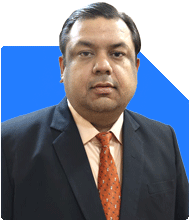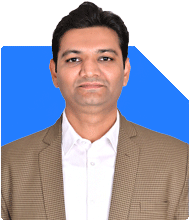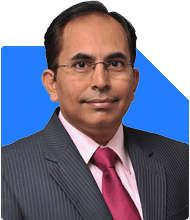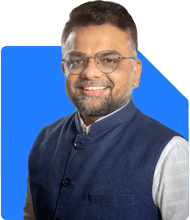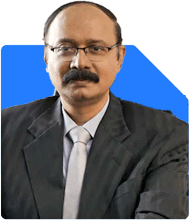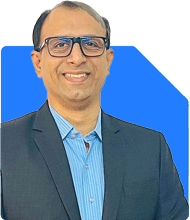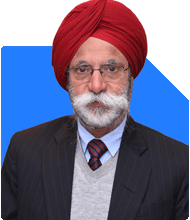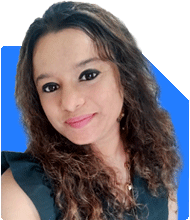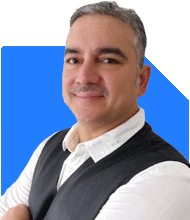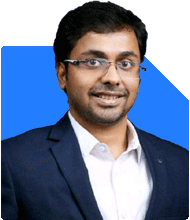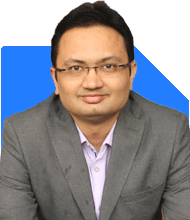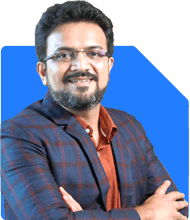विशेषज्ञ की सलाह चाहिए?हमारे गुरु मदद कर सकते हैं
Purshotam Lal |73 Answers |Ask -Follow
Financial Planner, MF and Insurance Expert - Answered on Dec 24, 2025

पुरषोत्तम, सीएफपी®, एमबीए, सीएआईआईबी, एफआईआई
प्रमाणित वित्तीय योजनाकार
बीमा सलाहकार
www.finphoenixinvest.com
Purshotam Lal |73 Answers |Ask -Follow
Financial Planner, MF and Insurance Expert - Answered on Dec 24, 2025

पुरषोत्तम, सीएफपी®, एमबीए, सीएआईआईबी, एफआईआई
प्रमाणित वित्तीय योजनाकार
बीमा सलाहकार
www.finphoenixinvest.com
Purshotam Lal |73 Answers |Ask -Follow
Financial Planner, MF and Insurance Expert - Answered on Dec 24, 2025

पुरषोत्तम, सीएफपी®, एमबीए, सीएआईआईबी, एफआईआई
प्रमाणित वित्तीय योजनाकार
बीमा सलाहकार
www.finphoenixinvest.com
Ramalingam Kalirajan |10927 Answers |Ask -Follow
Mutual Funds, Financial Planning Expert - Answered on Dec 24, 2025

43 वर्ष की आयु में शुरुआत करना अभी भी धन सृजन का अच्छा अवसर प्रदान करता है।
लक्ष्य राशि और समयावधि के बारे में आपकी स्पष्टता सकारात्मक है।
यह परिपक्वता और योजना बनाने की दृढ़ इच्छा को दर्शाता है।
→ अपने लक्ष्य और समयावधि को समझना
→ आपकी लक्ष्य राशि 20 लाख रुपये है।
→ आपकी समयावधि 16 वर्ष है।
→ यह इक्विटी निवेश के लिए एक दीर्घकालिक अनुकूल समयावधि है।
→ इक्विटी निवेश इस अवधि के लिए उपयुक्त है।
→ अल्पकालिक अस्थिरता कम महत्वपूर्ण हो जाती है।
→ निरंतरता समय से अधिक मायने रखती है।
→ आपकी आयु मध्यम जोखिम स्वीकार्यता प्रदान करती है।
→ पूंजी संरक्षण भी महत्वपूर्ण है।
→ आपके वर्तमान पोर्टफोलियो संरचना का संक्षिप्त विवरण
→ आपके पास छह म्यूचुअल फंड श्रेणियां हैं।
→ कुल निवेश लगभग 1 लाख रुपये है।
→ आवंटन विभिन्न इक्विटी शैलियों में फैला हुआ है।
→ आपके पास एक स्वर्ण-आधारित फंड भी है।
– पोर्टफोलियो संरचना में इक्विटी का प्रभुत्व है।
वर्तमान में ऋण निवेश न के बराबर है।
कुछ इक्विटी खंडों में शैली का ओवरलैप मौजूद है।
“व्यापक परिसंपत्ति आवंटन मूल्यांकन
– वर्तमान में इक्विटी निवेश बहुत अधिक है।
यह दीर्घकालिक लक्ष्यों के लिए उपयुक्त है।
हालांकि, संतुलन स्थिरता बढ़ाता है।
सोना विविधीकरण का मूल्य बढ़ाता है।
सोने का निवेश सीमित रखना चाहिए।
अस्थिरता के दौरान ऋण निवेश अनुशासन बनाए रखने में सहायक होता है।
आपातकालीन बफर फंड से बाहर होना चाहिए।
“इक्विटी आवंटन गुणवत्ता समीक्षा
– आपके पास लचीली इक्विटी रणनीतियों का निवेश है।
आपके पास मध्यम और लघु कंपनियों का निवेश है।
आपके पास मूल्य-उन्मुख इक्विटी शैली भी है।
इससे विकास की संभावना बनती है।
जोखिम एकाग्रता पर ध्यान देने की आवश्यकता है।
कई आक्रामक शैलियाँ अस्थिरता बढ़ाती हैं।
– शैली संतुलन दीर्घकालिक स्थिरता को बेहतर बनाता है।
→ लघु कंपनी निवेश मूल्यांकन
→ लघु कंपनी फंड उच्च वृद्धि प्रदान करते हैं।
इनमें उच्च अस्थिरता भी होती है।
इनका प्रतिफल वर्षों तक असमान हो सकता है।
आवंटन नियंत्रित होना चाहिए।
अतिरिक्त निवेश अनुशासन को नुकसान पहुंचा सकता है।
→ ऐसा एक फंड पर्याप्त है।
आवंटन मध्यम रहना चाहिए।
→ मध्यम आकार की कंपनियों में निवेश मूल्यांकन
→ मध्यम आकार की कंपनियां वृद्धि और स्थिरता का संतुलन बनाए रखती हैं।
ये दीर्घकालिक धन लक्ष्यों के लिए उपयुक्त हैं।
इनमें समय-समय पर गिरावट आती है।
आवंटन उचित होना चाहिए।
→ एक मध्यम आकार का फंड पर्याप्त है।
→ अतिव्यापी शैलियाँ दक्षता को कम करती हैं।
→ लचीली इक्विटी रणनीति मूल्यांकन
→ लचीले इक्विटी फंड बाजार पूंजीकरण के अनुसार समायोजित होते हैं।
ये समय संबंधी जोखिमों को कम करते हैं।
– वे मूल्यांकन को सक्रिय रूप से प्रबंधित करते हैं।
यह आपके दृष्टिकोण के लिए उपयुक्त है।
एक ऐसी मुख्य होल्डिंग ही काफी है।
यह पोर्टफोलियो को आधार प्रदान कर सकती है।
“मूल्य-उन्मुख इक्विटी रणनीति समीक्षा
“मूल्य शैली चक्रों में अच्छा प्रदर्शन करती है।
रिटर्न अस्थायी रूप से कम हो सकते हैं।
धैर्य आवश्यक है।
यह विविधीकरण को बेहतर बनाता है।
एक मूल्य-उन्मुख फंड ही काफी है।
“मल्टीकैप इक्विटी रणनीति समीक्षा
“मल्टीकैप फंड विभिन्न आकार के बाजारों में फैले होते हैं।
ये आंतरिक विविधीकरण प्रदान करते हैं।
ये किसी एक सेगमेंट पर निर्भरता कम करते हैं।
ये दीर्घकालिक निवेशकों के लिए उपयुक्त हैं।
एक ऐसी होल्डिंग ही उचित है।
“सोने के आवंटन की समीक्षा
“शेयर बाजार में तनाव के दौरान सोना सुरक्षा प्रदान करता है।
यह पोर्टफोलियो की अस्थिरता को कम करता है।
इससे विकास को बढ़ावा नहीं मिलना चाहिए।
– आवंटन सीमित रहना चाहिए।
अतिरिक्त सोना इक्विटी के चक्रवृद्धि लाभ को कम करता है।
केवल सीमित निवेश बनाए रखें।
आपके पोर्टफोलियो में कुछ कमियां हैं:
– शुद्ध ऋण निवेश का अभाव है।
ऋण भावनात्मक स्थिरता प्रदान करता है।
ऋण मंदी के दौरान पुनर्संतुलन में सहायक होता है।
ऋण जबरन बिक्री के जोखिम को कम करता है।
कुछ स्थिरता-उन्मुख फंड आवश्यक है।
इससे दीर्घकालिक अनुशासन में सुधार होता है।
सुझाया गया आदर्श आवंटन
– इक्विटी का हिस्सा बहुमत में रहना चाहिए।
लगभग दो-तिहाई विकास-उन्मुख इक्विटी।
लगभग एक-तिहाई स्थिरता-उन्मुख परिसंपत्तियां।
सोने का निवेश सीमित होना चाहिए।
ऋण का निवेश सार्थक लेकिन नियंत्रित होना चाहिए।
यह मिश्रण आपकी उम्र के अनुकूल है।
इक्विटी आंतरिक आवंटन दिशानिर्देश
– एक लचीला इक्विटी फंड मुख्य आधार के रूप में।
– संतुलन के लिए एक मल्टी-कैप इक्विटी फंड।
– विकास के लिए एक मध्यम आकार की कंपनी फंड।
– विविधीकरण के लिए एक मूल्य-उन्मुख फंड।
– कम भार वाला एक छोटी कंपनी फंड।
– अधिक इक्विटी शैलियों को जोड़ने से बचें।
“ जिन फंडों को हटाने या विलय करने पर विचार किया जा सकता है
– अतिव्यापी आक्रामक इक्विटी शैलियाँ स्पष्टता को कम कर सकती हैं।
– दो उच्च जोखिम वाली शैलियाँ अनावश्यक हैं।
– केवल एक छोटी कंपनी फंड रखें।
– समान मध्य-विकास रणनीतियों को रखने से बचें।
“ सरलीकरण से निगरानी में सुधार होता है।
कम फंड अनुशासन बढ़ाते हैं।
“ क्या आपको कोई नया इक्विटी फंड जोड़ना चाहिए?
– अतिरिक्त इक्विटी शैलियों की आवश्यकता नहीं है।
– मौजूदा श्रेणियां पर्याप्त हैं।
– आवंटन अनुशासन पर ध्यान केंद्रित करें।
“ अधिक धनराशि जोड़ने से प्रभावशीलता कम हो जाती है।
• ऋण आवंटन संबंधी मार्गदर्शन
• कम अस्थिरता वाला ऋण-उन्मुख फंड जोड़ें।
• इससे पोर्टफोलियो संतुलन बेहतर होता है।
• गिरावट के दौरान भावनात्मक दबाव कम होता है।
• यह व्यवस्थित पुनर्संतुलन में सहायक होता है।
• ऋण से अपेक्षाएं सीमित रखें।
• अतिरिक्त निवेश कैसे करें
• एकमुश्त निवेश को चरणबद्ध तरीके से करना चाहिए।
• बाजार समय के जोखिम को कम करना आवश्यक है।
• चरणबद्ध निवेश से सहजता बढ़ती है।
• नियमित योगदान से स्थिरता बनी रहती है।
• एक साथ सब कुछ निवेश करने से बचें।
• अनुमानित निवेश प्रयास आवश्यक
• आपकी वर्तमान राशि अपर्याप्त है।
• अतिरिक्त योगदान की आवश्यकता है।
• नियमित मासिक निवेश से काफी मदद मिलती है।
• छोटी-छोटी वृद्धि भविष्य में बड़ा प्रभाव डालती है।
• केवल एकमुश्त निवेश पर्याप्त नहीं हो सकता है।
• संयुक्त दृष्टिकोण सबसे अच्छा काम करता है।
→ एकमुश्त निवेश का दृष्टिकोण
→ एक सार्थक एकमुश्त निवेश फायदेमंद होता है।
→ यह शुरुआती चक्रवृद्धि ब्याज को बढ़ाता है।
→ यह भविष्य के मासिक बोझ को कम करता है।
→ इसे धीरे-धीरे निवेश किया जाना चाहिए।
→ अस्थिरता के दौरान भावनात्मक प्रतिक्रियाओं से बचें।
→ व्यवस्थित निवेश का महत्व
→ नियमित निवेश अनुशासन बनाता है।
→ यह बाजार की अस्थिरता के प्रभाव को कम करता है।
→ यह दीर्घकालिक परिणामों में सुधार करता है।
→ यह पछतावे के जोखिम को कम करता है।
→ राशि से अधिक निरंतरता मायने रखती है।
→ पुनर्संतुलन रणनीति का महत्व
→ पोर्टफोलियो की वार्षिक समीक्षा करें।
→ आवंटन में बदलाव होने पर पुनर्संतुलन करें।
→ बेहतर प्रदर्शन करने वाली संपत्तियों से लाभ बुक करें।
→ कम प्रदर्शन करने वाले क्षेत्रों में निवेश बढ़ाएं।
→ यह जोखिम को स्वचालित रूप से नियंत्रित करता है।
→ व्यवहारिक जोखिम प्रबंधन
– बाज़ार के उतार-चढ़ाव पर प्रतिक्रिया देने से बचें।
दीर्घकालिक लक्ष्यों के लिए धैर्य आवश्यक है।
अस्थायी नुकसान सामान्य हैं।
निवेशित रहना महत्वपूर्ण है।
अनुशासन से धन का सृजन होता है।
भविष्य में निकासी के लिए कर जागरूकता
– इक्विटी लाभ पर पूंजीगत लाभ कर लगता है।
सीमा से अधिक दीर्घकालिक इक्विटी लाभ पर कर लगता है।
अल्पकालिक इक्विटी लाभ पर अधिक कर लगता है।
ऋण लाभ पर स्लैब दर के अनुसार कर लगता है।
धारण अवधि बहुत मायने रखती है।
तरलता और आपातकालीन योजना
– आपातकालीन निधि अलग से रखें।
आपात स्थितियों के लिए इक्विटी निधि का उपयोग न करें।
यह दीर्घकालिक निवेशों की रक्षा करता है।
मन की शांति अनुशासन को बढ़ाती है।
– बीमा और सुरक्षा जांच
– पर्याप्त सावधि बीमा सुनिश्चित करें।
स्वास्थ्य बीमा पर्याप्त होना चाहिए।
सुरक्षा निवेश की सफलता में सहायक होती है।
बीमा और निवेश को आपस में न मिलाएं।
संपत्ति और नामांकन की समीक्षा
अपने नामांकित व्यक्तियों की जानकारी अद्यतन रखें।
स्पष्ट दस्तावेज़ बनाए रखें।
इससे भविष्य में परिवार को तनाव से बचाया जा सकता है।
सरल कदम स्पष्टता लाते हैं।
निगरानी और समीक्षा का अनुशासन
पोर्टफोलियो की समीक्षा साल में एक बार करें।
बार-बार बदलाव करने से बचें।
प्रदर्शन श्रेणी की अपेक्षाओं के अनुरूप होना चाहिए।
समय-समय पर कम प्रदर्शन होने पर समीक्षा की आवश्यकता होती है।
जिन जोखिमों के प्रति सचेत रहना चाहिए:
तेजी के बाज़ार में अति आत्मविश्वास।
बाज़ार में गिरावट के दौरान घबराहट।
बार-बार फंड बदलना।
संपत्ति आवंटन में बदलाव को नज़रअंदाज़ करना।
अंतिम निष्कर्ष
अनुशासन से आपका लक्ष्य प्राप्त किया जा सकता है।
समय अभी भी आपके पक्ष में है।
पोर्टफोलियो संरचना में सुधार की आवश्यकता है।
सरलीकरण से बेहतर परिणाम मिलेंगे।
विकास और स्थिरता के बीच संतुलन बनाए रखें।
निरंतर और धैर्यवान बने रहें।
अनावश्यक जटिलताओं से बचें।
दीर्घकालिक धन प्राप्ति के लिए अनुशासन आवश्यक है।
सादर,
के. रामलिंगम, एमबीए, सीएफपी,
मुख्य वित्तीय योजनाकार,
www.holisticinvestment.in
https://www.youtube.com/@HolisticInvestment
Samraat Jadhav |2524 Answers |Ask -Follow
Stock Market Expert - Answered on Dec 24, 2025
Reetika Sharma |459 Answers |Ask -Follow
Financial Planner, MF and Insurance Expert - Answered on Dec 24, 2025

आपने इस उम्र में बहुत अच्छा निवेश किया है। आइए एक-एक करके विवरण देखें:
1. आपके पास अपने और परिवार के लिए टर्म कवर और स्वास्थ्य बीमा है।
2. अनिश्चितता के समय के लिए आपके पास लिक्विड म्यूचुअल फंड में 6 महीने के खर्च के बराबर आपातकालीन निधि होनी चाहिए, 2 लाख रुपये बहुत कम हैं।
3. वर्तमान में आपके पास 3 ऋण हैं - गृह ऋण, कार ऋण और व्यक्तिगत ऋण। ये सभी ऋण क्रमशः 9 और 4 वर्षों में समाप्त हो जाएंगे (कुल EMI - 1.5 लाख रुपये)। कुल मिलाकर ऋण राशि अधिक है। EMI का बोझ कम करने के लिए पहले व्यक्तिगत ऋण और फिर कार ऋण चुकाने का प्रयास करें।
4. शेयरों और म्यूचुअल फंड में वर्तमान में 50 लाख रुपये की होल्डिंग है।
पंजीकरण निधि में 30 लाख रुपये हैं।
1.4 लाख रुपये का मासिक खर्च है।
वर्तमान एसआईपी - शेयरों और म्यूचुअल फंड में 1 लाख रुपये प्रति माह है।
आपने अपनी उम्र में बहुत अच्छी संपत्ति बनाई है। आप परिवार शुरू करने की योजना भी बना रहे हैं। अपने निवेशों को इसी तरह नियमित रखें और आप ऋण चुकाने के साथ-साथ अपने घर में भी रह पाएंगे।
हालांकि, सीधे शेयर बाजार में निवेश करने में काफी समय और शोध लगता है, इसलिए इसकी सलाह नहीं दी जाती। बेहतर होगा कि आप अपने निवेश को केवल म्यूचुअल फंड तक ही सीमित रखें। और किसी पेशेवर की मदद लेना बेहतर होगा, क्योंकि एक छोटी सी गलती भी आपकी संपत्ति को बना या बिगाड़ सकती है।
कुछ वर्षों बाद स्थानांतरित होने से पहले, अपने निवेश को अधिकतम सीमा तक बढ़ाने का प्रयास करें और चक्रवृद्धि ब्याज को अपना जादू दिखाने दें। सुरक्षित भविष्य के लिए म्यूचुअल फंड में प्रति माह 1 लाख रुपये से अधिक निवेश करने का प्रयास करें।
नौकरी के साथ-साथ निवेश करना और उसका प्रबंधन करना उचित नहीं है। पैसे के मामले में हमेशा पेशेवर सलाह लेना बेहतर होता है।
आप एक पेशेवर प्रमाणित वित्तीय योजनाकार (सीएफपी) से संपर्क कर सकते हैं, जो आपकी उम्र, आवश्यकताओं, वित्तीय लक्ष्यों और जोखिम प्रोफाइल को ध्यान में रखते हुए निवेश करने के लिए सही धनराशि के बारे में आपका मार्गदर्शन कर सकता है। एक सीएफपी समय-समय पर आपके पोर्टफोलियो की समीक्षा करता है और आवश्यकता पड़ने पर संशोधन का सुझाव देता है।
यदि आपको और सहायता की आवश्यकता हो तो मुझे बताएं।
सादर धन्यवाद,
रीतिका शर्मा, सर्टिफाइड फाइनेंशियल प्लानर
https://www.instagram.com/cfpreetika/
Reetika Sharma |459 Answers |Ask -Follow
Financial Planner, MF and Insurance Expert - Answered on Dec 24, 2025

यह बहुत अच्छी बात है कि आप 2017 से निवेश कर रहे हैं। लंबे समय तक निवेश और धैर्य हमेशा अच्छे परिणाम देते हैं।
अगर सही तरीके से निवेश किया जाए, तो आप 58 साल की उम्र तक आसानी से अपना लक्ष्य हासिल कर सकते हैं।
आपने जिन फंड्स का जिक्र किया है, उनमें बहुत अधिक ओवरलैपिंग और बिखराव है। इसमें सुधार और पूर्ण पुनर्वितरण की आवश्यकता है। अधिकतम 5 फंड ही होने चाहिए। अपने पोर्टफोलियो को अपने लक्ष्य और व्यक्तिगत प्रोफाइल के अनुरूप बनाने के लिए किसी पेशेवर की मदद लें।
आपके जैसे अनियमित पोर्टफोलियो का उल्टा असर हो सकता है और इससे नकारात्मक या शून्य रिटर्न मिल सकता है।
और हर साल मासिक एसआईपी को 10% बढ़ाने का प्रयास करें। इससे महंगाई का असर कम होगा।
इसलिए, किसी पेशेवर सर्टिफाइड फाइनेंशियल प्लानर (सीएफपी) से सलाह जरूर लें, जो आपकी उम्र, आवश्यकताओं, वित्तीय लक्ष्यों और जोखिम प्रोफाइल को ध्यान में रखते हुए आपको निवेश करने के लिए सही फंड्स के बारे में मार्गदर्शन कर सकता है। एक सीएफपी समय-समय पर आपके पोर्टफोलियो की समीक्षा करता है और जरूरत पड़ने पर संशोधन सुझाता है।
अगर आपको और मदद चाहिए तो मुझे बताएं।
सादर धन्यवाद,
रीतिका शर्मा, सर्टिफाइड फाइनेंशियल प्लानर
https://www.instagram.com/cfpreetika/
Reetika Sharma |459 Answers |Ask -Follow
Financial Planner, MF and Insurance Expert - Answered on Dec 24, 2025

म्यूचुअल फंड में दीर्घकालिक निवेश के प्रति आपके समर्पण की सराहना करते हैं। आपने जो फंड चुने हैं वे बहुत ही अनियमित हैं और आपके लक्ष्य के लिए उपयुक्त नहीं हैं। कुल मिलाकर निवेश भी सुसंगत नहीं हैं; यह पोर्टफोलियो पूरी तरह से अव्यवस्थित है।
वर्तमान में आप प्रति माह 36000 रुपये निवेश कर रहे हैं - अपने निवेश को लार्ज कैप, मिड कैप, स्मॉल कैप और मल्टी कैप फंड में सीमित रखें। इन फंडों में 1 लाख रुपये अतिरिक्त भी रखें।
आपको क्वांट जैसे फंडों से बाहर निकलकर अधिक स्थिर फंडों में निवेश करने पर विचार करना चाहिए।
आपके वर्तमान फंड डायरेक्ट फंड हैं, लेकिन डायरेक्ट फंडों को ज़रूरत से ज़्यादा महत्व दिया जाता है। इस तरह का अनियमित पोर्टफोलियो पेशेवर रूप से डिज़ाइन किए गए पोर्टफोलियो की तुलना में कम रिटर्न दे सकता है। हमेशा किसी पेशेवर द्वारा सुझाए गए नियमित पोर्टफोलियो का चुनाव करना बेहतर होता है। एक सुनियोजित योजना के साथ सही फंड आपको 10 वर्षों में 2 करोड़ रुपये के लक्ष्य तक कुशलतापूर्वक पहुंचने में मदद करेंगे।
इसलिए, किसी पेशेवर प्रमाणित वित्तीय योजनाकार (सीएफपी) से परामर्श अवश्य लें, जो आपकी आयु, आवश्यकताओं, वित्तीय लक्ष्यों और जोखिम प्रोफाइल को ध्यान में रखते हुए निवेश के लिए उपयुक्त फंडों के बारे में आपका मार्गदर्शन कर सकते हैं। एक सर्टिफाइड फाइनेंशियल प्लानर (सीएफपी) समय-समय पर आपके पोर्टफोलियो की समीक्षा करता है और आवश्यकता पड़ने पर संशोधन सुझाता है।
यदि आपको और सहायता की आवश्यकता हो तो मुझे बताएं।
सादर,
रीतिका शर्मा, सर्टिफाइड फाइनेंशियल प्लानर
https://www.instagram.com/cfpreetika/
Reetika Sharma |459 Answers |Ask -Follow
Financial Planner, MF and Insurance Expert - Answered on Dec 24, 2025

तीन साल जैसी छोटी अवधि के लिए इन फंडों में निवेश करने से बचें। हालांकि यह एक अच्छा फंड है और औसतन 14% 100% वार्षिक रिटर्न देता है, लेकिन निवेश सोच-समझकर ही करना चाहिए।
शुभकामनाएं,
रीतिका शर्मा, सर्टिफाइड फाइनेंशियल प्लानर
https://www.instagram.com/cfpreetika/
Reetika Sharma |459 Answers |Ask -Follow
Financial Planner, MF and Insurance Expert - Answered on Dec 24, 2025

चांदी में निवेश करना वर्तमान और दीर्घकालिक दोनों ही दृष्टियों से अच्छा है। एकमुश्त बड़ी रकम खरीदने से बचें और हर महीने थोड़ी-थोड़ी मात्रा में खरीदें।
साथ ही, सारा पैसा एक ही जगह लगाना उचित नहीं है। इसलिए, अपनी सारी संपत्ति चांदी में निवेश करने से बचें।
सोने और चांदी में निवेश आपकी कुल संपत्ति के 10% से अधिक नहीं होना चाहिए।
यदि आपको और सहायता की आवश्यकता हो तो मुझे बताएं।
सादर,
रीतिका शर्मा, सर्टिफाइड फाइनेंशियल प्लानर
https://www.instagram.com/cfpreetika/
Reetika Sharma |459 Answers |Ask -Follow
Financial Planner, MF and Insurance Expert - Answered on Dec 24, 2025

म्यूचुअल फंड में सारा पैसा निवेश करना कभी भी अच्छा विचार नहीं होता।
आपके पास सावधि बीमा और स्वास्थ्य बीमा होना अनिवार्य है, जो सावधि बीमा के अंतर्गत 3-6 महीने के खर्च के बराबर हो।
इन शर्तों को पूरा करने के बाद, म्यूचुअल फंड में अतिरिक्त 5000 रुपये निवेश करें। कृपया मुझे बताएं कि आप वर्तमान में किन फंडों में एसआईपी कर रहे हैं और निवेश की अवधि क्या है, ताकि मैं आपको बेहतर मार्गदर्शन दे सकूं।
यदि आपको और सहायता की आवश्यकता हो, तो मुझे बताएं।
सादर,
रीतिका शर्मा, सर्टिफाइड फाइनेंशियल प्लानर
https://www.instagram.com/cfpreetika/
Reetika Sharma |459 Answers |Ask -Follow
Financial Planner, MF and Insurance Expert - Answered on Dec 24, 2025

यह बहुत अच्छी बात है कि आपने अपने मासिक खर्चों को पूरा करने के लिए स्व-निवेश योजना (SVP) का प्रबंध कर लिया है। अतिरिक्त 5000 रुपये प्रति माह के निवेश को आप दो भागों में बाँट सकते हैं:
- 2500 रुपये गोल्ड ईटीएफ में (इसके लिए आपके पास डीमैट खाता होना चाहिए)
- 2500 रुपये किसी मल्टी एसेट एलोकेटर फंड में मासिक एसआईपी के रूप में।
यदि आप डीमैट खाता नहीं खोलना चाहते हैं, तो आप 2500 रुपये गोल्ड म्यूचुअल फंड में भी निवेश कर सकते हैं।
यदि आपको और सहायता की आवश्यकता हो तो मुझे बताएं।
सादर,
रीतिका शर्मा, सर्टिफाइड फाइनेंशियल प्लानर
https://www.instagram.com/cfpreetika/
Reetika Sharma |459 Answers |Ask -Follow
Financial Planner, MF and Insurance Expert - Answered on Dec 24, 2025
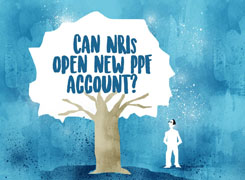
समस्या यह है कि आप अभी भी कार्यरत हैं और मासिक पेंशन के लिए ऑनलाइन आवेदन, यानी फॉर्म 10D, सेवा छोड़ने और EPFO पोर्टल पर अपनी सेवा समाप्ति तिथि अपडेट करने के बाद ही उपलब्ध होता है।
लेकिन चूंकि आप वर्तमान में एक नए नियोक्ता के साथ कार्यरत हैं, इसलिए सिस्टम केवल आंशिक निकासी के लिए फॉर्म 31 की अनुमति देता है।
चूंकि आप सेवानिवृत्ति पेंशन के लिए सभी आवश्यकताओं को पूरा करते हैं (आयु 62 वर्ष और 13 वर्ष की सेवा), कृपया आगे बढ़ने के लिए इन चरणों का पालन करें:
1. अपनी सेवा इतिहास सत्यापित करें - अपने UAN पोर्टल के "सेवा इतिहास" अनुभाग की जाँच करें। सुनिश्चित करें कि आपके पूर्व नियोक्ता ने आपकी सेवा समाप्ति तिथि को आधिकारिक रूप से अपडेट कर दिया है। इस स्थिति अपडेट के बिना ऑनलाइन सिस्टम पेंशन दावे को संसाधित नहीं कर सकता है।
2. ऑफ़लाइन आवेदन विधि का उपयोग करें - यदि ऑनलाइन पोर्टल प्रतिबंधित रहता है या तकनीकी त्रुटियों का सामना करता है, तो आपको एक भौतिक आवेदन जमा करना होगा।
* फॉर्म 10D डाउनलोड करें: आधिकारिक EPFO वेबसाइट से हार्ड कॉपी प्राप्त करें।
* नियोक्ता सत्यापन: फॉर्म भरें और अपने पूर्व नियोक्ता से हस्ताक्षर करवाएं।
1. अपनी सेवा समाप्ति तिथि सत्यापित करें - * वैकल्पिक सत्यापन: यदि आपका पिछला नियोक्ता उपलब्ध नहीं है या कंपनी बंद हो गई है, तो आप इस फॉर्म को राजपत्रित अधिकारी, मजिस्ट्रेट या अपने बैंक प्रबंधक से सत्यापित करवा सकते हैं।
3. जमा करने का विवरण - हस्ताक्षरित फॉर्म को निम्नलिखित दस्तावेजों के साथ अपने क्षेत्रीय EPFO कार्यालय में जमा करें:
* तीन पासपोर्ट आकार की तस्वीरें।
एक रद्द किया हुआ चेक (उस खाते के लिए जिसमें आप पेंशन प्राप्त करना चाहते हैं)।
आयु का वैध प्रमाण।
वास्तविक समय में स्थिति की जानकारी या विशिष्ट खाता संबंधी प्रश्नों के लिए, आप EPFO हेल्पलाइन नंबर 14470 पर संपर्क कर सकते हैं।
यदि आपको और सहायता की आवश्यकता हो तो मुझे बताएं।
सादर,
रीतिका शर्मा, प्रमाणित वित्तीय योजनाकार
https://www.instagram.com/cfpreetika/
Reetika Sharma |459 Answers |Ask -Follow
Financial Planner, MF and Insurance Expert - Answered on Dec 24, 2025

आप अनिश्चित काल के लिए निवेश कर सकते हैं। इसके नवीनीकरण की कोई आवश्यकता नहीं है और यह कभी समाप्त भी नहीं होता। धारक की मृत्यु होने पर, यदि आपके परिवार के पास विवरण हो तो वे इन निवेशों पर दावा कर सकते हैं।
लेकिन चूंकि आप नए निवेशक हैं, इसलिए किसी भी फंड में निवेश करने से बचें और किसी पेशेवर की मदद लें।
किसी पेशेवर प्रमाणित वित्तीय योजनाकार (सीएफपी) से परामर्श अवश्य लें, जो आपकी उम्र, आवश्यकताओं, वित्तीय लक्ष्यों और जोखिम प्रोफाइल को ध्यान में रखते हुए आपको निवेश करने के लिए उपयुक्त फंड चुनने में मार्गदर्शन कर सकते हैं। एक सीएफपी समय-समय पर आपके पोर्टफोलियो की समीक्षा करता है और आवश्यकता पड़ने पर संशोधन सुझाता है।
यदि आपको और सहायता की आवश्यकता हो तो मुझे बताएं।
सादर,
रीतिका शर्मा, प्रमाणित वित्तीय योजनाकार
https://www.instagram.com/cfpreetika/
Reetika Sharma |459 Answers |Ask -Follow
Financial Planner, MF and Insurance Expert - Answered on Dec 24, 2025

इन फंडों में निवेश करने की सलाह नहीं दी जाती है। आप इन्हें भुनाकर उपलब्ध बेहतर फंडों में निवेश कर सकते हैं। ऐसे अनिश्चित फंडों में स्वयं निवेश करने से बचें। इसके बजाय किसी पेशेवर की मदद लें।
यदि आपको और सहायता की आवश्यकता हो तो मुझे बताएं।
सादर,
रीतिका शर्मा, सर्टिफाइड फाइनेंशियल प्लानर
https://www.instagram.com/cfpreetika/
Reetika Sharma |459 Answers |Ask -Follow
Financial Planner, MF and Insurance Expert - Answered on Dec 24, 2025

SGB (सोशल सिक्योरिटी बॉन्ड) निवेश के लिए बेहतरीन विकल्प थे, लेकिन सरकार ने इन्हें बंद कर दिया है। अब आप किसी भी SGB में निवेश नहीं कर सकते। हालांकि, SGB नियमित आय के लिए आदर्श नहीं थे क्योंकि इनसे केवल 2.5% वार्षिक ब्याज मिलता था।
नियमित आय प्राप्त करने का सबसे अच्छा तरीका म्यूचुअल फंड में FD या SWP है।
यदि आपको और सहायता की आवश्यकता हो तो मुझे बताएं।
सादर,
रीतिका शर्मा, सर्टिफाइड फाइनेंशियल प्लानर
https://www.instagram.com/cfpreetika/
Reetika Sharma |459 Answers |Ask -Follow
Financial Planner, MF and Insurance Expert - Answered on Dec 24, 2025

चूंकि आप अगले साल मास्टर्स करने के बारे में अभी भी अनिश्चित हैं, इसलिए आप इस पैसे को डेट म्यूचुअल फंड में निवेश कर सकते हैं। और अगर 10 साल से अधिक समय तक इसकी आवश्यकता न हो, तो इसे इक्विटी में निवेश कर सकते हैं।
अंतिम निर्णय लेने तक आप अपने पैसे को HDFC के शॉर्ट टर्म डेट फंड में निवेश कर सकते हैं।
यदि आपको और सहायता की आवश्यकता हो, तो मुझे बताएं।
सादर,
रीतिका शर्मा, सर्टिफाइड फाइनेंशियल प्लानर
https://www.instagram.com/cfpreetika/
Samraat Jadhav |2524 Answers |Ask -Follow
Stock Market Expert - Answered on Dec 24, 2025
Reetika Sharma |459 Answers |Ask -Follow
Financial Planner, MF and Insurance Expert - Answered on Dec 24, 2025

37 वर्ष की आयु में आपने अच्छी-खासी बचत कर ली है। आपकी कुल राशि उचित रूप से विविध निवेशों में लगी हुई है।
जल्दी सेवानिवृत्त होने के लिए आपको कुछ बातों का ध्यान रखना होगा:
1. पर्याप्त नकदी आपातकालीन निधि रखें।
2. अपने और परिवार के लिए उपयुक्त सावधि बीमा और स्वास्थ्य बीमा करवाएं।
3. भविष्य के किसी भी बड़े वित्तीय लक्ष्य, जैसे विवाह, छुट्टियां, बच्चे, उनकी शिक्षा, माता-पिता का स्वास्थ्य आदि, का ध्यान रखें।
4. इन सभी लक्ष्यों के लिए आवश्यक राशि का आकलन करें।
अपने खर्चों पर भी विचार करें। इनके बिना मैं आपको कोई निश्चित आंकड़ा नहीं दे सकता।
यदि आपका वर्तमान खर्च 1 लाख रुपये प्रति माह है, तो आपको जीवन भर के लिए 3 करोड़ रुपये की आवश्यकता होगी (मुद्रास्फीति के हिसाब से समायोजित खर्चों सहित)।
इसलिए, कृपया मुझे और अधिक जानकारी दें ताकि मैं आपकी बेहतर सहायता कर सकूं।
साथ ही, चूंकि आपके म्यूचुअल फंड और स्टॉक में 60 लाख रुपये हैं, इसलिए निवेश करने के लिए सही राशि का पता लगाने के लिए किसी पेशेवर से सलाह लें, क्योंकि मनमाने ढंग से फंड चुनने पर अक्सर बहुत कम रिटर्न मिलता है।
इसलिए, एक पेशेवर प्रमाणित वित्तीय योजनाकार (सीएफपी) से परामर्श अवश्य लें, जो आपकी उम्र, आवश्यकताओं, वित्तीय लक्ष्यों और जोखिम प्रोफाइल को ध्यान में रखते हुए निवेश के लिए सही धनराशि का मार्गदर्शन कर सकते हैं। एक सीएफपी समय-समय पर आपके पोर्टफोलियो की समीक्षा करते हैं और आवश्यकता पड़ने पर संशोधन सुझाते हैं।
यदि आपको और सहायता की आवश्यकता हो तो मुझे बताएं।
सादर,
रीतिका शर्मा, प्रमाणित वित्तीय योजनाकार
https://www.instagram.com/cfpreetika/
Reetika Sharma |459 Answers |Ask -Follow
Financial Planner, MF and Insurance Expert - Answered on Dec 24, 2025

जीवन भर EMI के जाल में फँसे रहने के बजाय अपनी आय और बचत बढ़ाने पर ध्यान दें। EMI शुरू करने के बजाय SIP में बचत करना शुरू करें।
अगर आपको और मदद चाहिए तो मुझे बताएं।
शुभकामनाएं,
रीतिका शर्मा, सर्टिफाइड फाइनेंशियल प्लानर
https://www.instagram.com/cfpreetika/
Reetika Sharma |459 Answers |Ask -Follow
Financial Planner, MF and Insurance Expert - Answered on Dec 24, 2025

आप 25000 रुपये के स्वतः निवेश (एसडब्ल्यूपी) के लिए एक अच्छा डेट फंड चुन सकते हैं। मुझे यह बताना होगा कि आपको यह निकासी कितने समय के लिए चाहिए ताकि मैं प्रारंभिक निवेश राशि बता सकूं।
- यदि आपको 10 वर्षों के लिए प्रति माह 25,000 रुपये की आवश्यकता है, तो आपको 8% वार्षिक रिटर्न पर 21.5 लाख रुपये के निवेश की आवश्यकता होगी।
- यदि आपको 20 वर्षों के लिए प्रति माह 25,000 रुपये की आवश्यकता है, तो आपको 8% वार्षिक रिटर्न पर 31 लाख रुपये के निवेश की आवश्यकता होगी।
- यदि आपको हमेशा के लिए प्रति माह 25,000 रुपये की आवश्यकता है, तो आपको 8% वार्षिक रिटर्न पर 40 लाख रुपये के निवेश की आवश्यकता होगी।
लेकिन यह निकासी मुद्रास्फीति के हिसाब से समायोजित नहीं है। आपको इस राशि को काफी बढ़ाना होगा।
आप एक पेशेवर प्रमाणित वित्तीय योजनाकार (सीएफपी) के साथ काम करना चुन सकते हैं जो आपकी उम्र, आवश्यकताओं, वित्तीय लक्ष्यों और जोखिम प्रोफाइल को ध्यान में रखते हुए निवेश की सटीक रणनीति के साथ आपका मार्गदर्शन कर सकता है। एक सीएफपी समय-समय पर आपके पोर्टफोलियो की समीक्षा करता है और यदि आवश्यक हो तो संशोधन सुझाता है।
यदि आपको और सहायता की आवश्यकता हो तो मुझे बताएं।
सादर धन्यवाद,
रीतिका शर्मा, सर्टिफाइड फाइनेंशियल प्लानर
https://www.instagram.com/cfpreetika/
Reetika Sharma |459 Answers |Ask -Follow
Financial Planner, MF and Insurance Expert - Answered on Dec 24, 2025

दोनों ही अच्छे विकल्प हैं और उनमें बहुत कम अंतर हैं। सबसे अच्छा विकल्प व्यक्तिगत वित्तीय लक्ष्यों और जोखिम सहनशीलता पर निर्भर करता है:
आप यूपीएस चुन सकते हैं यदि: आपकी पत्नी वित्तीय सुरक्षा और एक निश्चित, गारंटीशुदा मासिक आय को प्राथमिकता देती हैं जो मुद्रास्फीति के अनुरूप हो और जिसमें बाजार का जोखिम न्यूनतम हो। 50% सुनिश्चित पेंशन स्थिरता प्रदान करती है, जिसे अक्सर सरकारी कर्मचारी पसंद करते हैं।
आप एनपीएस चुन सकते हैं यदि: आपकी पत्नी बाजार के जोखिमों से सहज हैं और अगले 15 वर्षों में संभावित रूप से उच्च प्रतिफल और एक बड़ा सेवानिवृत्ति कोष चाहती हैं। एनपीएस निवेश प्रबंधन में अधिक लचीलापन और कर-मुक्त एकमुश्त निकासी की सुविधा प्रदान करता है।
चूंकि आपकी पत्नी की सेवा के 15 वर्ष शेष हैं, इसलिए वह अपनी सुविधा के अनुरूप विकल्प चुनने के लिए सबसे उपयुक्त स्थिति में हैं। नई यूपीएस योजना की उपलब्धता बाजार से जुड़ी एनपीएस का एक उत्कृष्ट और सुरक्षित विकल्प प्रदान करती है।
यदि आपको और सहायता की आवश्यकता हो तो मुझे बताएं।
सादर धन्यवाद,
रीतिका शर्मा, सर्टिफाइड फाइनेंशियल प्लानर
https://www.instagram.com/cfpreetika/
Reetika Sharma |459 Answers |Ask -Follow
Financial Planner, MF and Insurance Expert - Answered on Dec 24, 2025

कृपया अपनी आय, जोखिम प्रोफ़ाइल, खर्च और बचत क्षमता जैसी अधिक जानकारी साझा करें ताकि मैं आपकी बेहतर सहायता कर सकूँ।
सादर,
रीतिका शर्मा, सर्टिफाइड फाइनेंशियल प्लानर
https://www.instagram.com/cfpreetika/
Reetika Sharma |459 Answers |Ask -Follow
Financial Planner, MF and Insurance Expert - Answered on Dec 24, 2025

निवेश के आपके दोनों पहलू बिल्कुल सही हैं। लेकिन दृष्टिकोण सही नहीं है। आपने जिन फंडों का उल्लेख किया है, वे आपस में मिलते-जुलते हैं और इनकी अनुशंसा नहीं की जाती। इस तरह का पोर्टफोलियो पूंजी वृद्धि के लिए अच्छा रिटर्न नहीं देता।
क्या इन फंडों को चुनने में आप किसी की मदद ले रहे हैं? यदि हां, तो आपको एक बेहतर पेशेवर की आवश्यकता है। यदि नहीं, तो मार्गदर्शन के लिए किसी प्रमाणित पोर्टफोलियो सलाहकार (सीएफपी) के साथ काम करें।
अभी इक्विटी बाजार में निवेश करना ठीक है। हाल की अस्थिरता और बाजार में उतार-चढ़ाव के कारण आपकी चिंता समझ में आती है, लेकिन इक्विटी में निवेश करने का एक तरीका है। आपको अपने मौजूदा 5 करोड़ के निवेश (हां, इसे जल्द से जल्द पुनर्वितरित करने की आवश्यकता है) और शेष 2 करोड़ को अपनी प्रोफाइल के अनुसार आवंटित करने में मदद के लिए एक प्रमाणित निवेश योजनाकार से संपर्क करना चाहिए।
BAF से SWP (स्वयं निवेश योजना) SWP का आदर्श तरीका नहीं है। आपके 2 लाख रुपये प्रति माह के खर्चों को पूरा करने के लिए एक बिल्कुल अलग रणनीति है। इसलिए कृपया अभी SWP न करें। चीजें और जटिल हो जाएंगी और पूंजी वृद्धि का आपका लक्ष्य खत्म हो सकता है।
कृपया किसी पेशेवर प्रमाणित वित्तीय योजनाकार (सीएफपी) से संपर्क करें, जो आपकी उम्र, आवश्यकताओं, वित्तीय लक्ष्यों और जोखिम प्रोफाइल को ध्यान में रखते हुए निवेश के लिए उपयुक्त धनराशि चुनने में आपका मार्गदर्शन कर सकते हैं। सीएफपी समय-समय पर आपके पोर्टफोलियो की समीक्षा करते हैं और आवश्यकता पड़ने पर संशोधन सुझाते हैं।
यदि आपको और सहायता की आवश्यकता हो तो मुझे बताएं।
सादर,
रीतिका शर्मा, प्रमाणित वित्तीय योजनाकार
https://www.instagram.com/cfpreetika/
Reetika Sharma |459 Answers |Ask -Follow
Financial Planner, MF and Insurance Expert - Answered on Dec 24, 2025

आपकी स्थिति के बारे में सुनकर मुझे बहुत दुख हुआ। लेकिन आपकी उम्र के हिसाब से आपके पास काफी अच्छी धनराशि (पूरे परिवार की) है। इससे नौकरी मिलने तक आपके खर्च आसानी से पूरे हो जाएंगे। आइए इन पहलुओं का विस्तार से विश्लेषण करें:
1. नकद - आपके खाते में 7.7 लाख रुपये हैं। यह राशि आपको 7 महीने तक चला सकती है। आप बिना पैसों की चिंता किए नौकरी की तैयारी कर सकते हैं और इंटरव्यू दे सकते हैं।
2. सोना - अच्छा है, लेकिन इसे बेचने का कोई विचार न करें।
3. प्राइवेट इक्विटी - 3 लाख रुपये। उच्च जोखिम और निरंतर निगरानी के कारण सीधे इक्विटी निवेश की सलाह नहीं दी जाती है। आप इस पूरी राशि को म्यूचुअल फंड में निवेश कर सकते हैं।
4. म्यूचुअल फंड - 39.5 लाख रुपये। आपकी उम्र के हिसाब से यह काफी अच्छी धनराशि है। लेकिन आपने जिन फंडों का जिक्र किया है, वे बहुत बिखरे हुए और एक-दूसरे से मिलते-जुलते हैं। यह एक ऐसा पोर्टफोलियो है जिसकी हम सलाह नहीं देंगे। इसमें गंभीर सुधार की आवश्यकता है। अपनी स्थिति को ध्यान में रखते हुए इन सभी फंडों और राशियों को पुनर्व्यवस्थित करने के लिए किसी पेशेवर से सलाह लें। अन्यथा इससे अच्छा रिटर्न नहीं मिलेगा।
और इसे स्वयं करने से बचें, क्योंकि आपको अपने पोर्टफोलियो को सुधारने के बजाय नौकरी पाने पर ध्यान देना चाहिए। एक पेशेवर का काम आपके लिए यह करना है।
आपके माता-पिता की संपत्ति:
1. नकद - 21 लाख - नकद के रूप में रखने के लिए काफी बड़ी राशि है। कम से कम 5 लाख नकद रखें और शेष राशि को सावधि जमा (फिक्स्ड डिपॉजिट) में निवेश करें।
2. एससीएस - 60 लाख - अच्छा है, जारी रखें।
3. सावधि जमा - 40.8 लाख - अच्छा है, लेकिन ब्याज काफी कम है और कर योग्य है। इसके बजाय, इस राशि को डेट म्यूचुअल फंड में निवेश करने पर विचार करें।
4. म्यूचुअल फंड - दोनों माता-पिता ने कई फंडों में बहुत कम राशि निवेश की है। इसका कोई फायदा नहीं है। आप इन सभी फंडों को भुना सकते हैं और अपने माता-पिता के पैसे के लिए केवल एक फंड - एचडीएफसी बैलेंस्ड एडवांटेज फंड - चुन सकते हैं।
उम्मीद है कि आपको 7 महीनों में नौकरी मिल जाएगी और आप अपने मासिक खर्चों की चिंता किए बिना, अपने पोर्टफोलियो को सुव्यवस्थित करने और बेहतर रिटर्न प्राप्त करने के लिए एक पेशेवर की मदद लेंगे।
इसलिए, एक पेशेवर प्रमाणित वित्तीय योजनाकार (सीएफपी) से परामर्श अवश्य लें, जो आपकी उम्र, आवश्यकताओं, वित्तीय लक्ष्यों और जोखिम प्रोफाइल को ध्यान में रखते हुए निवेश के लिए सही धनराशि का मार्गदर्शन कर सकते हैं। एक सीएफपी समय-समय पर आपके पोर्टफोलियो की समीक्षा करते हैं और आवश्यकता पड़ने पर संशोधन सुझाते हैं।
यदि आपको और सहायता की आवश्यकता हो तो मुझे बताएं।
सादर,
रीतिका शर्मा, प्रमाणित वित्तीय योजनाकार
https://www.instagram.com/cfpreetika/
Reetika Sharma |459 Answers |Ask -Follow
Financial Planner, MF and Insurance Expert - Answered on Dec 24, 2025
.jpg)
आपकी स्थिति के बारे में सुनकर मुझे बहुत दुख हुआ, लेकिन भारत में तलाक के बिना किसी से शादी करना गैरकानूनी है। आप उसके खिलाफ कानूनी कार्रवाई कर सकती हैं।
आपके निवेश के संबंध में, 1.5 करोड़ रुपये आपकी सेवानिवृत्ति के लिए बहुत अच्छी राशि है और कुल आवश्यकता आपके मासिक खर्चों और अन्य जरूरतों पर निर्भर करती है। कृपया मुझे अपने निवेश के बारे में संक्षेप में बताएं ताकि मैं इस संबंध में आपकी आगे मदद कर सकूं।
विवरण जानने के लिए, आप अपने फोन में MF Central ऐप इंस्टॉल कर सकती हैं और अपने पैन/आधार कार्ड विवरण के माध्यम से लॉग इन करके अपने पोर्टफोलियो का सटीक विवरण प्राप्त कर सकती हैं। आप एक पेशेवर से संपर्क कर सकती हैं जो इस संबंध में विस्तार से आपकी मदद करेगा और आपकी आवश्यकताओं के अनुसार आपके पोर्टफोलियो का प्रबंधन करेगा।
यदि आपको और सहायता की आवश्यकता हो तो मुझे बताएं।
सादर,
रीतिका शर्मा, सर्टिफाइड फाइनेंशियल प्लानर
https://www.instagram.com/cfpreetika/
Reetika Sharma |459 Answers |Ask -Follow
Financial Planner, MF and Insurance Expert - Answered on Dec 24, 2025

निजी कर्मचारियों को पेंशन का लाभ नहीं मिलता है। आपको केवल वर्षों से जमा हुआ पीएफ (पेंसिल्वेनिया पेंशन) ही मिलेगा। इसकी जानकारी आपको वेतन पर्ची में मिल जाएगी।
इसमें ग्रेच्युटी के रूप में 9.3 लाख रुपये मिलेंगे।
यदि आपको और सहायता चाहिए तो कृपया मुझे बताएं।
सादर,
रीतिका शर्मा, सर्टिफाइड फाइनेंशियल प्लानर
https://www.instagram.com/cfpreetika/
Reetika Sharma |459 Answers |Ask -Follow
Financial Planner, MF and Insurance Expert - Answered on Dec 24, 2025

स्वचालित निवेश प्रतिशत (SWP) वास्तव में आपके पोर्टफोलियो के आकार और आपकी मासिक/वार्षिक आवश्यकताओं पर निर्भर करता है। बेहतर सहायता के लिए कृपया ये विवरण साझा करें।
यदि आपको और सहायता की आवश्यकता हो तो मुझे बताएं।
सादर,
रीतिका शर्मा, सर्टिफाइड फाइनेंशियल प्लानर
https://www.instagram.com/cfpreetika/
Reetika Sharma |459 Answers |Ask -Follow
Financial Planner, MF and Insurance Expert - Answered on Dec 24, 2025

यह बहुत अच्छी बात है कि आप 2017 से निवेश कर रहे हैं। लंबे समय तक निवेश और धैर्य हमेशा अच्छे परिणाम देते हैं।
यदि सही तरीके से निवेश किया जाए, तो आप 58 वर्ष की आयु तक आसानी से अपना लक्ष्य प्राप्त कर सकते हैं।
आपने जिन फंडों का उल्लेख किया है, उनमें बहुत अधिक ओवरलैपिंग और बिखराव है। इसमें सुधार और पूर्ण पुनर्वितरण की आवश्यकता है। अधिकतम 5 फंड ही होने चाहिए। अपने पोर्टफोलियो को अपने लक्ष्य और व्यक्तिगत प्रोफाइल के अनुरूप बनाने के लिए किसी पेशेवर की मदद लें।
आपके जैसे अनियमित पोर्टफोलियो का विपरीत प्रभाव पड़ सकता है।
साथ ही, मासिक एसआईपी को हर साल 10% बढ़ाने का प्रयास करें। इससे महंगाई का असर कम होगा।
इसलिए, किसी पेशेवर प्रमाणित वित्तीय योजनाकार (सीएफपी) से परामर्श अवश्य लें, जो आपकी आयु, आवश्यकताओं, वित्तीय लक्ष्यों और जोखिम प्रोफाइल को ध्यान में रखते हुए निवेश के लिए सही फंड चुनने में आपका मार्गदर्शन कर सकता है। एक सीएफपी समय-समय पर आपके पोर्टफोलियो की समीक्षा करता है और आवश्यकता पड़ने पर संशोधन सुझाता है।
यदि आपको और सहायता की आवश्यकता हो, तो मुझे बताएं।
सादर धन्यवाद,
रीतिका शर्मा, सर्टिफाइड फाइनेंशियल प्लानर
https://www.instagram.com/cfpreetika/
Ramalingam Kalirajan |10927 Answers |Ask -Follow
Mutual Funds, Financial Planning Expert - Answered on Dec 24, 2025

इस स्तर तक पहुँचना धैर्य, योजना और वित्तीय परिपक्वता को दर्शाता है।
62 वर्ष की आयु में, आपका ध्यान स्वाभाविक रूप से स्थिरता और नियमित आय की ओर केंद्रित होता है।
साथ ही, मुद्रास्फीति से लड़ने के लिए विकास जारी रहना आवश्यक है।
इसलिए अब संतुलित दृष्टिकोण अत्यंत महत्वपूर्ण है।
आयु, जीवन स्तर और निवेश संदर्भ
आप प्रारंभिक सेवानिवृत्ति के संक्रमण काल में हैं।
आक्रामक विकास की तुलना में पूंजी संरक्षण अधिक महत्वपूर्ण हो जाता है।
अब उच्च प्रतिफल की तुलना में नियमित आय अधिक मायने रखती है।
अस्थिरता को सावधानीपूर्वक नियंत्रित किया जाना चाहिए।
आपात स्थिति के लिए पर्याप्त तरलता उपलब्ध होनी चाहिए।
कर दक्षता का प्रबंधन समझदारी से किया जाना चाहिए।
म्यूचुअल फंड अभी भी इस चरण के लिए उपयुक्त हैं।
वे लचीलापन, पारदर्शिता और विविधीकरण प्रदान करते हैं।
वे आवश्यकता पड़ने पर धीरे-धीरे निकासी की सुविधा भी देते हैं।
62 वर्ष की आयु में मूल निवेश दर्शन
आपका पैसा बिना तनाव के काम करना चाहिए।
प्रत्येक रुपये का एक स्पष्ट उद्देश्य होना चाहिए।
जोखिम मापा हुआ और सुनियोजित होना चाहिए।
प्रतिफल उचित और दोहराने योग्य होना चाहिए।
कैश फ्लो पूर्वानुमानित होना चाहिए।
इस उम्र में बाज़ार के उच्चतम स्तर पर पहुंचने के चक्कर में निवेश करने से बचें।
लंबे समय के लिए फंड को लॉक करने से बचें।
जटिल संरचनाओं और अपारदर्शी उत्पादों से बचें।
• 25 लाख रुपये के लिए अनुशंसित परिसंपत्ति आवंटन
यह आवंटन सुरक्षा, आय और वृद्धि को संतुलित करता है।
यह बाज़ार के उतार-चढ़ाव को भी नियंत्रित करता है।
• इक्विटी-उन्मुख म्यूचुअल फंड: 35%
• डेट-उन्मुख म्यूचुअल फंड: 55%
• हाइब्रिड-उन्मुख म्यूचुअल फंड: 10%
यह संरचना अस्थिरता को नियंत्रण में रखती है।
यह समय के साथ उचित वृद्धि की भी अनुमति देती है।
• आपकी उम्र में इक्विटी म्यूचुअल फंड की भूमिका
60 वर्ष के बाद भी इक्विटी आवश्यक है।
मुद्रास्फीति हर साल क्रय शक्ति को कम करती है।
चिकित्सा लागत सामान्य मुद्रास्फीति से अधिक तेज़ी से बढ़ती है।
इक्विटी आपके पैसे को प्रासंगिक बनाए रखने में मदद करती है।
हालांकि, इक्विटी में निवेश सीमित होना चाहिए।
साथ ही, यह विविध और अनुशासित होना चाहिए।
• इक्विटी म्यूचुअल फंड आवंटन – 35%
यह लगभग 8.75 लाख रुपये के बराबर है।
सुझाया गया आंतरिक विभाजन इस प्रकार है:
• बड़ी, स्थापित कंपनियों पर केंद्रित फंड: 25%
• लचीले ढंग से प्रबंधित इक्विटी रणनीतियाँ: 10%
बड़ी कंपनियों में निवेश स्थिरता प्रदान करता है।
उनके व्यावसायिक मॉडल सिद्ध और मजबूत हैं।
आय की स्पष्टता आमतौर पर बेहतर होती है।
लचीली इक्विटी रणनीतियाँ अनुकूलनशीलता प्रदान करती हैं।
फंड प्रबंधक बाजार की स्थितियों के आधार पर समायोजन करते हैं।
इससे बाजार में गिरावट के दौरान जोखिम कम होता है।
अभी मध्यम और छोटी कंपनियों पर आक्रामक रूप से ध्यान केंद्रित करने से बचें।
इनसे तीव्र अस्थिरता और भावनात्मक तनाव उत्पन्न होता है।
• सक्रिय रूप से प्रबंधित इक्विटी फंड क्यों महत्वपूर्ण हैं
भारत में बाजार हमेशा कुशल नहीं होते हैं।
कॉर्पोरेट गवर्नेंस की गुणवत्ता में व्यापक भिन्नता है।
क्षेत्र चक्र अप्रत्याशित रूप से बदलते हैं।
सक्रिय प्रबंधक कमजोर व्यवसायों से बच सकते हैं।
वे अत्यधिक मूल्यांकन के दौरान जोखिम कम कर सकते हैं।
वे अनिश्चितता के दौरान गुणवत्ता पूर्वाग्रह बढ़ा सकते हैं।
सेवानिवृत्ति के बाद यह लचीलापन और भी महत्वपूर्ण हो जाता है।
• डेट म्यूचुअल फंड: स्थिरता का आधार
डेट फंड आपके पोर्टफोलियो की रीढ़ की हड्डी बनेंगे।
ये स्थिरता और पूर्वानुमानित व्यवहार प्रदान करते हैं।
ये नियमित आय नियोजन में भी सहायक होते हैं।
62 वर्ष की आयु में, डेट निवेश को प्राथमिकता देनी चाहिए।
यह शेयर बाजार में गिरावट के दौरान पूंजी की रक्षा करता है।
• डेट म्यूचुअल फंड में निवेश – 55%
यह लगभग 13.75 लाख रुपये के बराबर है।
सुझाया गया आंतरिक ढांचा नीचे दिया गया है।
• अल्पावधि पर केंद्रित डेट रणनीतियाँ: 25%
• मध्यम अवधि की डेट रणनीतियाँ: 15%
• रूढ़िवादी आय-उन्मुख डेट रणनीतियाँ: 15%
अल्पावधि वाले फंड ब्याज दर के जोखिम को कम करते हैं।
ये अल्पकालिक आवश्यकताओं के लिए उपयुक्त हैं।
ये बेहतर पूर्वानुमान प्रदान करते हैं।
मध्यम अवधि के फंड प्रतिफल और जोखिम के बीच संतुलन बनाते हैं।
ये तीन से पांच वर्षों की अवधि के लिए उपयुक्त हैं।
आय-उन्मुख डेट रणनीतियाँ स्थिर नकदी प्रवाह में सहायक होती हैं।
ये समग्र पोर्टफोलियो रिटर्न को भी सुचारू बनाते हैं।
इस स्तर पर क्रेडिट जोखिम वाली रणनीतियों से बचें।
अतिरिक्त रिटर्न की चाह पूंजी को नुकसान पहुंचा सकती है।
• डेट म्यूचुअल फंड पर कर संबंधी दृष्टिकोण
डेट फंड के लाभ पर स्लैब दरों के अनुसार कर लगता है।
यह अल्पकालिक और दीर्घकालिक दोनों होल्डिंग अवधियों पर लागू होता है।
कम आय वाले वर्षों में निकासी की योजना बनाएं।
इससे कर-पश्चात परिणाम बेहतर होते हैं।
• हाइब्रिड म्यूचुअल फंड – सीमित लेकिन उपयोगी
हाइब्रिड फंड इक्विटी और डेट एक्सपोजर का संयोजन होते हैं।
ये आंतरिक संतुलन के माध्यम से अस्थिरता को कम करते हैं।
ये आवंटन प्रबंधन को सरल बनाते हैं।
हालांकि, आवंटन सीमित रहना चाहिए।
• हाइब्रिड म्यूचुअल फंड आवंटन – 10%
यह लगभग 2.5 लाख रुपये के बराबर है।
केवल रूढ़िवादी हाइब्रिड दृष्टिकोण चुनें।
डेट का हिस्सा स्पष्ट रूप से हावी होना चाहिए।
इक्विटी का हिस्सा नियंत्रित होना चाहिए।
यह खंड एक शॉक एब्जॉर्बर के रूप में कार्य करता है।
यह सुचारू रिटर्न में भी सहायक होता है।
• तरलता और आपातकालीन योजना
हमेशा तरलता उपलब्ध रखें।
अप्रत्याशित चिकित्सा या पारिवारिक ज़रूरतें उत्पन्न हो सकती हैं।
सुनिश्चित करें कि कम से कम बारह महीने के खर्च के लिए पर्याप्त धनराशि उपलब्ध रहे।
यह बचत या तरलता-उन्मुख निधियों के माध्यम से हो सकता है।
अपनी पूरी अतिरिक्त राशि को एक ही जगह निवेश न करें।
निकासी रणनीति योजना
निवेश केवल आधी यात्रा है।
निकासी योजना अब उतनी ही महत्वपूर्ण है।
चरणबद्ध निकासी दृष्टिकोण अपनाएं।
बाजार में गिरावट के दौरान इक्विटी को भुनाने से बचें।
अस्थिरता के दौरान पहले ऋण का हिस्सा निकालें।
यह दीर्घकालिक विकास क्षमता की रक्षा करता है।
बाजार अस्थिरता और भावनात्मक शांति
बाजार में सुधार अपरिहार्य हैं।
आपका पोर्टफोलियो ऐसा होना चाहिए जिससे आपको चैन की नींद आए।
सुझाया गया आवंटन घबराहट के जोखिम को कम करता है।
यह पोर्टफोलियो में अचानक होने वाले उतार-चढ़ाव से बचाता है।
भावनात्मक शांति एक छिपा हुआ लाभ है।
सेवानिवृत्ति के बाद इसका बहुत महत्व है।
पुनर्संतुलन अनुशासन
पोर्टफोलियो संतुलन समय के साथ बदलता रहेगा।
तेजी के बाजारों में इक्विटी की वृद्धि दर अधिक हो सकती है।
हर साल एक बार आवंटन की समीक्षा करें।
इक्विटी से प्राप्त अतिरिक्त लाभ को डेट में निवेश करें।
इससे संचित लाभ सुरक्षित रहता है।
बार-बार पुनर्संतुलन न करें।
अल्पकालिक उतार-चढ़ाव से प्रभावित न हों।
• सेवानिवृत्ति के वर्षों में मुद्रास्फीति से सुरक्षा
मुद्रास्फीति चुपचाप स्थिर आय को कम करती है।
चिकित्सा व्यय से संबंधित मुद्रास्फीति विशेष रूप से खतरनाक होती है।
इक्विटी में निवेश इस जोखिम को कम करता है।
सक्रिय प्रबंधन सुरक्षा को और बेहतर बनाता है।
इक्विटी के बिना, सेवानिवृत्ति निधि वास्तविक रूप से कम हो जाती है।
• संपत्ति और नामांकन अनुशासन
सुनिश्चित करें कि नामांकन हर जगह अद्यतन हों।
इसमें म्यूचुअल फंड और बैंक खाते शामिल हैं।
यदि वसीयत न हो, तो एक स्पष्ट वसीयत बनाएं।
इससे भविष्य में पारिवारिक विवादों से बचा जा सकता है।
लाभार्थियों की नियमित रूप से समीक्षा करें।
• इस चरण में क्या न करें
उच्च प्रतिफल के वादों के पीछे न भागें।
गैर-तरल संरचनाओं में धन न लगाएं।
किसी एक विषय में एकाग्रता से बचें।
बार-बार पोर्टफोलियो में बदलाव करने से बचें।
सरलता दीर्घकालीन योजना बनाने में सहायक होती है।
• निगरानी और समीक्षा ढांचा
पोर्टफोलियो की समीक्षा दैनिक नहीं, वार्षिक रूप से करें।
जीवन की आवश्यकताओं के साथ इसके तालमेल पर नज़र रखें।
जीवन की परिस्थितियों में बदलाव होने पर ही समायोजन करें।
बाजार के उतार-चढ़ाव से अपने निर्णय प्रभावित न होने दें।
• अंतिम निष्कर्ष
आप एक मजबूत स्थिति में पहुंच चुके हैं।
आपकी बचत वर्षों के अनुशासन का परिणाम है।
अब लक्ष्य गति नहीं, स्थिरता है।
एक संतुलित म्यूचुअल फंड दृष्टिकोण उपयुक्त है।
यह वृद्धि, आय और लचीलापन प्रदान करता है।
यह आपकी उम्र और जिम्मेदारियों का सम्मान करता है।
उचित आवंटन और धैर्य के साथ,
आपका पैसा आपको आराम से सहारा दे सकता है।
स्पष्टता और आत्मविश्वास के साथ निवेशित रहें।
सादर,
के. रामलिंगम, एमबीए, सीएफपी,
मुख्य वित्तीय योजनाकार,
www.holisticinvestment.in
https://www.youtube.com/@HolisticInvestment
Purshotam Lal |73 Answers |Ask -Follow
Financial Planner, MF and Insurance Expert - Answered on Dec 23, 2025

शुभकामनाएं।
पुरषोत्तम, सीएफपी®, एमबीए, सीएआईआईबी, एफआईआई
प्रमाणित वित्तीय योजनाकार
बीमा सलाहकार
www.finphoenixinvest.com
Purshotam Lal |73 Answers |Ask -Follow
Financial Planner, MF and Insurance Expert - Answered on Dec 23, 2025

पुरषोत्तम, सीएफपी®, एमबीए, सीएआईआईबी, एफआईआई
प्रमाणित वित्तीय योजनाकार
बीमा सलाहकार
www.finphoenixinvest.com
Samraat Jadhav |2524 Answers |Ask -Follow
Stock Market Expert - Answered on Dec 23, 2025

Samraat Jadhav |2524 Answers |Ask -Follow
Stock Market Expert - Answered on Dec 23, 2025

Samraat Jadhav |2524 Answers |Ask -Follow
Stock Market Expert - Answered on Dec 23, 2025
Samraat Jadhav |2524 Answers |Ask -Follow
Stock Market Expert - Answered on Dec 23, 2025

Samraat Jadhav |2524 Answers |Ask -Follow
Stock Market Expert - Answered on Dec 23, 2025
Samraat Jadhav |2524 Answers |Ask -Follow
Stock Market Expert - Answered on Dec 23, 2025
Ramalingam Kalirajan |10927 Answers |Ask -Follow
Mutual Funds, Financial Planning Expert - Answered on Dec 23, 2025

एसआईपी शुरू करना दीर्घकालिक सोच को दर्शाता है।
छोटी शुरुआत आत्मविश्वास और सीखने की क्षमता बढ़ाती है।
आपके प्रश्न पूछने की तत्परता सराहनीय है।
“आपकी वर्तमान एसआईपी गतिविधि की समीक्षा”
“आपने 3,000 रुपये की मासिक एसआईपी शुरू की है।
एसआईपी की अवधि तीन महीने है।
निवेश बैंक के मोबाइल ऐप के माध्यम से किया जा रहा है।
यह अच्छी पहल को दर्शाता है।
शुरुआती आदतें भविष्य की संपत्ति का निर्माण करती हैं।
“आपके द्वारा चुनी गई फंड श्रेणी को समझना”
“यह फंड लघु कंपनियों की श्रेणी में आता है।
ऐसे फंड उच्च जोखिम वाले होते हैं।
ऐसे फंडों में उच्च अस्थिरता होती है।
वार्षिक रिटर्न असमान हो सकते हैं।
यहाँ धैर्य बहुत महत्वपूर्ण है।
“लघु कंपनी फंडों की उपयुक्तता”
“छोटी कंपनियाँ कभी-कभी तेजी से बढ़ती हैं।
वे मंदी के दौरान तेजी से गिरती भी हैं।
पहले निवेश के तौर पर उपयुक्त नहीं।
शुरुआत में निवेश सीमित रखें।
संतुलन ज़रूरी है।
→ जल्दी शुरुआत
→ आपने पूर्णता की प्रतीक्षा किए बिना शुरुआत की।
→ कई लोग अनावश्यक रूप से निवेश में देरी करते हैं।
→ पूर्णता से ज़्यादा ज़रूरी है काम करना।
यह सोच दीर्घकालिक सफलता में सहायक होती है।
→ जोखिम के प्रति जागरूकता ज़रूरी
→ छोटी कंपनियों के फंड में तेज़ी से उतार-चढ़ाव होता है।
→ अल्पकालिक नुकसान आम बात है।
→ भावनात्मक नियंत्रण आवश्यक है।
तीन महीने का समय मूल्यांकन के लिए बहुत कम है।
समय सीमा लंबी होनी चाहिए।
→ न्यूनतम सुझाई गई समय सीमा
→ ऐसे फंडों के लिए कम से कम सात साल की आवश्यकता होती है।
कम समय सीमा निराशा का कारण बनती है।
→ एसआईपी समय जोखिम को कम करने में मदद करता है।
शुरुआत में प्रतिफल से ज़्यादा निरंतरता मायने रखती है।
→ निवेश मंच के रूप में बैंक ऐप
→ बैंक ऐप आमतौर पर सुरक्षित होते हैं।
लेन-देन विनियमित होते हैं।
– होल्डिंग्स रजिस्ट्रार के पास सुरक्षित रखी जाती हैं।
प्लेटफ़ॉर्म की सुरक्षा मुख्य जोखिम नहीं है।
निवेश का विकल्प अधिक महत्वपूर्ण है।
बैंक ऐप्स की सीमाएँ
– सीमित मार्गदर्शन प्रदान किया जाता है।
उत्पाद बेचने का दबाव आम बात है।
सलाह व्यक्तिगत नहीं होती।
बैंक सुविधा पर ध्यान केंद्रित करते हैं।
योजना बनाने में गहराई का अभाव होता है।
बैंक कर्मचारी सहायता की सीमाएँ
– कर्मचारी अक्सर बदलते रहते हैं।
ज्ञान का स्तर भिन्न होता है।
दीर्घकालिक जवाबदेही का अभाव है।
इससे सलाह की निरंतरता प्रभावित होती है।
निवेश की सुरक्षा बनाम प्लेटफ़ॉर्म
– फंड आपके पैन में रखे जाते हैं।
प्लेटफ़ॉर्म के विफल होने से निवेश नष्ट नहीं होते।
यूनिट फंड हाउस के पास सुरक्षित रहते हैं।
इसलिए प्लेटफ़ॉर्म की सुरक्षा का डर न्यूनतम है।
निर्णय की गुणवत्ता अधिक महत्वपूर्ण है।
एक और एसआईपी योजना पर विचार
– आप 3,000 रुपये की एक और एसआईपी करना चाहते हैं।
कुल एसआईपी 6,000 रुपये मासिक हो जाती है।
यह सकारात्मक वृद्धि का संकेत है।
लेकिन संरचना में सुधार की आवश्यकता है।
• प्लेटफ़ॉर्म तुलना परिप्रेक्ष्य
• आप किसी अन्य ऐप का उपयोग करके योजना बना रहे हैं।
• ऐसे ऐप स्व-निवेश को बढ़ावा देते हैं।
• मार्गदर्शन की गुणवत्ता सीमित है।
आसानी को योजना का विकल्प नहीं बनाना चाहिए।
• डायरेक्ट प्लेटफ़ॉर्म वास्तविकता परीक्षण
• ऐसे ऐप डायरेक्ट प्लान को बढ़ावा देते हैं।
• खर्च का अंतर आकर्षक लगता है।
लेकिन छिपे हुए खर्च भी होते हैं।
खर्च केवल व्यय अनुपात नहीं होता।
गलतियों की कीमत कहीं अधिक होती है।
• डायरेक्ट प्लान के नुकसान
• व्यक्तिगत सलाह नहीं मिलती।
गिरावट के दौरान व्यवहार संबंधी मार्गदर्शन नहीं मिलता।
पोर्टफोलियो समीक्षा सहायता नहीं मिलती।
निवेशक मार्गदर्शन के बिना भावनात्मक रूप से निर्णय लेते हैं।
इससे रिटर्न पर बहुत बुरा असर पड़ता है।
• प्रत्यक्ष निवेश में निर्णय संबंधी त्रुटियाँ
– बाज़ार में गिरावट के दौरान घबराहट में शेयर बेचना।
तेज़ी के दौरान अति आत्मविश्वास।
बार-बार फंड बदलना।
ये गलतियाँ चक्रवृद्धि लाभ को नष्ट कर देती हैं।
ये बहुत आम हैं।
• ऐप्स में जवाबदेही का अभाव
– ऐप्स आपको कॉल नहीं करते।
ऐप्स गलत कार्यों को नहीं रोकते।
पूरी ज़िम्मेदारी निवेशक पर होती है।
यह शुरुआती निवेशकों के लिए जोखिम भरा है।
• नियमित योजनाएँ मूल्य क्यों बढ़ाती हैं
– मार्गदर्शन अनुशासन बनाए रखने में मदद करता है।
परिसंपत्ति आवंटन संतुलित रहता है।
• व्यवहार संबंधी गलतियाँ कम होती हैं।
कमीशन से कहीं अधिक मूल्य महत्वपूर्ण है।
• अस्थिरता के दौरान समर्थन महत्वपूर्ण है।
• सीएफपी प्रमाण पत्र के साथ एमएफडी की भूमिका
– प्रमाणित वित्तीय योजनाकार एक संरचना प्रदान करता है।
• सलाह लक्ष्यों के अनुरूप होती है।
दीर्घकालिक मार्गदर्शन उपलब्ध है।
इससे निवेश का अनुभव बेहतर होता है।
रिटर्न अधिक स्थिर हो जाते हैं।
• लागत बनाम मूल्य परिप्रेक्ष्य
– डायरेक्ट प्लान से बचत का प्रतिशत कम होता है।
– गलत निर्णयों से भारी नुकसान होता है।
अंतिम परिणाम अधिक मायने रखता है।
मन की शांति भी मायने रखती है।
• आपके वर्तमान पोर्टफोलियो में एकाग्रता का जोखिम
• केवल एक इक्विटी श्रेणी में निवेश है।
• जोखिम केंद्रित है।
• विविधीकरण का अभाव है।
इससे अस्थिरता का जोखिम बढ़ जाता है।
संतुलन की तत्काल आवश्यकता है।
• विविधीकरण का महत्व
• विभिन्न फंडों का प्रदर्शन अलग-अलग होता है।
• बाजार चक्रों का प्रभाव असमान रूप से पड़ता है।
• संतुलन झटकों को कम करता है।
विविधीकरण स्थिरता में सुधार करता है।
• शुरुआती लोगों के लिए आदर्श एसआईपी संरचना
• एक आक्रामक घटक।
• एक स्थिर वृद्धि घटक।
एक लचीला आवंटन घटक।
इससे जोखिम समान रूप से वितरित होता है।
आराम स्वतः बढ़ जाता है।
• एकाधिक ऐप्स से क्यों बचें
– ट्रैकिंग भ्रमित करने वाली हो जाती है।
• अनुशासन कमजोर हो जाता है।
• समीक्षा करना कठिन हो जाता है।
एक निर्देशित प्लेटफ़ॉर्म बेहतर है।
सरलता से पालन में सुधार होता है।
• डेटा सुरक्षा परिप्रेक्ष्य
• ऐप्स विनियमित हैं।
• डेटा सुरक्षा मानक मौजूद हैं।
• जोखिम न्यूनतम है।
लेकिन सलाह की गुणवत्ता में कमी बनी रहती है।
• बाज़ार में गिरावट के दौरान व्यवहार
• छोटी कंपनियों के फंड में भारी गिरावट आती है।
• शुरुआती निवेशक आसानी से घबरा जाते हैं।
• SIP रोकना लुभावना हो जाता है।
मार्गदर्शन गलत प्रतिक्रियाओं को रोकता है।
• भावनात्मक समर्थन का महत्व
• बाज़ार धैर्य की परीक्षा लेते हैं।
• भय अचानक उत्पन्न होता है।
• किसी को मार्गदर्शन करना आवश्यक है।
यहां ऐप्स इंसानों की जगह नहीं ले सकते।
“सिर्फ छोटी कंपनियों से शुरुआत करना जोखिम भरा क्यों है?
– अस्थिरता अधिक होती है।
– रिटर्न असमान होते हैं।
– भरोसा जल्दी टूट सकता है।
संतुलित शुरुआत से विश्वास बढ़ता है।
“धीरे-धीरे निवेश बढ़ाने का तरीका
– मुख्य स्थिरता से शुरुआत करें।
– धीरे-धीरे जोखिम बढ़ाएं।
अनुभव के साथ जोखिम बढ़ाएं।
इससे सफर आसान हो जाता है।
“एसआईपी राशि बढ़ाने की रणनीति
– शुरुआत में 6,000 रुपये ठीक हैं।
आय में वृद्धि के साथ सालाना राशि बढ़ाएं।
– राशि से ज्यादा अनुशासन मायने रखता है।
यहां समय ही धन बनाता है।
“कर संबंधी संक्षिप्त जानकारी
– इक्विटी फंडों पर बेचने पर कर लगता है।
– दीर्घकालिक लाभ की सीमा होती है।
अल्पकालिक लाभ पर अधिक कर लगता है।
लंबे समय तक निवेश बनाए रखने से दक्षता बढ़ती है।
“बार-बार बदलाव करने से बचें”
– फंड बदलने से चक्रवृद्धि लाभ पर नकारात्मक प्रभाव पड़ता है।
– लागतें चुपचाप बढ़ती जाती हैं।
अनुशासन से पछतावा कम होता है।
रणनीति पर दृढ़ता से टिके रहें।
“निगरानी की आवृत्ति”
– साल में एक बार समीक्षा करें।
हर महीने जाँच करने से बचें।
अतिशय शोर से भ्रम पैदा होता है।
दीर्घकालिक दृष्टिकोण महत्वपूर्ण है।
“सोशल मीडिया के प्रभाव से बचें”
– सुझाव अक्सर भ्रामक होते हैं।
– पिछले रिटर्न को ही प्रमुखता दी जाती है।
– जोखिम छिपा रहता है।
व्यवस्थित सलाह से जाल में फंसने से बचा जा सकता है।
“लक्ष्य निर्धारण की भूमिका”
– निवेश करने का कारण स्पष्ट करें।
समय सीमा महत्वपूर्ण है।
– जोखिम का चुनाव लक्ष्यों पर निर्भर करता है।
लक्ष्यों के बिना निवेश तनावपूर्ण लगता है।
“आपातकालीन निधि अनुस्मारक”
– आपातकालीन निधि को अलग रखें।
एसआईपी के साथ इसे न मिलाएं।
– तरलता आवश्यक है।
इससे एसआईपी बंद होने से बचाव होता है।
• बीमा और सुरक्षा की जांच
• स्वास्थ्य बीमा पर्याप्त होना चाहिए।
• आश्रितों के लिए जीवन बीमा महत्वपूर्ण है।
सुरक्षा निवेश की निरंतरता सुनिश्चित करती है।
• दीर्घकालिक धन की मानसिकता
• धन धीरे-धीरे बढ़ता है।
• धैर्य बुद्धि से बेहतर है।
• प्रक्रिया पूर्वानुमान से बेहतर है।
निरंतरता हमेशा जीत दिलाती है।
• शुरुआती लोगों द्वारा की जाने वाली आम गलतियाँ जिनसे बचना चाहिए
• पिछले वर्ष के रिटर्न का पीछा करना।
• बहुत सारे ऐप्स का उपयोग करना।
• आवंटन संतुलन को अनदेखा करना।
जागरूकता से पैसे बचते हैं।
• एसआईपी योजना में सीएफपी कैसे मदद करता है
• उपयुक्त आवंटन तैयार करता है।
• वार्षिक परिवर्तनों की समीक्षा करता है।
• अस्थिरता के दौरान मार्गदर्शन करता है।
यह साझेदारी मूल्य बढ़ाती है।
“आत्मविश्वास बढ़ाने वाला दृष्टिकोण
– आपने निवेश करना शुरू कर दिया है।
आप सक्रिय रूप से सीख रहे हैं।
सुधार स्वाभाविक है।
यह यात्रा सुगम होती जाएगी।
“प्लेटफ़ॉर्म सुरक्षा पर अंतिम दृष्टिकोण
– बैंक ऐप सुरक्षित है।
ऐप आधारित प्लेटफ़ॉर्म सुरक्षित हैं।
निवेश की सुरक्षा फंड हाउस के हाथ में है।
निर्णय की गुणवत्ता अधिक मायने रखती है।
“अंतिम निष्कर्ष
– एसआईपी शुरू करना एक अच्छा कदम है।
केवल छोटी कंपनियों में निवेश करना जोखिम भरा है।
अब विविधीकरण आवश्यक है।
शुरू में स्व-निर्देशित प्लेटफ़ॉर्म से बचें।
सीएफपी के मार्गदर्शन में नियमित योजनाएँ मूल्य बढ़ाती हैं।
निरंतरता और अनुशासन से धन का निर्माण होता है।
आप सही रास्ते पर हैं।
सही संरचना से परिणाम बेहतर होंगे।
सादर धन्यवाद,
के. रामलिंगम, एमबीए, सीएफपी,
मुख्य वित्तीय योजनाकार,
www.holisticinvestment.in
https://www.youtube.com/@HolisticInvestment
Ramalingam Kalirajan |10927 Answers |Ask -Follow
Mutual Funds, Financial Planning Expert - Answered on Dec 22, 2025

ऐसे सवाल आपकी बढ़ती वित्तीय जागरूकता को दर्शाते हैं।
वास्तविकता को समझने की आपकी इच्छा सराहनीय है।
यह सोच दीर्घकालिक वित्तीय स्वास्थ्य की रक्षा करती है।
“अपनी पॉलिसी की बुनियादी बातें समझना”
“आपने एक बीमा सह निवेश पॉलिसी खरीदी है।
यह पॉलिसी 2017 में शुरू हुई थी।
आपका वार्षिक प्रीमियम 50,000 रुपये है।
आपने नियमित रूप से भुगतान किया है।
यह पॉलिसी यूएलआईपी (ULIP) श्रेणी में आती है।
“बीमा सह निवेश पॉलिसियों की प्रकृति”
“इन पॉलिसियों में बीमा और निवेश दोनों शामिल होते हैं।
प्रीमियम पूरी तरह से निवेश में नहीं जाता है।
शुरुआती वर्षों में शुल्क बहुत अधिक होते हैं।
शुरुआत में शुद्ध निवेश राशि कम रहती है।
“भुगतान किया गया प्रीमियम बनाम वास्तविक निवेश”
“आपने कई वर्षों तक नियमित रूप से प्रीमियम का भुगतान किया है।
इसका एक बड़ा हिस्सा शुल्कों में चला गया।
– निवेश का वास्तविक मूल्य काफी कम रहा।
यह अंतर बाद में कई निवेशकों को आश्चर्यचकित कर देता है।
→ आपके रिटर्न को प्रभावित करने वाले शुल्क
→ पॉलिसी आवंटन शुल्क शुरू में लागू होते हैं।
→ पॉलिसी प्रशासन शुल्क हर साल लागू होते हैं।
→ फंड प्रबंधन शुल्क जीवन भर जारी रहते हैं।
→ मृत्यु शुल्क उम्र के साथ बढ़ते हैं।
→ पॉलिसी के शुरुआती वर्षों का प्रभाव
→ पहले पांच वर्षों में अधिकतम शुल्क लगते हैं।
→ निवेश वृद्धि शुरू में धीमी रहती है।
→ चक्रवृद्धि प्रभाव बहुत कमजोर हो जाता है।
→ रिकवरी में कई और साल लग जाते हैं।
→ आज के समय में यथार्थवादी रिटर्न की उम्मीद
→ यूएलआईपी रिटर्न आमतौर पर मध्यम होते हैं।
→ वे लगातार मुद्रास्फीति को मात देने में संघर्ष करते हैं।
→ दीर्घकालिक धन सृजन सीमित रहता है।
→ अपेक्षाएं अक्सर वास्तविक परिणामों से भिन्न होती हैं।
→ आपका पॉलिसी स्टेटमेंट आमतौर पर क्या दिखाता है
→ फंड का मूल्य कुल प्रीमियम से कम रहता है।
– विकास दर वादे के मुताबिक धीमी प्रतीत होती है।
शुल्क स्पष्ट रूप से नहीं बताए गए हैं।
रिटर्न भ्रामक और निराशाजनक प्रतीत होते हैं।
आपके रिटर्न संबंधी प्रश्न का सीधा उत्तर
सटीक रिटर्न के लिए पॉलिसी विवरण की समीक्षा आवश्यक है।
कुल मिलाकर, रिटर्न कम ही रहते हैं।
यहां मजबूत धन सृजन की संभावना कम है।
दीर्घकालिक अवसर लागत अधिक हो जाती है।
पॉलिसी से भावनात्मक लगाव
आपने नियमित भुगतान करके अनुशासन दिखाया है।
आपकी प्रतिबद्धता सराहनीय है।
हालांकि, भावनाओं को निर्णयों का मार्गदर्शन नहीं करना चाहिए।
वित्तीय विकल्पों में तर्क का उपयोग होना चाहिए।
ULIP संरचना की मुख्य समस्या
बीमा और निवेश लक्ष्य परस्पर विरोधी हैं।
दोनों में से कोई भी कार्य कुशलता से नहीं होता है।
बीमा महंगा हो जाता है।
निवेश वृद्धि अप्रभावी हो जाती है।
• बीमा की सही भूमिका
• बीमा का उद्देश्य केवल सुरक्षा प्रदान करना होना चाहिए।
• निवेश का लक्ष्य वृद्धि होना चाहिए।
• दोनों को मिलाने से परिणाम कमजोर होते हैं।
• अलग-अलग विकल्प बेहतर परिणाम देते हैं।
• आपके लिए उपलब्ध वर्तमान विकल्प
• लॉक-इन अवधि पूरी हो चुकी है।
• पॉलिसी सरेंडर का विकल्प अब उपलब्ध है।
• यह निर्णय लेने का समय है।
• देरी से दीर्घकालिक नुकसान बढ़ता है।
• पॉलिसी सरेंडर को समझना
• सरेंडर करने पर वर्तमान फंड मूल्य वापस मिल जाता है।
• कुछ सरेंडर शुल्क लागू हो सकते हैं।
• भविष्य के प्रीमियम का बोझ तुरंत समाप्त हो जाता है।
• कैश फ्लो फिर से लचीला हो जाता है।
• सरेंडर पर गंभीरता से विचार क्यों आवश्यक है
• प्रीमियम का निरंतर भुगतान पैसे को अप्रभावी ढंग से बांधे रखता है।
• बेहतर अवसर छूट जाते हैं।
• मुद्रास्फीति वास्तविक मूल्य को लगातार कम करती रहती है।
– समय रहते सुधार से आगे होने वाले नुकसान को सीमित किया जा सकता है।
• सरेंडर के बाद पुनर्निवेश का महत्व
• केवल सरेंडर करने से समस्याएँ हल नहीं होतीं।
• धन का पुनर्निवेश बुद्धिमानी से किया जाना चाहिए।
• धन का समय मूल्य महत्वपूर्ण है।
• उचित आवंटन से बेहतर परिणाम मिलते हैं।
• म्यूचुअल फंड बेहतर क्यों हैं?
• म्यूचुअल फंड स्पष्ट पारदर्शिता प्रदान करते हैं।
• लागतों का खुलासा खुले तौर पर किया जाता है।
• पोर्टफोलियो संबंधी निर्णय लचीले रहते हैं।
• तरलता बेहतर बनी रहती है।
• सक्रिय रूप से प्रबंधित फंडों का लाभ
• फंड प्रबंधक बाजार के बदलावों पर प्रतिक्रिया देते हैं।
• जोखिम की सक्रिय रूप से निगरानी की जाती है।
• अधिक मूल्य वाले क्षेत्रों से बचा जाता है।
• दीर्घकालिक स्थिरता में सुधार होता है।
• यूएलआईपी और म्यूचुअल फंड के बीच अंतर
• यूएलआईपी की संरचना कठोर होती है।
• म्यूचुअल फंड लचीलापन प्रदान करते हैं।
– यूएलआईपी निकास विकल्पों को सीमित करते हैं।
म्यूचुअल फंड आसान पहुंच प्रदान करते हैं।
• सीधे निवेश मार्गों की तुलना में नियमित फंडों का मूल्य
• पेशेवर मार्गदर्शन अनुशासन में सुधार लाता है।
• भावनात्मक निर्णयों में काफी कमी आती है।
• समय पर पुनर्संतुलन संभव हो जाता है।
• दीर्घकालिक लक्ष्य सुरक्षित रहते हैं।
• प्रमाणित वित्तीय योजनाकार की भूमिका
• एक सीएफपी संपूर्ण वित्तीय परिदृश्य का विश्लेषण करता है।
• लक्ष्य प्रत्येक अनुशंसा का मार्गदर्शन करते हैं।
• कर, जोखिम और समय का संतुलन बना रहता है।
• उत्पाद पूर्वाग्रह से बचा जाता है।
• आपकी मौजूदा नीति का मूल्यांकन
• नीति धन सृजन के लिए उपयुक्त नहीं है।
• मुद्रास्फीति को मात देना यहां मुश्किल है।
• अवसर लागत बहुत अधिक है।
• नीति को जारी रखने में वित्तीय तर्क का अभाव है।
• भविष्य में प्रीमियम जारी रहने का जोखिम
– वार्षिक 50,000 रुपये की राशि हमेशा के लिए तय रहती है।
– हर साल लचीलापन कम होता जाता है।
– बेहतर विकल्प अप्रयुक्त रह जाते हैं।
– बाद में पछतावा हो सकता है।
सुझाया गया आगे का रास्ता
– बीमा को निवेश लक्ष्यों से अलग रखें।
पर्याप्त शुद्ध सुरक्षा बनाए रखें।
– विकास वाली संपत्तियों में निवेश पर ध्यान केंद्रित करें।
हर साल प्रगति की समीक्षा करें।
– कर संबंधी पहलुओं को समझना
– यूएलआईपी सरेंडर के विशिष्ट कर नियम हैं।
– पॉलिसी की अवधि कराधान को प्रभावित करती है।
– उचित योजना बनाने से कर का तनाव कम होता है।
जल्दबाजी में निर्णय लेने से बचना चाहिए।
– अनुशासन को सही दिशा की आवश्यकता है
– अनुशासन एक शक्तिशाली आदत है।
– गलत उत्पाद अनुशासन को बर्बाद करता है।
– सही उत्पाद परिणाम को कई गुना बढ़ा देता है।
प्रयास से ज़्यादा दिशा मायने रखती है।
• निवेशकों के बीच आम गलतफहमियाँ
– यूएलआईपी को सुरक्षित निवेश माना जाता है।
• प्रतिफल अनिश्चित रहता है।
• शुल्क निवेश जोखिम को बढ़ाते हैं।
• पारदर्शिता सीमित रहती है।
• एजेंट या बिक्री के दबाव से निपटना
• भावनात्मक बिक्री तर्कों को नज़रअंदाज़ करें।
• पिछला प्रीमियम डूबा हुआ निवेश है।
• केवल भविष्य के लाभों पर ध्यान केंद्रित करें।
• तर्कसंगत सोच धन की रक्षा करती है।
• निर्णय में परिवार की भागीदारी
• परिवार को शांत भाव से तर्क समझाएँ।
• दीर्घकालिक प्रभाव को स्पष्ट रूप से साझा करें।
• पारदर्शिता विश्वास पैदा करती है।
• स्पष्टता के बाद आमतौर पर समर्थन मिलता है।
• दीर्घकालिक धन सृजन की वास्तविकता
• धन धीरे-धीरे और लगातार बढ़ता है।
• सही उत्पाद का चुनाव महत्वपूर्ण है।
• गलत चुनाव प्रगति में बाधा डालते हैं।
– बीता हुआ समय कभी वापस नहीं आता।
→ निष्कर्ष
– स्मार्ट वेल्थ बिल्डर यूएलआईपी सीमित लाभ प्रदान करता है।
– प्रीमियम का निरंतर भुगतान दीर्घकालिक लक्ष्यों को नुकसान पहुंचा सकता है।
– पुनर्निवेश के साथ सरेंडर पर विचार किया जाना चाहिए।
– सही योजना वित्तीय मजबूती को पुनः प्राप्त कर सकती है।
सादर,
के. रामलिंगम, एमबीए, सीएफपी,
मुख्य वित्तीय योजनाकार,
www.holisticinvestment.in
https://www.youtube.com/@HolisticInvestment
Ramalingam Kalirajan |10927 Answers |Ask -Follow
Mutual Funds, Financial Planning Expert - Answered on Dec 22, 2025

आपकी तैयारी की मानसिकता परिपक्वता और ज़िम्मेदारी दर्शाती है।
आपके जीवनसाथी का सहयोग आपको भावनात्मक रूप से बहुत मज़बूत बनाता है।
आपकी सादगी से आपकी वित्तीय स्थिति मज़बूत होती है।
“वर्तमान वित्तीय स्थिति का आकलन
“आपकी आय आज खर्चों को आसानी से पूरा करती है।
“मासिक अधिशेष लचीलापन और विकल्प प्रदान करता है।
“नकदी निधि एक मज़बूत सुरक्षा कवच प्रदान करती है।
“ऋण मुक्त होने से तनाव काफी कम होता है।
“बीमा कवरेज जोखिम के प्रति जागरूकता दर्शाता है।
यह आधार मज़बूत और आश्वस्त करने वाला है।
बहुत से लोगों में ऐसा संतुलन नहीं होता।
आपने कई चीज़ें सही की हैं।
“आपकी उम्र में आय स्थिरता संबंधी चिंता
“चालीस वर्ष की आयु के बाद अक्सर कॉर्पोरेट भूमिकाएँ बदल जाती हैं।
“वरिष्ठ कर्मचारियों के खर्चों पर कड़ी नज़र रखी जाती है।
“कौशल की प्रासंगिकता महत्वपूर्ण हो जाती है।
“मानसिक तत्परता बहुत मायने रखती है।
“काम करने की आपकी तत्परता एक बड़ा लाभ है।
यह मानसिकता आय के जोखिम को प्रबंधनीय बनाए रखती है।
अनुकूलनशीलता आपकी सबसे बड़ी ताकत है।
केवल उम्र ही आय को नहीं रोकती।
• आपातकालीन और तरलता संरचना समीक्षा
• 30 लाख रुपये का आरक्षित भंडार समझदारी भरा है।
• यह लंबे समय तक अनिश्चितता के खर्चों को कवर करता है।
• यह जल्दबाजी में लिए गए निर्णयों से बचने में मदद करता है।
• यह बदलाव के दौरान आत्मविश्वास बनाए रखता है।
• इसे कम अस्थिरता पर केंद्रित रहना चाहिए।
आय में कमी के दौरान तरलता गरिमा की रक्षा करती है।
यह बफर आवश्यक है।
कृपया इसे न बदलें।
• एक वर्षीय एसटीपी दृष्टिकोण का मूल्यांकन
• क्रमिक तैनाती से समय संबंधी जोखिम कम होता है।
• भावनात्मक स्थिरता अनुशासन को बेहतर बनाती है।
• बाजार की अस्थिरता का प्रभाव कम होता है।
• नकदी प्रवाह नियोजन में सुधार होता है।
• एक वर्ष की अवधि उचित है।
यह विवेक और धैर्य को दर्शाता है।
यह आपकी जोखिम जागरूकता से मेल खाता है।
• यह दृष्टिकोण संतुलित है।
• ब्लॉक ए आवंटन मूल्यांकन
• हाइब्रिड निवेश अल्पकालिक आय आवश्यकताओं के लिए उपयुक्त है।
– 35,000 रुपये की निकासी योजना सोच-समझकर बनाई गई है।
दो साल का अंतराल विकास के लिए एक सुरक्षित आधार प्रदान करता है।
छह साल की अवधि मध्यम जोखिम के लिए उपयुक्त है।
अस्थिरता का प्रभाव नियंत्रण में रहता है।
यह ब्लॉक आय की निरंतरता सुनिश्चित करता है।
यह भविष्य में वेतन पर निर्भरता को कम करता है।
स्थिरता के लक्ष्यों के साथ पूरी तरह से मेल खाता है।
ब्लॉक A के लिए निकासी अनुशासन
– निकासी समय-सारणी के अनुसार होनी चाहिए।
अचानक अधिक निकासी से बचें।
आवश्यकता पड़ने पर वार्षिक रूप से पुनर्संतुलन करें।
बाजार में गिरावट के समय धैर्य रखें।
आय की अपेक्षा यथार्थवादी होनी चाहिए।
अनुशासन पूंजी की दीर्घायु की रक्षा करता है।
प्रतिफल से अधिक निरंतरता मायने रखती है।
भावनात्मक निर्णयों से बचें।
ब्लॉक B आवंटन मूल्यांकन
– आक्रामक हाइब्रिड मध्यम अवधि के लिए उपयुक्त है।
छह साल तक निकासी न करना समझदारी भरा कदम है।
इससे चक्रवृद्धि ब्याज का लाभ मिलता है।
यह अत्यधिक अस्थिरता के बिना वृद्धि सुनिश्चित करता है।
यह आगामी वर्षों के लिए आय का एक आधार प्रदान करता है।
यह ब्लॉक वृद्धि के लिए बफर का काम करता है।
यह मुद्रास्फीति से सुरक्षा प्रदान करता है।
इसकी भूमिका स्पष्ट रूप से परिभाषित है।
ब्लॉक बी के लिए जोखिम के प्रति जागरूकता का समय
– बाज़ार कभी-कभी उम्मीद से कम प्रदर्शन कर सकते हैं।
लगातार लक्ष्य न बदलें।
मासिक नहीं, वार्षिक समीक्षा करें।
संपत्ति की भूमिका पर कायम रहें।
जल्दबाजी में पुनर्वितरण से बचें।
धैर्य यहाँ परिणामों को बेहतर बनाता है।
समय आपका सहयोगी है।
योजना को काम करने दें।
ब्लॉक सी इक्विटी आवंटन मूल्यांकन
– लंबी अवधि इक्विटी निवेश के लिए उपयुक्त है।
सोलह साल का इंतजार परिपक्वता दर्शाता है।
विभिन्न शैलियों में लचीलापन सहायक होता है।
वैश्विक निवेश विविधीकरण प्रदान करता है।
अस्थिरता सहनशीलता आवश्यक है।
यह ब्लॉक विरासत और सेवानिवृत्ति के लिए सहायक है।
यह बाज़ार चक्रों को अवशोषित करता है।
दीर्घकालिक अनुशासन महत्वपूर्ण है।
“वैश्विक इक्विटी एक्सपोज़र के बारे में जानकारी:
“निष्क्रिय वैश्विक उत्पाद बाज़ारों का अंधाधुंध अनुसरण करते हैं।
“वे अतिमूल्यांकित चरणों से बच नहीं सकते।
“वे स्थानीय जोखिमों की अनदेखी करते हैं।
“मुद्राओं के उतार-चढ़ाव अनिश्चितता बढ़ाते हैं।
“कोई डाउनसाइड सुरक्षा मौजूद नहीं है।
सक्रिय रूप से प्रबंधित वैश्विक रणनीतियाँ बेहतर अनुकूलन करती हैं।
वे आवंटन को गतिशील रूप से समायोजित करते हैं।
वे जोखिमों का सचेत रूप से प्रबंधन करते हैं।
“सक्रिय प्रबंधन आपके लिए क्यों उपयुक्त है:
“बाज़ार हमेशा कुशल नहीं होते।
“कुशल प्रबंधक एक्सपोज़र को समायोजित करते हैं।
“मूल्यांकन जागरूकता पूंजी की रक्षा करती है।
“क्षेत्र रोटेशन परिणामों में सुधार करता है।
“जोखिम प्रबंधन स्थिरता प्रदान करता है।
“आपकी पूंजी को विचारशील प्रबंधन की आवश्यकता है।
“अंधाधुंध अनुसरण से ड्रॉडाउन जोखिम बढ़ता है।
सक्रिय निगरानी महत्वपूर्ण है।
“ भविष्य में निकासी पर कर जागरूकता
– इक्विटी निकासी पर पूंजीगत लाभ कर लगता है।
– लंबी अवधि तक निवेश रखने से कर का प्रभाव कम होता है।
– निकासी की योजना बनाने से अचानक कर वृद्धि से बचा जा सकता है।
– ऋण कर स्लैब दरों के अनुसार लगता है।
चरणबद्ध निकासी से दक्षता बढ़ती है।
कर नियोजन से शुद्ध आय में स्थिरता आती है।
बाद में एकमुश्त निकासी से बचें।
समय का ध्यान रखने से परिणाम बेहतर होते हैं।
• सोने के निवेश का परिप्रेक्ष्य
– भौतिक सोना भावनात्मक सुकून देता है।
यह संकटकालीन सुरक्षा कवच का काम करता है।
तरलता में उतार-चढ़ाव हो सकता है।
भंडारण और शुद्धता मायने रखती है।
अत्यधिक संचय से बचें।
आपके सोने की मात्रा महत्वपूर्ण है।
इसे और अधिक आक्रामक रूप से न बढ़ाएं।
इसे बीमा परिसंपत्ति की तरह मानें।
• सहायक व्यवसाय से होने वाली आय का आकलन
– 8,000 रुपये से 12,000 रुपये तक निवेश करने से मजबूती मिलती है।
यह आय के स्रोतों में विविधता लाता है।
उद्यमशीलता का आत्मविश्वास बढ़ाता है।
लगन से इसे बढ़ाया जा सकता है।
परिवर्तन के दौरान आत्मसम्मान को बनाए रखता है।
यह आय निवेश पर दबाव कम करती है।
छोटी-छोटी आय भी बहुत मायने रखती हैं।
धैर्यपूर्वक इनका पोषण करें।
भविष्य की विरासत की अपेक्षाएँ
– विरासत को मुख्य योजना का हिस्सा न बनाएँ।
समय अनिश्चित रहता है।
कानूनी प्रक्रियाओं में समय लगता है।
रखरखाव का खर्च आ सकता है।
भावनात्मक कारक भी मायने रखते हैं।
यह बोनस के रूप में अच्छा है।
भावनात्मक रूप से निर्भर न रहें।
हमेशा स्वतंत्र रूप से योजना बनाएँ।
जीवनसाथी और बच्चों के लिए सुरक्षा पर ध्यान केंद्रित करना
– सावधि बीमा की समीक्षा की आवश्यकता हो सकती है।
मुद्रास्फीति वास्तविक सुरक्षा को कम करती है।
आय प्रतिस्थापन पर्याप्त होना चाहिए।
स्वास्थ्य बीमा अभी पर्याप्त प्रतीत होता है।
प्रीमियम से अधिक दावा अनुभव मायने रखता है।
बीमा एक सुरक्षा कवच है।
यह सपनों की रक्षा करता है, धन की नहीं। समय-समय पर समीक्षा करना आवश्यक है।
• संपत्ति नियोजन का महत्व
• नामांकन को अद्यतन किया जाना चाहिए।
• वसीयत तैयार करने से विवादों से बचा जा सकता है।
• संपत्ति की स्पष्टता तनाव कम करती है।
• अभिभावकत्व की स्पष्टता बच्चों की सुरक्षा करती है।
• पारदर्शिता परिवार में विश्वास बढ़ाती है।
यह कदम मन की शांति देता है।
यह सुचारू हस्तांतरण सुनिश्चित करता है।
कृपया इसे जल्द से जल्द प्राथमिकता दें।
• अतीत के नुकसानों से व्यवहारिक सीख
• बिना सत्यापन के विश्वास ने पीड़ा दी।
• भावनात्मक निर्णयों से हानि हुई।
• ये सबक आज मूल्यवान हैं।
• सावधानी भविष्य की रक्षा करेगी।
• जागरूकता लचीलापन बढ़ाती है।
अतीत की घटनाओं पर पछतावा न करें।
उन्होंने आज आपके विवेक को आकार दिया है।
विकास अक्सर पीड़ा से आता है।
• जोखिम क्षमता बनाम जोखिम सहनशीलता
• कोष के कारण क्षमता मजबूत है।
सहनशीलता संतुलित और विचारशील प्रतीत होती है।
– योजना संतुलित मानसिकता को दर्शाती है।
– अभी अधिक जोखिम लेने से बचें।
– अधिकतम लाभ से अधिक स्थिरता महत्वपूर्ण है।
यह सामंजस्य स्वस्थ है।
असंतुलन बाद में तनाव का कारण बनता है।
आप यहाँ संतुलित हैं।
“इस वर्ष 10 लाख रुपये जोड़ना
– अनुशासन के साथ धीरे-धीरे निवेश करें।
मौजूदा ब्लॉकों के साथ तालमेल बिठाएं।
अचानक एकमुश्त निवेश करने से बचें।
तरलता बफर को बरकरार रखें।
संपत्ति मिश्रण का धीरे-धीरे पुनर्मूल्यांकन करें।
क्रमिक वृद्धि योजना को मजबूत बनाती है।
अति जटिल होने से बचें।
सरलता अनुशासन बनाए रखती है।
“पुनर्संतुलन का सिद्धांत
– आवंटन की वार्षिक समीक्षा करें।
भूमिका में बदलाव के आधार पर पुनर्संतुलन करें।
खबरों पर प्रतिक्रिया देने से बचें।
अनुशासन पूर्वानुमान से बेहतर है।
प्रक्रिया निरंतरता सुनिश्चित करती है।
पुनर्संतुलन चुपचाप जोखिम को नियंत्रित करता है।
यह योजना को सुव्यवस्थित रखता है।
इसे नियमित बनाएं।
• आय अंतर परिदृश्य योजना
• वेतन में अप्रत्याशित कमी आ सकती है।
• आपातकालीन निधि समय देती है।
• ब्लॉक ए बाद में नकदी प्रवाह को सहारा देता है।
• अतिरिक्त आय एक सुरक्षा कवच प्रदान करती है।
• इच्छाशक्ति कार्यों को शक्ति देती है।
यह स्तरित संरचना समझदारी भरी है।
अनेक प्रकार के सहारे चिंता को कम करते हैं।
आशा बरकरार रहती है।
• मानसिक और शारीरिक तत्परता
• फिटनेस कमाई की क्षमता को बढ़ाती है।
• आत्मविश्वास अवसरों को आकर्षित करता है।
• काम करने की इच्छा भय को कम करती है।
• कौशल अद्यतन प्रासंगिकता को बढ़ाता है।
• मानसिकता परिणामों को आकार देती है।
स्वास्थ्य ही धन है।
आपकी फिटनेस एक संपत्ति है।
इसकी हमेशा रक्षा करें।
• आगे होने वाली सामान्य गलतियों से बचना
• बाजारों पर अत्यधिक नज़र न रखें।
• दूसरों से तुलना न करें।
– ट्रेंडिंग विचारों के पीछे न भागें।
समीक्षाओं को अनदेखा न करें।
परिवार के साथ संवाद बनाए रखें।
स्थिरता शांत क्रियाशीलता से आती है।
शोर ध्यान भटकाता है।
योजना पर टिके रहें।
“मार्गदर्शन और सहयोग की भूमिका
– जीवन के जटिल चरणों में स्पष्टता आवश्यक है।
स्वतंत्र दृष्टिकोण निष्पक्षता में सहायक होता है।
नियमित समीक्षा अनुशासन को बेहतर बनाती है।
भावनात्मक संतुलन महत्वपूर्ण है।
व्यवस्थित योजना अनुमान से बेहतर होती है।
सहयोग का अर्थ निर्भरता नहीं है।
इसका अर्थ जवाबदेही है।
यह दीर्घकालिक लक्ष्यों की रक्षा करता है।
“अंत में
– आपकी योजना परिपक्वता और संतुलन दर्शाती है।
सुरक्षा, विकास और आय एक सीध में हैं।
तरलता और अनुशासन मजबूत हैं।
परिवार की सुरक्षा पर आपका ध्यान स्पष्ट है।
धैर्य से स्थिरता प्राप्त की जा सकती है।
आपने सोच-समझकर तैयारी की है।
क्रियान्वयन के साथ आपका आत्मविश्वास बढ़ेगा।
दृढ़ रहें और आशावादी बने रहें।
सादर,
के. रामलिंगम, एमबीए, सीएफपी,
मुख्य वित्तीय योजनाकार,
www.holisticinvestment.in
https://www.youtube.com/@HolisticInvestment
Ramalingam Kalirajan |10927 Answers |Ask -Follow
Mutual Funds, Financial Planning Expert - Answered on Dec 22, 2025

तनाव के समय मदद मांगना कमजोरी नहीं, बल्कि ताकत दिखाता है।
भुगतान में कभी चूक न करने का आपका अनुशासन प्रशंसनीय है।
आर्थिक दबाव के साथ गर्भावस्था भावनात्मक रूप से बहुत कठिन होती है।
आपके पास अभी भी विकल्प और उम्मीद है।
“आपकी वर्तमान जीवन अवस्था और भावनात्मक स्थिति
“आपकी आयु 34 वर्ष है।
आप वर्तमान में गर्भवती हैं।
स्वास्थ्य और मानसिक शांति इस समय अत्यंत महत्वपूर्ण हैं।
इस चरण में सुरक्षा की आवश्यकता है, दबाव की नहीं।
आर्थिक तनाव को शीघ्र कम करना आवश्यक है।
“आय और नकदी प्रवाह की वास्तविकता
“मासिक वेतन 75,000 रुपये है।
किराया खर्च 13,000 रुपये है।
शेष राशि बहुत कम है।
यह नकदी प्रवाह का संकट है।
यह चरित्र की विफलता नहीं है।
“कुल ऋण भार का संक्षिप्त विवरण
“कुल ऋण लगभग 42 लाख रुपये है।
सबसे बड़ा ऋण 27 लाख रुपये का है।
इस ऋण की EMI 66,700 रुपये है।
कुल EMI लगभग 1,50,000 रुपये है।
यह असंतुलन ही मुख्य समस्या है।
आपकी आय इन EMI का भुगतान करने में सक्षम नहीं है।
ऋणों की संख्या और जटिलता
आपके पास छह व्यक्तिगत ऋण हैं।
आपके पास तीन क्रेडिट कार्ड हैं।
भुगतान एक-दूसरे पर ओवरलैप हो रहे हैं।
कई ऋण मानसिक दबाव बढ़ाते हैं।
इनसे ब्याज का रिसाव भी बढ़ता है।
क्रेडिट कार्ड का व्यवहार पैटर्न
एक कार्ड से न्यूनतम राशि का भुगतान किया जाता है।
दो कार्डों से पूरी राशि का भुगतान किया जाता है।
खर्चों के लिए निकासी जारी रहती है।
इससे कर्ज का दुष्चक्र बन जाता है।
यहाँ ब्याज बहुत तेजी से बढ़ता है।
आपके अनुशासन को स्वीकार करना
आपने कभी भी कोई EMI नहीं छोड़ी।
आपने हमेशा क्रेडिट अनुशासन बनाए रखा।
यह बहुत महत्वपूर्ण है।
इससे अब आपके विकल्प खुले रहते हैं।
“तनाव अचानक क्यों बढ़ गया है?
– लगातार कई ऋण लिए गए।
“ऋण चुकाने के लिए दूसरे ऋण लिए गए।
आय में कोई वृद्धि नहीं हुई, जिससे यह संभव हो पाया।
यह जीवनयापन के लिए लिया गया ऋण है।
कई लोग अनजाने में इसमें फंस जाते हैं।
“स्वास्थ्य जोखिम और गर्भावस्था की प्राथमिकता
– तनाव स्वास्थ्य को प्रभावित करता है।
गर्भावस्था के लिए स्थिरता आवश्यक है।
किस्त की किस्तें तुरंत कम होनी चाहिए।
यह अनिवार्य है।
स्वास्थ्य क्रेडिट स्कोर से पहले आता है।
“मोरेटोरियम की वास्तविकता को समझना
– मोरेटोरियम बैंक के विवेक पर निर्भर करता है।
यह ऋण लेने वाले का अधिकार नहीं है।
मंजूरी स्थिति पर निर्भर करती है।
फिर भी, अभी अनुरोध करना उचित है।
“आपके सबसे बड़े ऋण पर मोरेटोरियम
– मोहलत के लिए आवेदन करना समझदारी भरा कदम है।
– गर्भावस्था एक वैध आर्थिक कठिनाई है।
आय में असमानता आपके मामले को मज़बूत बनाती है।
आपको औपचारिक रूप से आवेदन करना चाहिए।
अपराधबोध महसूस न करें।
“मोहलत का वास्तविक लाभ क्या है?
– EMI भुगतान अस्थायी रूप से रुक जाते हैं।
इस अवधि के दौरान ब्याज जारी रहता है।
बकाया राशि में थोड़ी वृद्धि हो सकती है।
लेकिन नकदी प्रवाह में राहत इस समय बेहद ज़रूरी है।
मानसिक शांति भी बेहतर होती है।
“बैंक से संपर्क कैसे करें?
– शाखा में व्यक्तिगत रूप से जाएँ।
– ऋण प्रबंधक से मिलें।
– गर्भावस्था और तनाव के बारे में बताएँ।
– चिकित्सा प्रमाण प्रस्तुत करें।
दस्तावेज़ जमा करने से स्वीकृति की संभावना बढ़ जाती है।
“मोहलत की अवधि की अपेक्षा?
– एक वर्ष की मंज़ूरी शायद ही कभी मिलती है।
– तीन से छह महीने की मोहलत यथार्थवादी है।
बाद में विस्तार की समीक्षा की जा सकती है।
थोड़ी सी राहत भी बहुत मददगार होती है।
“ भुगतान की प्राथमिकता
– किराया सबसे पहले।
– दैनिक खर्च उसके बाद।
– स्वास्थ्य संबंधी खर्च सबसे ज़रूरी।
ऋण जीवनयापन की ज़रूरतों के बाद आते हैं।
“क्रेडिट कार्ड के लिए तत्काल कार्रवाई
– सभी कार्डों का उपयोग पूरी तरह बंद कर दें।
– आगे कोई राशि न निकालें।
– यदि आवश्यक हो, तो कार्ड को शारीरिक रूप से काट दें।
इससे रक्तस्राव तुरंत बंद हो जाता है।
अनुशासन आपको बचाएगा।
“क्रेडिट कार्ड भुगतान रणनीति
– सभी कार्डों पर केवल न्यूनतम भुगतान करें।
– गर्भावस्था के दौरान नकदी बचाकर रखें।
– अभी पूरा भुगतान करने का प्रयास न करें।
क्रेडिट स्कोर पर प्रभाव अस्थायी है।
स्वास्थ्य पर प्रभाव स्थायी है।
“ व्यक्तिगत ऋण प्रबंधन दृष्टिकोण
– व्यक्तिगत ऋणों पर ब्याज दर अधिक होती है।
इनसे तनाव जल्दी बढ़ता है।
बाद में इनका पुनर्गठन करना पड़ता है।
अभी तुरंत निपटान न करें।
“निपटान विकल्प की समझ
– समझौता क्रेडिट इतिहास को नुकसान पहुंचाता है।
यह कई वर्षों तक रिकॉर्ड में रहता है।
भविष्य में ऋण प्राप्त करना मुश्किल हो जाता है।
समझौता अंतिम विकल्प है।
पहला समाधान नहीं।
क्या बैंक किस्तों में समझौता करने की पेशकश करते हैं?
कुछ बैंक किस्तों में भुगतान की अनुमति देते हैं।
कई बैंक एकमुश्त राशि मांगते हैं।
शर्तें बहुत भिन्न होती हैं।
कोई गारंटी नहीं है।
कठिन बातचीत के लिए तैयार रहें।
क्या आपको अभी समझौता करना चाहिए?
गर्भावस्था का समय इसके लिए उपयुक्त नहीं है।
भावनात्मक दृढ़ता की आवश्यकता है।
बातचीत का तनाव अधिक होता है।
पहले स्थिरता पर ध्यान दें।
समझौता बाद में किया जा सकता है।
समझौते में देरी क्यों करनी चाहिए?
आप अभी भी नियमित रूप से भुगतान कर रहे हैं।
अभी तक कोई चूक नहीं हुई है।
बैंक भुगतान करने वाले ग्राहकों को प्राथमिकता देते हैं।
बाद में आपके पास बातचीत करने की शक्ति होगी।
अब निपटान के विकल्प
– EMI पुनर्गठन का अनुरोध करें।
अवधि बढ़ाने का अनुरोध करें।
EMI में कमी का अनुरोध करें।
ये विकल्प क्रेडिट स्कोर को बनाए रखते हैं।
• EMI पुनर्गठन को समझना
– अवधि बढ़ जाती है।
EMI कम हो जाती है।
• कुल ब्याज बढ़ जाता है।
लेकिन अब जीवनयापन सबसे ज़्यादा ज़रूरी है।
• सबसे बड़े ऋण का प्रबंधन पहले
– यह ऋण आपकी अधिकांश आय खर्च कर देता है।
– यहाँ राहत मिलने से सब कुछ बदल जाता है।
स्थगन या पुनर्गठन अत्यंत महत्वपूर्ण है।
• किराए के खर्च पर विचार
– 13,000 रुपये का किराया उचित है।
– अभी स्थानांतरण करने से तनाव बढ़ जाता है।
गर्भावस्था के दौरान स्थानांतरण से बचें।
स्थिरता महत्वपूर्ण है।
• परिवार के सहयोग पर चर्चा
– परिवार के साथ खुलकर चर्चा करें।
– भावनात्मक सहयोग तनाव कम करता है।
अस्थायी सहायता संभव हो सकती है।
मदद मांगना असफलता नहीं है।
आपातकालीन नकदी योजना
– कुछ नकदी बचाकर रखें।
ऋण शून्य होने की स्थिति से बचें।
इससे घबराहट में उधार लेने से बचा जा सकता है।
प्रसवोत्तर वित्तीय वास्तविकता
– खर्चे बढ़ सकते हैं।
आय अस्थायी रूप से रुक सकती है।
योजना बनाते समय इस बात का ध्यान रखें।
मोरेटोरियम का समय यहाँ उपयुक्त है।
बीमा कवरेज के बारे में जागरूकता
– नियोक्ता द्वारा बीमा कवरेज उपलब्ध हो सकता है।
मातृत्व बीमा कवरेज के विवरण की पुष्टि करें।
चिकित्सा खर्चों को सुरक्षित रखना आवश्यक है।
व्यवहार में बदलाव आवश्यक है
– कोई नया ऋण न लें।
क्रेडिट कार्ड का उपयोग न करें।
भावनात्मक खर्च न करें।
यह बदलाव बहुत प्रभावी है।
दीर्घकालिक ऋण से मुक्ति का मार्ग
– पहले स्थिर हों।
फिर ऋणों को समेकित करें।
– फिर क्लोजर प्रक्रिया को तेज करें।
चरणबद्ध रिकवरी कारगर होती है।
→ प्रमाणित वित्तीय योजनाकार की भूमिका
– बातचीत में सहायता।
– नकदी प्रवाह संरचना।
– भावनात्मक अनुशासन प्रशिक्षण।
पेशेवर मार्गदर्शन भय को कम करता है।
→ आशा और वास्तविकता का संतुलन
– यह स्थिति गंभीर है।
– यह स्थायी नहीं है।
– कई लोग पूरी तरह से ठीक हो चुके हैं।
आप भी ठीक हो सकते हैं।
→ मानसिक शक्ति का स्मरण
– आप पहले से ही जिम्मेदार हैं।
– आप समय रहते मदद मांग रहे हैं।
– आप अपने बच्चे की रक्षा कर रहे हैं।
यह साहस दर्शाता है।
→ अंतिम विचार
– मोरेटोरियम का अनुरोध उचित है।
– क्रेडिट कार्ड का उपयोग तुरंत बंद करें।
– स्वास्थ्य और किराए को प्राथमिकता दें।
– फिलहाल निपटान से बचें।
डिफ़ॉल्ट होने से पहले पुनर्गठन की तलाश करें।
– गर्भावस्था के दौरान सहानुभूति और राहत की आवश्यकता होती है।
आप अकेली नहीं हैं।
सहायता उपलब्ध है।
उबरना संभव है।
सादर,
के. रामलिंगम, एमबीए, सीएफपी,
मुख्य वित्तीय योजनाकार,
www.holisticinvestment.in
https://www.youtube.com/@HolisticInvestment
Ramalingam Kalirajan |10927 Answers |Ask -Follow
Mutual Funds, Financial Planning Expert - Answered on Dec 22, 2025

आपका अनुशासन और बचत की आदत सराहनीय है।
आपने धैर्य और निरंतरता से मजबूत नींव रखी है।
इससे आपको बेहतर योजना बनाने की वास्तविक शक्ति मिलती है।
आयु और जीवन स्तर का आकलन
– आपकी आयु 46 वर्ष है।
आपके जीवनसाथी की आयु 45 वर्ष है।
यह आपकी आय का चरम चरण है।
समय सीमा अभी भी सार्थक है।
आपके पास अभी भी विकास के कई वर्ष बाकी हैं।
इससे आपको लचीलापन और विकल्प मिलते हैं।
पारिवारिक जिम्मेदारियों की समीक्षा
– जीवनसाथी गृहिणी हैं।
शिक्षा का खर्च फिलहाल शून्य है।
पारिवारिक खर्चों का प्रबंधन सुचारू रूप से किया जाता है।
इससे नकदी प्रवाह पर दबाव कम होता है।
यह दीर्घकालिक योजना बनाने में सहायता करता है।
– मासिक आय और अधिशेष
– मासिक अधिशेष 3 लाख रुपये है।
यह सभी खर्चों के बाद है।
– यह एक मजबूत अधिशेष है।
यह नियंत्रित जीवनशैली को दर्शाता है।
ऐसा अधिशेष एक बड़ा लाभ है।
→ समग्र परिसंपत्ति का संक्षिप्त विवरण – वृद्धि
→ बैंक जमा 2.75 करोड़ रुपये हैं।
→ म्यूचुअल फंड में 35 लाख रुपये हैं।
→ प्रत्यक्ष इक्विटी में 40 लाख रुपये हैं।
→ सेवानिवृत्ति निधि में 50 लाख रुपये हैं।
→ विदेशी जमा 85,000 अमेरिकी डॉलर हैं।
→ किराये से मासिक आय 30,000 रुपये है।
यह एक सुदृढ़ आधार है।
बहुत कम लोग इस स्तर तक सहजता से पहुँच पाते हैं।
→ प्रमुख चिंताओं की पहचान
→ आपको लगता है कि बैंक जमा में आपका निवेश अधिक है।
→ आप मुद्रास्फीति के प्रभाव को लेकर चिंतित हैं।
→ आप दीर्घकालिक दक्षता चाहते हैं।
यह चिंता जायज और परिपक्व है।
यह दूरदर्शिता को दर्शाता है।
→ उच्च बैंक जमा से मुद्रास्फीति का जोखिम
– बैंक जमा स्थिरता प्रदान करते हैं।
इनसे वास्तविक वृद्धि दर कम रहती है।
मुद्रास्फीति चुपचाप ब्याज को कम कर देती है।
लंबे समय में यह जोखिम बढ़ता जाता है।
बड़ी रकम सुरक्षित प्रतीत होती है लेकिन उसका मूल्य घट जाता है।
• तरलता बनाम वृद्धि संतुलन
– तरलता पहले से ही बहुत अधिक है।
आपातकालीन आवश्यकताओं की पर्याप्त पूर्ति हो चुकी है।
अतिरिक्त तरलता से प्रतिफल कम हो जाता है।
कुछ निधियों को अधिक मेहनत करनी चाहिए।
धन की एक स्पष्ट भूमिका होनी चाहिए।
• चालू जमा आवंटन का मूल्यांकन
– 2.75 करोड़ रुपये बहुत बड़ी राशि है।
यह सुरक्षा आवश्यकताओं से अधिक है।
इससे धन संचय सीमित हो जाता है।
यही मुख्य सुधार क्षेत्र है।
यहाँ की गई कार्रवाई से अधिकतम प्रभाव पड़ता है।
• उद्देश्य आधारित धन पृथक्करण
– प्रत्येक रुपये का एक उद्देश्य होना चाहिए।
अल्पकालिक धन को सुरक्षा की आवश्यकता होती है।
– दीर्घकालिक निवेश में वृद्धि आवश्यक है।
विभिन्न उद्देश्यों के लिए निवेश करने से दक्षता कम हो जाती है।
पृथक्करण से स्पष्टता बढ़ती है।
आपातकालीन और आकस्मिक निधि
– आपातकालीन निधि को अलग रखें।
छह से बारह महीने के खर्च पर्याप्त हैं।
इसे सुरक्षित रखना चाहिए।
इससे मन की शांति बनी रहती है।
वृद्धि वाली संपत्तियों को छूने की कोई आवश्यकता नहीं है।
– सेवानिवृत्ति योजना की भूमिका
– सेवानिवृत्ति दूर नहीं है।
आप 12 से 15 वर्षों में सेवानिवृत्त हो सकते हैं।
मुद्रास्फीति का प्रभाव महत्वपूर्ण होगा।
वर्तमान संपत्तियों को भविष्य की जीवनशैली का समर्थन करना चाहिए।
निष्क्रिय प्रतिफल यहाँ सफल नहीं होंगे।
– सेवानिवृत्ति निधि के जोखिम का आकलन
– ईपीएफ कोष 50 लाख रुपये है।
यह स्थिरता और कर दक्षता प्रदान करता है।
वृद्धि की संभावना सीमित है।
यह एक अच्छा आधार है।
लेकिन यह सभी कार्यों को पूरा नहीं कर सकता।
म्यूचुअल फंड आवंटन की समीक्षा
– 35 लाख रुपये मामूली है।
कुल संपत्ति के सापेक्ष यह कम है।
इससे इक्विटी वृद्धि का लाभ सीमित हो जाता है।
धीरे-धीरे वृद्धि करना समझदारी भरा कदम है।
समय का ध्यान रखना चाहिए।
प्रत्यक्ष इक्विटी निवेश की समीक्षा
– 40 लाख रुपये सार्थक है।
इसके लिए सक्रिय निगरानी की आवश्यकता है।
अस्थिरता के लिए भावनात्मक दृढ़ता की आवश्यकता होती है।
इसकी आवधिक समीक्षा आवश्यक है।
जोखिम नियंत्रण महत्वपूर्ण है।
प्रत्यक्ष शेयरों में संकेंद्रण जोखिम
– व्यक्तिगत शेयरों में कंपनी का जोखिम होता है।
बाजार चक्र प्रतिफल को प्रभावित करते हैं।
भावनात्मक निर्णय परिणामों को कम करते हैं।
विविधीकरण इन जोखिमों को कम करता है।
संरचना पूर्वानुमान क्षमता में सुधार करती है।
विदेशी मुद्रा जमा मूल्यांकन
– 85,000 अमेरिकी डॉलर मुद्रा विविधीकरण प्रदान करते हैं।
ब्याज प्रतिफल मध्यम है।
– मुद्रा जोखिम मौजूद है।
यह एक उपयोगी बचाव है।
लेकिन विकास की संभावना सीमित है।
किराया आय परिप्रेक्ष्य
– 30,000 रुपये मासिक आय स्थिरता प्रदान करती है।
यह नकदी प्रवाह को सहारा देती है।
इसे और आगे नहीं बढ़ाना चाहिए।
वित्तीय परिसंपत्तियों पर ध्यान केंद्रित रखना चाहिए।
तरलता अब अधिक महत्वपूर्ण है।
– बीमा कवरेज अवलोकन
– नियोक्ता जीवन बीमा प्रदान करता है।
नियोक्ता स्वास्थ्य बीमा प्रदान करता है।
यह स्थायी नहीं हो सकता है।
व्यक्तिगत कवरेज की समीक्षा महत्वपूर्ण है।
नौकरी बदलने के बाद निरंतरता महत्वपूर्ण है।
– जोखिम क्षमता बनाम जोखिम सहजता
– वित्तीय क्षमता उच्च है।
भावनात्मक सहजता भिन्न हो सकती है।
दोनों को सावधानीपूर्वक संतुलित करें।
इससे अस्थिरता के दौरान घबराहट से बचा जा सकता है।
आक्रामकता से अधिक स्थिरता महत्वपूर्ण है।
– दीर्घकालिक विकास की आवश्यकता
– मुद्रास्फीति लगातार बढ़ती रहेगी।
जीवनशैली की लागतें चुपचाप बढ़ती जा रही हैं।
निष्क्रिय निवेश साधन इनका मुकाबला करने में संघर्ष कर रहे हैं।
विकासशील परिसंपत्तियाँ आवश्यक हैं।
समय आपके पक्ष में है।
“ क्रमिक पुनर्वितरण रणनीति
– अचानक बड़े बदलावों से बचें।
फंड को चरणबद्ध तरीके से स्थानांतरित करें।
समय संबंधी जोखिम को कम करें।
अनुशासन से परिणाम बेहतर होते हैं।
धैर्य से पछतावे से बचा जा सकता है।
“ अतिरिक्त जमा के लिए सुझाया गया मार्गदर्शन
– सुरक्षा आवश्यकताओं से अधिक अधिशेष की पहचान करें।
अधिशेष को धीरे-धीरे विकासशील परिसंपत्तियों में स्थानांतरित करें।
तरलता बफर बनाए रखें।
यह सुरक्षा और विकास के बीच संतुलन बनाता है।
“ सक्रिय रूप से प्रबंधित इक्विटी फंडों की भूमिका
– पेशेवर प्रबंधन अनुशासन लाता है।
स्टॉक चयन चक्रों के अनुकूल होता है।
जोखिम नियंत्रण संरचित होते हैं।
यह दीर्घकालिक धन निर्माण के लिए उपयुक्त है।
यह व्यक्तिगत स्टॉक तनाव को कम करता है।
“सक्रिय प्रबंधन आपके लिए क्यों उपयुक्त है?
– आपके पास निगरानी के लिए सीमित समय है।
– आपके कोष के आकार को पेशेवर प्रबंधन की आवश्यकता है।
– जोखिम प्रबंधन आवश्यक है।
प्रतिनिधित्व से स्थिरता में सुधार होता है।
निगरानी आपके पास ही रहती है।
“इक्विटी एक्सपोजर के भीतर विविधीकरण
– कई रणनीतियों का उपयोग करें।
– एक ही शैली में एकाग्रता से बचें।
– स्थिरता और विकास का मिश्रण करें।
इससे रिटर्न की यात्रा सुगम होती है।
भावनात्मक दबाव कम होता है।
“हाइब्रिड आवंटन की भूमिका
– हाइब्रिड एक्सपोजर अस्थिरता को कम करता है।
– यह सुचारू चक्रवृद्धि का समर्थन करता है।
– संक्रमणकालीन चरणों के दौरान उपयोगी।
यह क्रमिक पुनर्संतुलन के लिए उपयुक्त है।
आराम से पालन में सुधार होता है।
“बैंक जमा से परे ऋण आवंटन
– बैंक जमा स्थिर होते हैं।
कर दक्षता सीमित है।
– लचीलापन कम है।
बेहतर ऋण संरचनाएं मददगार हो सकती हैं।
इनसे कर-पश्चात परिणाम बेहतर होते हैं।
ब्याज दर जोखिम जागरूकता
– ब्याज दरें समय के साथ बदलती रहती हैं।
निश्चित प्रतिफल लचीलापन खो देते हैं।
लंबी अवधि के निवेश विकल्प सीमित कर देते हैं।
विविध ऋण से नियंत्रण बेहतर होता है।
कर दक्षता परिप्रेक्ष्य
– ब्याज आय पर पूर्ण कर लगता है।
मुद्रास्फीति वास्तविक प्रतिफल को कम कर देती है।
विकास परिसंपत्तियां बेहतर दक्षता प्रदान करती हैं।
कर नियोजन से शुद्ध परिणाम बेहतर होते हैं।
संरचना का बहुत महत्व है।
मासिक अधिशेष का उपयोग करके नकदी प्रवाह नियोजन
– 3 लाख रुपये का अधिशेष शक्तिशाली होता है।
व्यवस्थित निवेश से अनुशासन बढ़ता है।
अस्थिरता औसत से मदद मिलती है।
इससे धन का निरंतर निर्माण होता है।
बाजार समय के तनाव से मुक्ति मिलती है।
किसी एक परिसंपत्ति पर अत्यधिक निर्भरता से बचना
– अत्यधिक सुरक्षा विकास को कम करती है।
– अत्यधिक जोखिम तनाव बढ़ाता है।
– संतुलन ही समाधान है।
आपका पोर्टफोलियो संतुलित विकास में सहायक है।
• पोर्टफोलियो पुनर्संतुलन अनुशासन
– वार्षिक समीक्षा करें।
लक्ष्यों के आधार पर समायोजन करें।
भावनात्मक प्रतिक्रियाओं से बचें।
पुनर्संतुलन दीर्घकालिक दृष्टिकोण की रक्षा करता है।
• लक्ष्य निर्धारण की भूमिका
– सेवानिवृत्ति के लिए स्पष्टता आवश्यक है।
जीवनशैली की अपेक्षाओं को परिभाषित किया जाना चाहिए।
मुद्रास्फीति को ध्यान में रखा जाना चाहिए।
स्पष्ट लक्ष्य आवंटन का मार्गदर्शन करते हैं।
अनुमान सफलता को कम करता है।
• स्वास्थ्य और दीर्घायु संबंधी विचार
– चिकित्सा लागत तेजी से बढ़ती है।
लंबी आयु के साथ आवश्यकताएं बढ़ती हैं।
सुरक्षा योजना आवश्यक है।
अभी योजना बनाने से भविष्य के तनाव से बचा जा सकता है।
• उत्तराधिकार और पारिवारिक सुरक्षा
• जीवनसाथी संपत्ति पर निर्भर करता है।
– सरलता निरंतरता में सहायक होती है।
दस्तावेज़ीकरण में स्पष्टता आवश्यक है।
संरचना प्रबंधन में आसान होनी चाहिए।
• मुद्रा विविधीकरण अंतर्दृष्टि
• विदेशी निवेश संतुलन प्रदान करता है।
• अत्यधिक आवंटन से बचें।
• नियामक नियमों पर नज़र रखें।
संयम यहाँ महत्वपूर्ण है।
• उच्च निवल मूल्य वाले व्यक्तियों द्वारा की जाने वाली सामान्य गलतियों से बचें
• अंधाधुंध सुरक्षा की तलाश करना।
• अल्पकालिक समाचारों पर प्रतिक्रिया देना।
• संरचना की अनदेखी करना।
जागरूकता क्षरण को रोकती है।
• व्यवहारिक अनुशासन का महत्व
• बाज़ार धैर्य की परीक्षा लेते हैं।
• अस्थिरता सामान्य है।
• निवेशित रहना महत्वपूर्ण है।
प्रक्रिया हमेशा पूर्वानुमान से बेहतर होती है।
• प्रमाणित वित्तीय योजनाकार की भूमिका
• आवंटन की संरचना में सहायता करता है।
परिसंपत्तियों को लक्ष्यों के अनुरूप बनाता है।
– व्यवहार संबंधी मार्गदर्शन प्रदान करता है।
इससे दीर्घकालिक मूल्य बढ़ता है।
“भावनात्मक दृढ़ता अवलोकन
– आप पहले से ही अनुशासन का प्रदर्शन करते हैं।
– आप सुधार चाहते हैं, उत्तेजना नहीं।
– यह मानसिकता सफलता सुनिश्चित करती है।
ऐसी स्पष्टता दुर्लभ है।
“अंतिम निष्कर्ष
– आपके पास जमा में अतिरिक्त धनराशि है।
धीरे-धीरे विविधीकरण आवश्यक है।
– दीर्घकालिक विकास परिसंपत्तियों में वृद्धि होनी चाहिए।
– सुरक्षा को रणनीति पर हावी नहीं होने देना चाहिए।
– अनुशासन और संरचना मुद्रास्फीति को मात देंगे।
आप भविष्य की सुविधा के लिए अच्छी स्थिति में हैं।
अभी के छोटे सुधार बाद में बड़े लाभ लाएंगे।
सादर,
के. रामलिंगम, एमबीए, सीएफपी,
मुख्य वित्तीय योजनाकार,
www.holisticinvestment.in
https://www.youtube.com/@HolisticInvestment
Ramalingam Kalirajan |10927 Answers |Ask -Follow
Mutual Funds, Financial Planning Expert - Answered on Dec 22, 2025

सावधानीपूर्वक योजना बनाने की आपकी तत्परता ज़िम्मेदारी दर्शाती है।
आपका प्रश्न सामयिक और महत्वपूर्ण है।
आपका दृष्टिकोण दीर्घकालिक सोच को दर्शाता है।
“आपकी वर्तमान स्थिति का सारांश
“आपका बेटा विदेश में एमबीबीएस की पढ़ाई कर रहा है।
“वह प्रथम शैक्षणिक वर्ष में है।
“पाठ्यक्रम की अवधि लंबी है।
“शिक्षा का खर्च काफी अधिक है।
“आप 25 लाख रुपये की धनराशि की योजना बना रहे हैं।
“परामर्शदाता ने ऋण न लेने की सलाह दी है।
“वार्षिक स्व-भुगतान का सुझाव दिया गया है।
आप स्पष्टता और संतुलन चाहते हैं।
“अभी सही निर्णय का महत्व
“चिकित्सा शिक्षा के लिए दीर्घकालिक प्रतिबद्धता की आवश्यकता होती है।
“वित्तीय तनाव पढ़ाई को प्रभावित कर सकता है।
“गलत वित्तपोषण भविष्य में दबाव पैदा करता है।
“सही संरचना मन की शांति देती है।
“जल्दी स्पष्टता से पछतावे से बचा जा सकता है।
“ शिक्षा ऋण का उद्देश्य समझना
– शिक्षा ऋण लागत को कई वर्षों में बाँट देता है।
यह वर्तमान नकदी को बनाए रखता है।
यह भविष्य के बड़े खर्चों में सहायक होता है।
भुगतान पढ़ाई पूरी होने के बाद शुरू होता है।
यह करियर निर्माण के चरण में सहायक होता है।
“मुख्य प्रश्न जिसका उत्तर देना आवश्यक है”
– क्या आपको अभी ऋण लेना चाहिए?
या वार्षिक रूप से शुल्क का भुगतान करना चाहिए?
प्रत्येक विकल्प के अपने परिणाम होते हैं।
निर्णय आपकी स्थिति पर निर्भर करता है।
परिस्थिति राय से अधिक महत्वपूर्ण होती है।
“ शिक्षा ऋण की मूल संरचना”
– ऋण में शिक्षण शुल्क और अन्य खर्च शामिल होते हैं।
ऋण राशि अग्रिम रूप से स्वीकृत की जाती है।
भुगतान वार्षिक रूप से होता है।
ब्याज शुरुआत से ही लागू होता है।
भुगतान पाठ्यक्रम पूरा होने के बाद शुरू होता है।
“ शिक्षा ऋण के लाभ”
– आज की बचत को सुरक्षित रखता है।
आपातकालीन नकदी बनाए रखता है।
“ निवेश बेचने से बचाता है।
– लंबी अवधि के पाठ्यक्रमों में सहायक।
– वित्तीय लचीलापन प्रदान करता है।
• ऋण के साथ नकदी प्रवाह में सहजता
• एकमुश्त बड़ी राशि की आवश्यकता नहीं।
• मासिक बजट स्थिर रहता है।
• चिकित्सा आपात स्थितियों का प्रबंधन आसान रहता है।
• पारिवारिक जीवनशैली में व्यवधान कम होता है।
• तनाव धीरे-धीरे कम होता है।
• तरलता संरक्षण लाभ
• बचत बरकरार रहती है।
• निवेश अप्रभावित रहते हैं।
• चक्रवृद्धि ब्याज जारी रहता है।
• आपातकालीन निधि सुरक्षित रहती है।
• वित्तीय झटकों को सहन किया जा सकता है।
• करियर जोखिम से सुरक्षा
• एमबीबीएस पूरा करने में वर्षों लग जाते हैं।
• विदेशी परीक्षाएं अनिश्चितता बढ़ाती हैं।
• देरी संभव है।
• ऋण राहत देता है।
• परिवार को घबराहट में धन जुटाने से बचाता है।
• शिक्षा ऋण पर ब्याज की वास्तविकता
– ब्याज तुरंत शुरू हो जाता है।
यह पढ़ाई के दौरान बढ़ता रहता है।
कुल चुकौती राशि बढ़ जाती है।
लागत का मूल्यांकन करना आवश्यक है।
अनुशासन से बोझ कम होता है।
• ऋण का मनोवैज्ञानिक प्रभाव
– कुछ माता-पिता मानसिक दबाव महसूस करते हैं।
ऋण का भय स्वाभाविक है।
स्पष्ट योजना से चिंता कम होती है।
लंबी अवधि सहायक होती है।
शिक्षा एक उत्पादक ऋण है।
• शिक्षा ऋण के नुकसान
– ब्याज से कुल लागत बढ़ जाती है।
चुकाने की अवधि लंबी होती है।
बाद में EMI का दायित्व होता है।
• नौकरी मिलने का जोखिम बना रहता है।
• मुद्रा का जोखिम बना रहता है।
• विदेश में शिक्षा के लिए मुद्रा का जोखिम
– फीस विदेशी मुद्रा में चुकानी पड़ती है।
ऋण भारतीय रुपये में होता है।
विनिमय दर बढ़ सकती है।
कुल बोझ बढ़ सकता है।
इस पर विचार करना आवश्यक है।
स्नातक होने के बाद पुनर्भुगतान का जोखिम
- मेडिकल लाइसेंस प्राप्त करने में समय लगता है।
कमाई देर से शुरू हो सकती है।
प्रारंभिक आय कम हो सकती है।
ईएमआई का दबाव बढ़ सकता है।
योजना में अतिरिक्त समय रखना आवश्यक है।
वार्षिक शुल्क भुगतान विधि
- शुल्क का भुगतान वर्ष-दर-वर्ष किया जाता है।
कोई ब्याज नहीं लगता।
ऋण का कोई दायित्व नहीं होता।
मन की शांति बनी रहती है।
अनुशासन आवश्यक है।
वार्षिक भुगतान के लाभ
- ऋण का कोई बोझ नहीं।
ब्याज का कोई रिसाव नहीं।
बाद में पुनर्भुगतान का कोई तनाव नहीं।
भावनात्मक सुकून मिलता है।
सरल तरीका।
वार्षिक भुगतान के लिए तरलता की आवश्यकता
- हर साल बड़ी धनराशि की आवश्यकता होती है।
बचत समाप्त हो सकती है।
आपातकालीन निधि कम हो सकती है।
निवेश से निकासी करनी पड़ सकती है।
अवसर लागत उत्पन्न होती है।
सेवानिवृत्ति योजना पर प्रभाव
वार्षिक भुगतान से दीर्घकालिक निवेश कम हो जाते हैं।
सेवानिवृत्ति निधि की वृद्धि धीमी हो सकती है।
चक्रवृद्धि हानि स्थायी होती है।
शिक्षा की लागत पहले ही वहन करनी पड़ती है।
सेवानिवृत्ति की लागत बाद में वहन करनी पड़ती है।
दीर्घकालिक बचत का उपयोग करने का जोखिम
पीपीएफ या सेवानिवृत्ति निधि का उपयोग करना पड़ सकता है।
लॉक-इन अवधि टूट सकती है।
कर दक्षता कम हो सकती है।
भावनात्मक पछतावा हो सकता है।
भविष्य में नुकसान हो सकता है।
परामर्शदाता की सलाह का संदर्भ
परामर्शदाता पाठ्यक्रम पूरा करने पर ध्यान केंद्रित करते हैं।
वे ऋण की जटिलताओं से बचते हैं।
– वे सेवानिवृत्ति की योजना नहीं बनाते।
वे पारिवारिक नकदी प्रवाह को नज़रअंदाज़ कर सकते हैं।
उनका दृष्टिकोण पक्षपातपूर्ण है।
परिवार की वित्तीय स्थिति की जाँच
– वर्तमान आय स्थिरता का आकलन करें।
आपातकालीन निधि की क्षमता का आकलन करें।
सेवानिवृत्ति की तैयारी का आकलन करें।
अन्य देनदारियों का आकलन करें।
निर्णय इसी पर निर्भर करता है।
शिक्षा ऋण कब उचित है
– जब बचत सीमित हो।
– जब सेवानिवृत्ति निधि मौजूद हो।
– जब आय स्थिर हो।
– जब पाठ्यक्रम की अवधि लंबी हो।
जब नकदी की उपलब्धता महत्वपूर्ण हो।
वार्षिक भुगतान कब उचित है
– जब अतिरिक्त नकदी अधिक हो।
– जब सेवानिवृत्ति निधि मजबूत हो।
– जब आपात स्थितियों के लिए पूरी तरह से व्यवस्था हो।
– जब कोई अन्य लक्ष्य न हो।
जब जोखिम सहनशीलता अधिक हो।
• संतुलित दृष्टिकोण की संभावना
– आंशिक ऋण लिया जा सकता है।
• आंशिक स्व-भुगतान किया जा सकता है।
• जोखिम का विविधीकरण होता है।
• ब्याज लागत कम होती है।
• तरलता सुरक्षित रहती है।
• मनोवैज्ञानिक संतुलन का लाभ
– ऋण का भय कम होता है।
• नकदी की कमी का तनाव कम होता है।
• आत्मविश्वास बढ़ता है।
• पारिवारिक सामंजस्य बेहतर होता है।
• निर्णय लेने में नियंत्रण महसूस होता है।
• कर संबंधी विचार
– शिक्षा ऋण के ब्याज पर कर लाभ मिलता है।
• इससे कर योग्य आय कम होती है।
• यह लाभ पुनर्भुगतान के दौरान लागू होता है।
• इससे वहनीयता बढ़ती है।
• वार्षिक भुगतान से कोई लाभ नहीं मिलता।
• अवसर लागत तुलना
– वार्षिक भुगतान से निवेश की वृद्धि रुक जाती है।
– ऋण निवेश को बढ़ने देता है।
दीर्घकालिक अंतर बड़ा हो सकता है।
चक्रवृद्धि ब्याज का बहुत महत्व है।
समय अनमोल है।
आपातकालीन जोखिम प्रबंधन
– चिकित्सा आपात स्थितियाँ अप्रत्याशित होती हैं।
पारिवारिक आपात स्थितियाँ उत्पन्न हो सकती हैं।
नकदी का भंडार आवश्यक है।
ऋण भंडार को सुरक्षित रखता है।
वार्षिक भुगतान भंडार को कम करता है।
बच्चे के करियर की अनिश्चितता
– चिकित्सा क्षेत्र चुनौतीपूर्ण है।
देश के नियम बदल सकते हैं।
लाइसेंसिंग की समयसीमा अलग-अलग होती है।
लचीलापन आवश्यक है।
निश्चित नकद भुगतान लचीलेपन को कम करते हैं।
छात्र के लिए भावनात्मक समर्थन
– वित्तीय तनाव छात्र की एकाग्रता को प्रभावित करता है।
सुचारू वित्तीय सहायता अध्ययन में सहायक होती है।
परिवार का विश्वास सकारात्मक रूप से प्रभावित करता है।
स्थिरता से प्रदर्शन बेहतर होता है।
– शांति सफलता में सहायक होती है।
शिक्षा ऋण के लिए आवश्यक दस्तावेज़
– प्रवेश पत्र आवश्यक है।
शुल्क संरचना आवश्यक है।
पासपोर्ट और वीज़ा आवश्यक है।
शैक्षणिक रिकॉर्ड आवश्यक हैं।
आय का प्रमाण आवश्यक है।
गिरवी और सह-आवेदक
– माता-पिता आमतौर पर सह-आवेदक होते हैं।
गिरवी की आवश्यकता हो सकती है।
नियम और शर्तें संस्थान के अनुसार भिन्न होती हैं।
हस्ताक्षर करने से पहले स्पष्टता महत्वपूर्ण है।
दस्तावेज़ों को ध्यानपूर्वक पढ़ें।
ऋण वितरण प्रक्रिया को समझना
– ऋण एकमुश्त नहीं चुकाया जाता है।
वितरण वार्षिक रूप से होता है।
शुल्क सीधे भुगतान किया जाता है।
दस्तावेज़ीकरण वार्षिक रूप से दोहराया जाता है।
योजना बनाने में प्रयास आवश्यक है।
अध्ययन के दौरान ब्याज भुगतान
– ब्याज जमा हो सकता है।
कुछ लोग ब्याज का भुगतान समय से पहले कर देते हैं।
इससे कुल बोझ कम हो जाता है।
छोटी-छोटी किश्तें चुकाना फायदेमंद होता है।
अनुशासन उपयोगी है।
“शिक्षा ऋण से जुड़ी आम गलतियों से बचें
“अत्यधिक उधार लेने से बचें।
अस्पष्ट पुनर्भुगतान योजना से बचें।
मुद्रा जोखिम को नज़रअंदाज़ करने से बचें।
आपातकालीन निधि को न छुएं।
भावनात्मक निर्णयों से बचें।
“प्रमाणित वित्तीय योजनाकार की भूमिका
“प्रमाणित वित्तीय योजनाकार समग्र दृष्टिकोण अपनाता है।
शिक्षा और सेवानिवृत्ति के बीच संतुलन बनाए रखता है।
परिवार की वित्तीय स्थिति की रक्षा करता है।
शांति से पुनर्भुगतान की योजना बनाता है।
अतिवादी विकल्पों से बचता है।
सुझाया गया विचार ढांचा
“सर्वोत्तम सेवानिवृत्ति की सुरक्षा।
उसके बाद आपातकालीन निधि की सुरक्षा।
शिक्षा के लिए समझदारी से धन जुटाएं।
भावनात्मक अतिवाद से बचें।
– वार्षिक समीक्षा करें।
“आपके लिए सबसे अच्छा संभावित विकल्प
– दीर्घकालिक बचत को खर्च करने से बचें।
– तुरंत पूरा बोझ उठाने से बचें।
“संरचित शिक्षा ऋण पर विचार करें।
आंशिक स्व-भुगतान के साथ इसे संयोजित करें।
“लचीलापन बनाए रखें।
“आवधिक समीक्षा का महत्व
– वार्षिक रूप से वित्तपोषण की समीक्षा करें।
– आय के आधार पर समायोजन करें।
– मुद्रा के उतार-चढ़ाव के आधार पर समायोजन करें।
– छात्र की प्रगति के आधार पर समायोजन करें।
“लचीले बने रहें।
“ पारिवारिक संचार पहलू
– बेटे के साथ खुलकर चर्चा करें।
– वित्तीय संरचना समझाएं।
– अपेक्षाएं स्पष्ट रूप से निर्धारित करें।
– अपराधबोध से प्रेरित निर्णयों से बचें।
– पारदर्शिता से जिम्मेदारी बढ़ती है।
“भावनात्मक शांति संबंधी विचार
– निर्णय ऐसा होना चाहिए जिससे नींद आए।
“ पैसों की निरंतर चिंता से बचें।
– शिक्षा का सफर लंबा होता है।
– शांति धैर्य को बढ़ाती है।
– संतुलन ही कुंजी है।
“अति आत्मविश्वास का जोखिम”
– स्थिर आय की उम्मीद न करें।
– शीघ्र सफलता की उम्मीद न करें।
– आक्रामक धारणाओं से बचें।
– रूढ़िवादी योजना बेहतर काम करती है।
– सावधानी के साथ आशा रखें।
“अंतिम विचार”
– शिक्षा ऋण बुरा ऋण नहीं है।
– यह करियर को आगे बढ़ाने में सहायक है।
– वार्षिक भुगतान सरल लगता है लेकिन जोखिम भरा है।
– तरलता सुरक्षा महत्वपूर्ण है।
– संतुलित दृष्टिकोण ही समझदारी है।
सादर,
के. रामलिंगम, एमबीए, सीएफपी,
मुख्य वित्तीय योजनाकार,
www.holisticinvestment.in
https://www.youtube.com/@HolisticInvestment
Ramalingam Kalirajan |10927 Answers |Ask -Follow
Mutual Funds, Financial Planning Expert - Answered on Dec 22, 2025

कई लोग ऐसे संघर्षों को छिपाते हैं।
आपने बोलने का फैसला किया है।
यह अपने आप में एक मजबूत शुरुआत है।
यह समस्या गंभीर है, लेकिन इसका समाधान असंभव नहीं है।
“आपकी स्थिति की गंभीरता को समझते हुए
– आपके पास लगभग 60 लाख रुपये का व्यक्तिगत ऋण है।
– ये ऋण व्यक्तियों से लिए गए हैं।
– इन ऋणों पर ब्याज का भुगतान किया जा रहा है।
कोविड के दौरान नौकरी छूटने से यह चक्र शुरू हुआ।
आय में व्यवधान ने जीवनयापन के लिए ऋण लेने को मजबूर किया।
यह स्थिति लोगों की सोच से कहीं अधिक आम है।
कोविड ने कई स्थिर करियर को बर्बाद कर दिया।
आपका मामला अनोखा नहीं है।
“व्यक्तिगत ऋणों का भावनात्मक प्रभाव
– लोगों से लिए गए ऋण मानसिक दबाव पैदा करते हैं।
– सामाजिक आलोचना का डर तनाव बढ़ाता है।
– दैनिक चिंता निर्णय लेने की क्षमता को प्रभावित करती है।
– नींद और स्वास्थ्य प्रभावित हो सकते हैं।
“ शर्म अक्सर मदद मांगने में बाधा डालती है।
कृपया एक बात स्पष्ट रूप से समझ लें।
कर्ज एक परिस्थिति है, चरित्र दोष नहीं।
इस दौर में आप अकेले नहीं हैं।
“यह समस्या असहनीय क्यों लगती है?
– व्यक्तियों द्वारा दी जाने वाली ब्याज दरें आमतौर पर अधिक होती हैं।
– मासिक ब्याज बढ़ता ही रहता है।
– मूलधन में कोई खास कमी नहीं आती।
– आय में अंतर के कारण ऋण चुकाना तनावपूर्ण हो जाता है।
स्पष्ट योजना का अभाव भय को बढ़ाता है।
बिना किसी संरचना के, कर्ज कभी न खत्म होने वाला लगता है।
संरचना नियंत्रण और स्पष्टता लाती है।
स्पष्टता आशा लाती है।
“पहला महत्वपूर्ण मानसिकता परिवर्तन:
– घबराहट से यह समस्या हल नहीं होगी।
चुप रहने से स्थिति और बिगड़ जाएगी।
मानसिक रूप से भागने से बचें।
संख्याओं का सामना शांतिपूर्वक और ईमानदारी से करें।
नियंत्रण स्वीकृति से शुरू होता है।
स्वीकृति का अर्थ आत्मसमर्पण नहीं है।
इसका अर्थ है सही तरीके से लड़ने की तैयारी करना।
यह कदम महत्वपूर्ण है।
• ऋण का संपूर्ण मानचित्रण अनिवार्य है
• प्रत्येक ऋणदाता का नाम स्पष्ट रूप से लिखें।
• उधार ली गई सटीक राशि नोट करें।
• लगाए गए ब्याज दर को नोट करें।
• मासिक भुगतान की अपेक्षित राशि नोट करें।
• ऋणदाता के साथ अपने संबंध को नोट करें।
यह अभ्यास थोड़ा असहज लग सकता है।
लेकिन यह बहुत प्रभावी है।
आप उस समस्या का समाधान नहीं कर सकते जिसे आप देख नहीं सकते।
• ऋणदाताओं का विवेकपूर्ण वर्गीकरण
• कुछ ऋणदाता भावनात्मक रूप से लचीले होते हैं।
• कुछ ऋणदाता व्यावसायिक दृष्टिकोण वाले होते हैं।
• कुछ केवल ब्याज की मांग करते हैं।
• कुछ जल्द ही पूर्ण भुगतान की मांग करते हैं।
• कुछ पुनर्गठन के लिए सहमत हो सकते हैं।
ऋणदाता की मानसिकता को समझना महत्वपूर्ण है।
एक ही तरीका सभी के लिए कारगर नहीं होगा।
रणनीति को आवश्यकतानुसार अनुकूलित किया जाना चाहिए।
• तत्काल अस्तित्व की प्राथमिकता
• कोई भी नया ऋण लेना बंद करें।
• ब्याज चुकाने के लिए उधार न लें।
इससे तो कर्ज़ और गहरा होता है।
नकदी प्रवाह की सुरक्षा पर ध्यान दें।
गुज़ारा करना प्रतिष्ठा से पहले आता है।
नया कर्ज़ लेना अब जोखिम भरा है।
इससे रिकवरी में देरी होती है।
इसे तुरंत रोकना ज़रूरी है।
आय को स्थिर करना सबसे पहली प्राथमिकता है।
आय के बिना कर्ज़ का समाधान नहीं हो सकता।
अब कोई भी वैध आय स्वीकार्य है।
प्रतिष्ठा कमाई में बाधा नहीं बननी चाहिए।
अस्थायी काम स्थायी पहचान नहीं है।
आय से समय और मोलभाव करने की शक्ति मिलती है।
कृपया इसे स्पष्ट रूप से समझें।
आय के बिना कोई भी ऋण चुकाने की योजना काम नहीं करती।
अब आय ऑक्सीजन की तरह है।
आय के कई स्रोतों के बारे में सोचें।
प्राथमिक नौकरी की तलाश जारी रखनी चाहिए।
फ्रीलांस या कंसल्टिंग से मदद मिल सकती है।
कौशल आधारित अतिरिक्त आय उपयोगी है।
अस्थायी अनुबंध स्वीकार्य हैं।
पदनाम से ज़्यादा नकदी प्रवाह मायने रखता है।
यह कोई पदावनति नहीं है।
यह एक संक्रमणकालीन चरण है।
संक्रमण पर नियंत्रण अनिवार्य हो जाता है।
सभी गैर-जरूरी खर्चों में तुरंत कटौती करें।
जीवनशैली पर होने वाले खर्चों को पूरी तरह रोक दें।
संभव हो तो किराया कम करें।
सामाजिक दबाव में किए जाने वाले खर्चों से बचें।
जीवनयापन के लिए बजट बनाना आवश्यक है।
इस चरण में अनुशासन की आवश्यकता है।
आराम बाद में वापस आ जाएगा।
अभी किया गया त्याग भविष्य में गरिमा की रक्षा करता है।
ऋणदाताओं के साथ संवाद महत्वपूर्ण है।
चुप रहने से ऋणदाता का भय बढ़ता है।
भय से आक्रामकता बढ़ती है।
ईमानदारी से संवाद करने से विश्वास बनता है।
अपनी स्थिति को शांतिपूर्वक समझाएं।
बहाने नहीं, अपनी मंशा बताएं।
लोग चुप्पी से ज़्यादा आंशिक ईमानदारी पसंद करते हैं।
भावनात्मक बहसों से बचें।
तथ्यों और मंशा पर टिके रहें।
ऋणदाताओं के साथ पुनर्विचार रणनीति
– ब्याज में अस्थायी कमी का अनुरोध करें।
केवल ब्याज भुगतान की अवधि का अनुरोध करें।
भुगतान की समयसीमा बढ़ाने का अनुरोध करें।
भुगतान में अस्थायी विराम का अनुरोध करें।
उच्च ब्याज दर वाले ऋणदाताओं को प्राथमिकता दें।
कई ऋणदाता डिफ़ॉल्ट की तुलना में वसूली को प्राथमिकता देते हैं।
बातचीत भीख मांगना नहीं है।
यह एक व्यावसायिक चर्चा है।
“लिखित समझौते महत्वपूर्ण हैं।
“ संशोधित शर्तों को हमेशा दस्तावेज़ में दर्ज करें।
व्हाट्सएप संदेश न होने से बेहतर हैं।
स्पष्ट लिखित जानकारी भविष्य के विवादों से बचाती है।
मौखिक अनुमानों से बचें।
दस्तावेज़ीकरण दोनों पक्षों की रक्षा करता है।
इससे बाद में गलतफहमी कम होती है।
इससे व्यावसायिकता भी बढ़ती है।
स्पष्टता से सम्मान बढ़ता है।
“भविष्य को अंधाधुंध तरीके से समाप्त न करें।
दीर्घकालिक संपत्तियों को आवेग में आकर बेचने से बचें।
घबराहट में बिक्री से स्थायी नुकसान होता है।
– किसी भी बिक्री से पहले परिणामों का मूल्यांकन करें।
तरलता रणनीतिक होनी चाहिए।
भावनात्मक निर्णय पछतावे का कारण बनते हैं।
अल्पकालिक राहत से दीर्घकालिक सुरक्षा नष्ट नहीं होनी चाहिए।
संतुलन आवश्यक है।
योजना बनाने से अपरिवर्तनीय गलतियों से बचा जा सकता है।
परिवार की भागीदारी पर विचार
– यह बोझ अकेले ही भारी होता है।
विश्वसनीय पारिवारिक सहयोग मददगार साबित हो सकता है।
भावनात्मक समर्थन अब मायने रखता है।
रणनीतिक सहायता निर्भरता से भिन्न होती है।
अहंकार से जीवन रक्षा नहीं होनी चाहिए।
अस्थायी सहायता बातचीत को स्थिर कर सकती है।
यह ब्याज के दबाव को कम कर सकती है।
सहयोग का बुद्धिमानी और सम्मानपूर्वक उपयोग करें।
व्यक्तिगत ऋणों के बारे में कानूनी जागरूकता
– व्यक्तियों से लिए गए ऋणों में औपचारिक अनुबंधों की कमी हो सकती है।
ब्याज दरें अनुचित हो सकती हैं।
उत्पीड़न कानूनी रूप से अनुमत नहीं है।
धमकियों को कानूनी रूप से चुनौती दी जा सकती है।
ज्ञान भय को कम करता है।
अपने अधिकारों को जानना आत्मविश्वास बढ़ाता है।
अज्ञानता भय को पनपने का कारण बनती है।
जागरूकता कर्म को शक्ति देती है।
मानसिक स्वास्थ्य सुरक्षा आवश्यक है।
लगातार कर्ज का तनाव सोचने-समझने की क्षमता को नुकसान पहुंचाता है।
थकान के कारण गलत निर्णय लिए जाते हैं।
नींद का ध्यान रखें।
बुनियादी दिनचर्या बनाए रखें।
एकांतवास से पूरी तरह बचें।
आर्थिक सुधार के लिए मानसिक शक्ति आवश्यक है।
मानसिक पतन से सुधार में देरी होती है।
अब आत्म-देखभाल विलासिता नहीं है।
निवेश अभी प्राथमिकता क्यों नहीं है?
आपको अभी निवेश नहीं करना चाहिए।
ऋण पर ब्याज दर प्रतिफल से अधिक होने की संभावना है।
आपातकालीन बचत उपलब्ध नहीं है।
स्थिरता सबसे पहले होनी चाहिए।
अभी निवेश करने से जोखिम बढ़ता है।
यह चरण अस्तित्व के लिए महत्वपूर्ण है।
विकास बाद में आता है।
यहां क्रम महत्वपूर्ण है।
निवेश बाद में कब दोबारा शुरू किया जा सकता है?
जब कर्ज काफी हद तक कम हो जाए।
जब आपातकालीन निधि उपलब्ध हो।
जब आय स्थिर हो जाए।
जब तनाव कम हो जाए।
जब स्थिति स्पष्ट हो जाए।
अभी जल्दबाजी में निवेश करना हानिकारक है।
धैर्य ही आपकी रक्षा करता है।
उत्साह से ज़्यादा समय का महत्व है।
“बचने योग्य व्यवहार संबंधी जाल”
“लॉटरी वाली सोच से बचें।
जल्दी पैसा कमाने की योजनाओं से बचें।
“जोखिम भरे ट्रेडिंग विचारों से बचें।
“बेताबी से मिलने वाली सलाह से बचें।
“सोशल मीडिया पर सफलता की कहानियों से बचें।
बेचैनी गलत फैसलों को जन्म देती है।
धीरे-धीरे उबरना ज़्यादा सुरक्षित है।
यहाँ तेज़ी से बेहतर सुरक्षा है।
“दीर्घकालिक सुधार की मानसिकता”
“यह पुनर्निर्माण का चरण है।
“प्रतिष्ठा का पुनर्निर्माण किया जा सकता है।
“क्रेडिट को सुधारा जा सकता है।
“धन का पुनर्निर्माण किया जा सकता है।
अभी भी समय उपलब्ध है।”
कई लोग इससे भी बुरी परिस्थितियों से उबरकर फिर से जीवन खड़ा कर लेते हैं।
आपका जीवन अभी खत्म नहीं हुआ है।
यह एक अध्याय है, पूरी किताब नहीं।
“संरचित पुनर्प्राप्ति समयरेखा के बारे में सोचें”
– पहले छह महीने आय पर ध्यान दें।
अगले छह महीने बातचीत और नियंत्रण पर ध्यान दें।
फिर खर्च कम करने की रणनीति पर ध्यान दें।
बाद में बचत को फिर से बनाने पर ध्यान दें।
अंत में विकास पर ध्यान दें।
स्पष्ट चरण तनाव को कम करते हैं।
सब कुछ एक साथ करने से असफलता मिलती है।
क्रमबद्धता सफलता दिलाती है।
“दूसरों से तुलना करने से बचें”
– हर कोई अपने संघर्षों को छुपाता है।
सोशल मीडिया पर सिर्फ अच्छी बातें ही दिखाई जाती हैं।
तुलना प्रेरणा को खत्म कर देती है।
“अपने रास्ते पर ध्यान केंद्रित करें।
प्रगति व्यक्तिगत होती है।
आप एक वास्तविक लड़ाई लड़ रहे हैं।
अपने प्रयासों का सम्मान करें।
अपने भीतर ध्यान केंद्रित रखें।
“जवाबदेही का महत्व”
– अकेले योद्धा थक जाते हैं।
– जवाबदेही से निरंतरता बढ़ती है।
प्रगति पर नज़र रखने के लिए किसी का होना ज़रूरी है।
समीक्षाएँ चूक को रोकती हैं।
संरचना अनुशासन को बढ़ावा देती है।
यहीं पर पेशेवर मार्गदर्शन मददगार साबित होता है।
जादुई समाधानों के लिए नहीं, बल्कि अनुशासन और स्पष्टता के लिए।
“प्रमाणित वित्तीय योजनाकार की भूमिका”
– संरचित पुनर्प्राप्ति योजना बनाने में मदद करता है।
– कार्यों को तार्किक रूप से प्राथमिकता देने में मदद करता है।
– भावनात्मक गलतियों से बचने में मदद करता है।
– भविष्य के पुनर्निर्माण की योजना बनाने में मदद करता है।
– धीरे-धीरे आत्मविश्वास बहाल करने में मदद करता है।
यह भूमिका मार्गदर्शन देने की है।
निर्णय देने की नहीं।
सहयोग अब महत्वपूर्ण है।
“किसी भी कीमत पर क्या न करें”
– भागें या गायब न हों।
– ऋणदाताओं को धमकाएँ नहीं।
– झूठे वादे न करें।
– अवैध रास्ते न अपनाएँ।
आत्मसम्मान न खोएं।
शॉर्टकट जीवन भर का नुकसान पहुंचाते हैं।
ईमानदारी आपको दीर्घकालिक सुरक्षा प्रदान करती है।
हमेशा नैतिक बने रहें।
“वास्तविक रूप से आशा का निर्माण करें”
– कर्ज आपकी पहचान नहीं है।
– कोविड ने विश्व स्तर पर लाखों लोगों को प्रभावित किया।
पुनर्प्राप्ति की कहानियां आम हैं।
“अनुशासन परिणामों को बदलता है।
समय वित्तीय घावों को भी भर देता है।
निराशा अस्थायी है।
कार्यवाही गति उत्पन्न करती है।
गति विश्वास पैदा करती है।
“अंतिम विचार”
– आपकी समस्या गंभीर है लेकिन हल करने योग्य है।
“आय को स्थिर करना पहला समाधान है।
“चुप रहने से बेहतर बातचीत है।
“व्यवस्था भय को नियंत्रण में बदल देती है।
धैर्य से पुनर्प्राप्ति संभव है।
आपने सबसे कठिन कदम पहले ही उठा लिया है।
आपने मदद मांगी है।
अब स्पष्टता के बाद कार्रवाई होगी।
सादर धन्यवाद,
के. रामलिंगम, एमबीए, सीएफपी,
मुख्य वित्तीय योजनाकार,
www.holisticinvestment.in
https://www.youtube.com/@HolisticInvestment
Ramalingam Kalirajan |10927 Answers |Ask -Follow
Mutual Funds, Financial Planning Expert - Answered on Dec 22, 2025

पात्रता की पुष्टि करने के आपके प्रयास की मैं वास्तव में सराहना करता हूँ।
कई उधारकर्ता ऐसे अवसरों को नज़रअंदाज़ कर देते हैं और बाद में पछताते हैं।
आपका दृष्टिकोण वित्तीय अनुशासन और सतर्कता को दर्शाता है।
नीचे आपकी स्थिति का विस्तृत और स्पष्ट मूल्यांकन दिया गया है।
“आपके गृह ऋण की समयरेखा और मुख्य तथ्य
“आपने नवंबर 2022 में गृह ऋण लिया।
“ऋण राशि 25,00,000 रुपये थी।
“ऋणदाता एक सार्वजनिक क्षेत्र का बैंक था।
“संपत्ति शहरी क्षेत्र में है।
“आपने सुना है कि सब्सिडी सहायता अब पुनः शुरू हो गई है।
यह स्पष्टता उचित मूल्यांकन में सहायक है।
ऐसे मामलों में सटीक तिथियाँ बहुत महत्वपूर्ण होती हैं।
आपने उन्हें स्पष्ट रूप से साझा किया है।
“ब्याज सब्सिडी सहायता की प्रकृति को समझना
“यह सब्सिडी सभी उधारकर्ताओं के लिए स्वतः नहीं है।
“यह ऋण स्वीकृति तिथि और वितरण तिथि पर निर्भर करती है।
– यह स्वीकृति के समय योजना की उपलब्धता पर भी निर्भर करता है।
यह लाभ क्रेडिट से जुड़ा है, न कि नकद में प्राप्त होता है।
यह बकाया ऋण मूलधन को सीधे कम करता है।
यह अंतर महत्वपूर्ण है।
कई लोग गलत तरीके से नकद वापसी की उम्मीद करते हैं।
• ऋण स्वीकृति अवधि के दौरान स्थिति
• आपका ऋण नवंबर 2022 में स्वीकृत हुआ था।
उस समय, सब्सिडी सहायता आधिकारिक तौर पर बंद कर दी गई थी।
बैंक तब नए सब्सिडी दावों पर कार्रवाई नहीं कर सके।
यहां तक कि पात्र उधारकर्ताओं को भी अस्थायी रूप से बाहर रखा गया था।
यह एक दुर्भाग्यपूर्ण नीतिगत खामी थी।
कई वास्तविक उधारकर्ताओं को इस समस्या का सामना करना पड़ा।
आप इस स्थिति में अकेले नहीं हैं।
• सब्सिडी सहायता की वर्तमान स्थिति
• आपकी समझ के अनुसार, सहायता अभी सक्रिय है।
पुनः शुरू होने पर आमतौर पर नए दिशानिर्देश आते हैं।
पुनः शुरू होने का मतलब हमेशा पूर्वव्यापी लाभ नहीं होता है।
पिछले ऋणों के लिए कवरेज हेतु विशेष अनुमति की आवश्यकता होती है।
यह सबसे महत्वपूर्ण बिंदु है।
क्या गृह ऋण पुनः खुलने के बाद पुराने ऋणों पर सब्सिडी मिल सकती है?
– सामान्यतः, सब्सिडी केवल सक्रिय अवधि के दौरान स्वीकृत ऋणों पर ही लागू होती है।
पुराने ऋण आमतौर पर इसमें शामिल नहीं होते हैं।
पूर्वव्यापी लाभ दुर्लभ हैं।
बैंकों को प्रत्येक दावे के लिए सरकारी आवंटन की आवश्यकता होती है।
इसलिए, स्वीकृति की गारंटी नहीं है।
फिर भी, इसकी जानकारी लेना सार्थक है।
– वे स्थितियाँ जहाँ पुराने ऋण अभी भी पात्र हो सकते हैं?
– यदि ऋण पुनः खुलने की तिथियों के निकट स्वीकृत किया गया था।
– यदि दिशानिर्देश सीमित पूर्वव्यापी कवरेज की अनुमति देते हैं।
– यदि सब्सिडी कोटा अप्रयुक्त रहता है।
– यदि बैंक मैन्युअल रूप से दावा प्रस्तुत करने के लिए सहमत होता है।
ये मामले अपवाद हैं।
ये नीति परिपत्रों पर निर्भर करते हैं।
– आय पात्रता का महत्व
– सब्सिडी काफी हद तक आय स्लैब पर निर्भर करती है।
– आय में परिवार के सभी कमाने वाले सदस्य शामिल होते हैं।
आय प्रमाण घोषित आय स्तरों से मेल खाना चाहिए।
– किसी भी प्रकार के बेमेल होने पर अस्वीकृति हो सकती है।
इस चरण में सावधानीपूर्वक सत्यापन की आवश्यकता है।
→ संपत्ति पात्रता संबंधी विचार
→ संपत्ति आवासीय होनी चाहिए।
→ संपत्ति के आकार की सीमाएं सख्ती से लागू होती हैं।
→ स्थान स्वीकृत शहरी सीमाओं के भीतर होना चाहिए।
स्वामित्व पहली बार का स्वामित्व होना चाहिए।
किसी भी उल्लंघन से पात्रता रद्द हो जाती है।
→ पहली बार घर खरीदने की शर्त
→ आपके पास पहले कोई पक्का मकान नहीं होना चाहिए।
→ भारत में कहीं भी स्वामित्व मान्य है।
विरासत में मिली संपत्ति भी मायने रखती है।
यह एक संवेदनशील जांच है।
बैंक इसका कड़ाई से सत्यापन करते हैं।
→ जीवनसाथी की संपत्ति के स्वामित्व का प्रभाव
→ जीवनसाथी के स्वामित्व की भी समीक्षा की जाती है।
→ संयुक्त स्वामित्व के इतिहास की जांच की जाती है।
→ प्रकटीकरण की सटीकता अत्यंत महत्वपूर्ण है।
पारदर्शिता से बाद में अस्वीकृति से बचा जा सकता है।
→ ऋण संरचना और इसका प्रभाव
– ऋण एक मानक आवास ऋण होना चाहिए।
– बैलेंस ट्रांसफर ऋण आमतौर पर पात्र नहीं होते हैं।
– अतिरिक्त राशि शामिल नहीं होती है।
केवल मूल ऋण राशि की समीक्षा की जाती है।
“कई आवेदन क्यों अस्वीकृत हो जाते हैं?
– गलत आय घोषणा।
“ दस्तावेजों का न होना।
– ऋण वितरण के बाद देर से जमा करना।
– आकार के मानदंडों का अनुपालन न करना।
“ जागरूकता निराशा से बचने में सहायक होती है।
“ आवेदन में ऋणदाता बैंक की भूमिका
– केवल बैंक ही सब्सिडी के दावे प्रस्तुत कर सकता है।
– व्यक्तिगत उधारकर्ता सीधे आवेदन नहीं कर सकते।
– बैंक की सहमति आवश्यक है।
आपके बैंक के साथ संबंध यहाँ मायने रखते हैं।
“ आपको तुरंत क्या करना चाहिए?
– व्यक्तिगत रूप से अपनी ऋण शाखा में जाएँ।
– गृह ऋण अधिकारी से मिलें।
– वर्तमान सब्सिडी परिपत्रों के बारे में जानकारी लें।
“ लिखित स्पष्टीकरण का अनुरोध करें।
यह कदम स्पष्टता प्रदान करता है।
“अपने बैंक से स्पष्ट रूप से पूछे जाने वाले प्रश्न”
“क्या नवंबर 2022 के ऋणों पर सब्सिडी लागू है?
“क्या पूर्वव्यापी दावे अब स्वीकार्य हैं?
“वर्तमान में आय सीमा क्या है?
“कौन से दस्तावेज़ आवश्यक हैं?
स्पष्ट प्रश्न स्पष्ट उत्तर दिलाते हैं।
“दस्तावेज़ीकरण की तैयारी”
“आय प्रमाण अद्यतन होने चाहिए।
“संपत्ति के दस्तावेज़ पूर्ण होने चाहिए।
“ऋण स्वीकृति पत्र तैयार होना चाहिए।
“आधार और पैन कार्ड लिंक होने चाहिए।
तैयारी से प्रतिक्रिया की गति बढ़ती है।
“आपके मामले में स्वीकृति की संभावना”
“वास्तविक रूप से संभावना मध्यम से कम है।
“नीति का समय आपके विरुद्ध कार्य करता है।
“फिर भी, पुनः खोलने से कुछ उम्मीद बनी रहती है।
प्रयास करने में कुछ खर्च नहीं होता।
“अनदेखी करने से कोई लाभ नहीं होता।”
“ मंज़ूरी मिलने पर वित्तीय प्रभाव
– सब्सिडी से मूलधन कम हो जाता है।
ईएमआई की अवधि कम हो सकती है।
ईएमआई की राशि कम हो सकती है।
इससे नकदी प्रवाह बेहतर होता है।
यह दीर्घकालिक स्थिरता को बढ़ावा देता है।
• कर संबंधी जानकारी
– सब्सिडी लाभ कर-मुक्त है।
ब्याज लाभ अपरिवर्तित रहते हैं।
मूलधन चुकाने की सीमाएँ समान रहती हैं।
कर पर कोई प्रतिकूल प्रभाव नहीं पड़ता।
• सब्सिडी न मिलने पर क्या करें
– नियमित रूप से ईएमआई का भुगतान जारी रखें।
• बिना सोचे-समझे ऋण पुनर्गठन से बचें।
• बिना विश्लेषण किए समय से पहले भुगतान न करें।
जल्दबाजी में लिए गए निर्णयों से ज़्यादा स्थिरता महत्वपूर्ण है।
• गृह ऋण को समग्र वित्तीय स्थिति के अनुरूप बनाना
– आपातकालीन निधि को अछूता रखना चाहिए।
• बीमा कवर पर्याप्त होना चाहिए।
• निवेश अलग से जारी रखना चाहिए।
गृह ऋण जीवन के लक्ष्यों पर दबाव नहीं डालना चाहिए।
“सामान्य भावनात्मक गलतियों से बचें
– अस्वीकृति मिलने पर घबराएं नहीं।
– मंज़ूरी का वादा करने वाले एजेंटों के पीछे न पड़ें।
– अनौपचारिक शुल्क न चुकाएं।
ऐसे कार्यों से नुकसान होता है।
“समग्र समीक्षा का महत्व
– गृह ऋण वित्त का एक हिस्सा है।
– बचत, सुरक्षा और वृद्धि में संतुलन आवश्यक है।
– प्रत्येक निर्णय दीर्घकालिक आराम को प्रभावित करता है।
व्यापक दृष्टिकोण आवश्यक है।
“पेशेवर मार्गदर्शन का महत्व
– नीतियों की व्याख्याएं अक्सर बदलती रहती हैं।
– बैंक कर्मचारियों की व्याख्याएं भी भिन्न होती हैं।
– एक प्रमाणित वित्तीय योजनाकार स्पष्टता प्रदान करता है।
इससे भ्रम और गलतियों से बचा जा सकता है।
“भावनात्मक आश्वासन
– आपकी जागरूकता एक मजबूत लाभ है।
– जांच करके आपने जिम्मेदारी से काम किया है।
“ कई उधारकर्ता तो कभी पूछते भी नहीं।
यह अपने आप में सराहनीय है।
अंततः
– आप पूछताछ कर सकते हैं और आवेदन कर सकते हैं।
मंजूरी मिलना अनिश्चित है, लेकिन संभव है।
दस्तावेज़ीकरण और बैंक का सहयोग ही परिणाम तय करते हैं।
आशा अभी भी बनी हुई है।
प्रयास सार्थक है।
सादर,
के. रामलिंगम, एमबीए, सीएफपी,
मुख्य वित्तीय योजनाकार,
www.holisticinvestment.in
https://www.youtube.com/@HolisticInvestment
Ramalingam Kalirajan |10927 Answers |Ask -Follow
Mutual Funds, Financial Planning Expert - Answered on Dec 22, 2025

आपका लक्ष्य स्पष्ट और सुस्पष्ट है।
इस स्तर पर आपकी योजना जिम्मेदारी दर्शाती है।
आपकी प्रारंभिक सोच से मजबूत उम्मीद जगती है।
“आपकी वर्तमान जीवन अवस्था
“आपकी आयु साठ वर्ष है।
अगले महीने आपकी सेवानिवृत्ति है।
आपकी नियमित आय जल्द ही बंद हो जाएगी।
आपका पोर्टफोलियो 1.20 करोड़ रुपये है।
आपका मासिक आय लक्ष्य 80,000 रुपये है।
आपको नब्बे वर्ष की आयु तक आय की आवश्यकता है।
समय सीमा बहुत लंबी है।
“जल्दी सेवानिवृत्ति योजना का महत्व
“ सेवानिवृत्ति जीवन में एक बड़ा बदलाव है।
आय प्रतिस्थापन महत्वपूर्ण हो जाता है।
खर्चे कई वर्षों तक जारी रहते हैं।
उम्र के साथ चिकित्सा खर्च बढ़ता है।
मुद्रास्फीति चुपचाप मूल्य कम करती है।
योजना में वृद्धि और सुरक्षा के बीच संतुलन होना चाहिए।
• अपनी आय की आवश्यकता को समझना
– 80,000 रुपये मासिक एक निश्चित लक्ष्य है।
– वार्षिक आवश्यकता महत्वपूर्ण हो जाती है।
– इस आय को मुद्रास्फीति के अनुसार समायोजित करना होगा।
– वास्तविक मूल्य समय के साथ घटता जाता है।
– पोर्टफोलियो को बढ़ती निकासी का समर्थन करना होगा।
• दीर्घायु जोखिम मूल्यांकन
• आज के समय में नब्बे वर्ष तक जीना यथार्थवादी है।
– स्वास्थ्य सेवाओं में सुधार से जीवनकाल बढ़ता है।
– दीर्घायु से वित्तीय दबाव बढ़ता है।
– निधि को पर्याप्त समय तक चलना चाहिए।
• समय से पहले समाप्त होने के जोखिम को नियंत्रित करना होगा।
• मुद्रास्फीति जोखिम की वास्तविकता
• मुद्रास्फीति से क्रय शक्ति प्रतिवर्ष घटती है।
– जीवनशैली समान रहने पर भी खर्च बढ़ते हैं।
– चिकित्सा मुद्रास्फीति औसत से अधिक है।
– मुद्रास्फीति को अनदेखा करना खतरनाक हो सकता है।
– विकास परिसंपत्तियाँ आवश्यक हैं।
• निकासी जोखिम जागरूकता
– नियमित निकासी पोर्टफोलियो पर दबाव डालती है।
बाजार की मंदी के शुरुआती वर्षों में नुकसान अधिक होता है।
अनुक्रमिक जोखिम वास्तविक है।
रणनीति को शुरुआती झटकों को कम करना चाहिए।
शुरुआत में स्थिरता महत्वपूर्ण है।
→ कोष पर्याप्तता परिप्रेक्ष्य
– 1.20 करोड़ रुपये महत्वपूर्ण हैं।
यह एक अच्छा आधार प्रदान करता है।
हालांकि, आय की अपेक्षा अधिक है।
तीस वर्ष की अवधि लंबी है।
पोर्टफोलियो डिजाइन स्मार्ट होना चाहिए।
→ सेवानिवृत्ति के बाद मानसिकता में बदलाव
– विकास के पीछे भागने की प्रवृत्ति कम होनी चाहिए।
पूंजी संरक्षण प्राथमिकता बन जाता है।
आय स्थिरता अधिक मायने रखती है।
→ भावनात्मक अनुशासन आवश्यक है।
सरलता शांति लाती है।
→ परिसंपत्ति आवंटन का महत्व
– परिसंपत्ति मिश्रण स्थिरता निर्धारित करता है।
गलत संयोजन से समय से पहले ही थकावट हो जाती है।
संतुलित आवंटन जोखिम को नियंत्रित करता है।
विकासशील परिसंपत्तियाँ मुद्रास्फीति से लड़ती हैं।
सुरक्षित परिसंपत्तियाँ आय प्रदान करती हैं।
रिटायरमेंट में इक्विटी की भूमिका
इक्विटी दीर्घकालिक विकास को बढ़ावा देती है।
यह समय के साथ मुद्रास्फीति को मात देती है।
यह दीर्घायु जोखिम को कम करती है।
हालाँकि अस्थिरता को नियंत्रित करना आवश्यक है।
आवंटन मध्यम होना चाहिए।
रिटायरमेंट में ऋण की भूमिका
ऋण स्थिरता और आय प्रदान करता है।
यह बाजार की अस्थिरता से सुरक्षा प्रदान करता है।
यह नियमित निकासी में सहायक होता है।
अतिरिक्त ऋण विकास को कम करता है।
संतुलन महत्वपूर्ण है।
रिटायरमेंट में नकदी की भूमिका
नकदी अल्पकालिक खर्चों में सहायक होती है।
यह मजबूरी में बिक्री से बचाती है।
यह भावनात्मक सुकून प्रदान करता है।
– अतिरिक्त नकदी का मूल्य घट जाता है।
– नियोजित नकदी बफर पर्याप्त है।
“सारा पैसा ऋण में क्यों नहीं लगाना चाहिए?
– ऋण पर मिलने वाला रिटर्न मुद्रास्फीति से अधिक नहीं हो सकता।
– लंबी सेवानिवृत्ति पूंजी को कम कर देती है।
– कुछ वर्षों बाद आय बंद हो सकती है।
– पूंजी में कमी स्पष्ट रूप से दिखाई देने लगती है।
– विकास के लिए निवेश आवश्यक है।
“सारा पैसा इक्विटी में क्यों नहीं लगाना चाहिए?
– इक्विटी में अस्थिरता तनावपूर्ण हो सकती है।
– बाजार में गिरावट से निकासी योजनाओं को नुकसान पहुंचता है।
– भावनात्मक घबराहट योजनाओं को बर्बाद कर सकती है।
– समय का जोखिम बढ़ जाता है।
– संतुलित दृष्टिकोण अधिक सुरक्षित है।
“उपयुक्त परिसंपत्ति आवंटन पर विचार?
– इक्विटी में निवेश होना चाहिए।
– शुरुआत में ऋण में निवेश अधिक होना चाहिए।
– उम्र के साथ आवंटन में बदलाव होना चाहिए।
– नियमित पुनर्संतुलन आवश्यक है।
जोखिम धीरे-धीरे कम होना चाहिए।
आय सृजन रणनीति का अवलोकन
–आय पोर्टफोलियो रिटर्न से आनी चाहिए।
पूंजी तेजी से कम नहीं होनी चाहिए।
निकासी अनुशासित होनी चाहिए।
वार्षिक समीक्षा महत्वपूर्ण है।
लचीलापन होना आवश्यक है।
निश्चित आय के भ्रम से बचना
–निश्चित मासिक आय आरामदायक लगती है।
हालांकि, रिटर्न में वार्षिक उतार-चढ़ाव होता है।
कठोर निकासी से जोखिम बढ़ता है।
अनुकूलित निकासी अधिक सुरक्षित है।
बाजार अस्थिरता का प्रबंधन
–बाजार चक्रों में चलते हैं।
गिरने वाले वर्ष सामान्य हैं।
घबराहट में बिक्री से धन का नुकसान होता है।
नकदी का बफर घबराहट से बचाता है।
अनुशासन महत्वपूर्ण है।
बकेट अप्रोच की अवधारणात्मक समझ
– अल्पकालिक आवश्यकताओं के लिए स्थिरता आवश्यक है।
मध्यम अवधि की आवश्यकताओं के लिए संतुलन आवश्यक है।
दीर्घकालिक आवश्यकताओं के लिए विकास आवश्यक है।
इससे तनाव कम होता है।
यह दीर्घायु को बढ़ावा देता है।
“सेवानिवृत्ति के पहले चरण के वर्ष
– प्रारंभिक वर्षों में अधिक नकदी की आवश्यकता होती है।
भावनात्मक समायोजन में समय लगता है।
शुरुआती खर्च अधिक हो सकते हैं।
यात्रा और शौक से खर्च बढ़ता है।
योजना में इसे ध्यान में रखना चाहिए।
“सेवानिवृत्ति के बाद के चरण के वर्ष
– बाद में खर्च स्थिर हो सकते हैं।
चिकित्सा लागत बढ़ती है।
गतिशीलता कम हो जाती है।
आय की निश्चितता महत्वपूर्ण है।
पोर्टफोलियो को अनुकूलित करना होगा।
“स्वास्थ्य देखभाल लागत योजना
– स्वास्थ्य देखभाल लागत में तेजी से वृद्धि होती है।
बीमा सहायता आवश्यक है।
जेब से होने वाले खर्च अभी भी मौजूद हैं।
– आपातकालीन बचत की आवश्यकता है।
इसे कम न समझें।
• बीमा समीक्षा का महत्व
• स्वास्थ्य बीमा पर्याप्त होना चाहिए।
• कवरेज जीवन भर जारी रहना चाहिए।
• नवीनीकरण का अनुशासन महत्वपूर्ण है।
• दावों से मामले आसान हो जाते हैं।
• पॉलिसी की समीक्षा आवश्यक है।
• जीवनशैली व्यय अनुशासन
• खर्चों पर सावधानीपूर्वक नज़र रखें।
• जीवनशैली में अत्यधिक वृद्धि से बचें।
• आवश्यकताओं और इच्छाओं को अलग-अलग रखें।
• लचीलापन स्थिरता में सहायक होता है।
• सादा जीवन मन की शांति प्रदान करता है।
• निकासी पर कर का प्रभाव
• निकासी पर कर लग सकता है।
• कर शुद्ध आय को कम करता है।
• योजना बनाने से कार्यकुशलता में सुधार हो सकता है।
• संपत्ति का स्थान महत्वपूर्ण है।
• वार्षिक समीक्षा आवश्यक है।
• मुद्रास्फीति-समायोजित आय का प्रबंधन
– आज के 80,000 रुपये बाद में मूल्य खो देते हैं।
– आय में वार्षिक वृद्धि होनी चाहिए।
पोर्टफोलियो को इस वृद्धि का समर्थन करना चाहिए।
स्थिर योजनाएँ अक्सर विफल हो जाती हैं।
गतिशील योजना अधिक सुरक्षित है।
“भावनात्मक तैयारी
– सेवानिवृत्ति भावनात्मक परिवर्तन लाती है।
– बाज़ार के उतार-चढ़ाव चिंता का कारण बनते हैं।
स्पष्ट योजना भय को कम करती है।
पेशेवर मार्गदर्शन से मन को शांति मिलती है।
परिवार के साथ संवाद सहायक होता है।
“प्रमाणित वित्तीय योजनाकार की भूमिका
– एक प्रमाणित वित्तीय योजनाकार संरचना प्रदान करता है।
– निकासी प्रबंधन में सहायता करता है।
– पोर्टफोलियो को पुनर्संतुलित करने में सहायता करता है।
– भावनात्मक गलतियों से बचने में सहायता करता है।
– दीर्घकालिक अनुशासन प्रदान करता है।
“ सेवानिवृत्ति की सामान्य गलतियाँ
– समय से पहले बहुत अधिक निकासी करना।
“ मुद्रास्फीति के प्रभाव को अनदेखा करना।
– अत्यधिक रूढ़िवादी तरीके से धन रखना।
– बाज़ार के प्रति भावनात्मक प्रतिक्रिया देना।
– पेशेवर सलाह से बचना।
“अनुक्रमिक जोखिम प्रबंधन
– शुरुआती नकारात्मक प्रतिफल बहुत नुकसान पहुंचाते हैं।
– नकद बफर प्रभाव को कम करता है।
– धीरे-धीरे इक्विटी में निवेश करना सहायक होता है।
– पुनर्संतुलन संतुलन बहाल करता है।
“अनुशासन पूंजी की रक्षा करता है।
“ वार्षिक समीक्षा अनुशासन
– हर साल योजना की समीक्षा करें।
– आवश्यकता पड़ने पर निकासी में समायोजन करें।
– परिसंपत्तियों का पुनर्संतुलन करें।
– खर्चों की समीक्षा करें।
– स्वास्थ्य संबंधी आवश्यकताओं को अद्यतन करें।
“ आय अपेक्षा में लचीलापन
– आय वार्षिक रूप से भिन्न हो सकती है।
– कुछ वर्षों में समायोजन की आवश्यकता हो सकती है।
– लचीलापन स्थिरता में सुधार करता है।
– कठोर अपेक्षाएं तनाव बढ़ाती हैं।
“ पारिवारिक सहयोग संबंधी विचार
– परिवार के साथ योजनाओं पर चर्चा करें।
वास्तविक अपेक्षाएँ निर्धारित करें।
छिपी हुई धारणाओं से बचें।
पारदर्शिता से विश्वास बढ़ता है।
“संपत्ति और जायदाद नियोजन
– संपत्ति हस्तांतरण की योजना पहले से बना लें।
स्पष्ट वसीयत लिखें।
नामांकन को अद्यतन करें।
पारिवारिक विवादों से बचें।
सरलता ही सर्वोत्तम है।
“योजना बनाने से मिलने वाला मानसिक सुकून
– स्पष्ट रूपरेखा से आत्मविश्वास मिलता है।
स्पष्टता से भय कम होता है।
सेवानिवृत्ति सुखद हो जाती है।
वित्तीय तनाव कम होता है।
मन की शांति बढ़ती है।
“आय लक्ष्य का वास्तविकता परीक्षण
– 80,000 रुपये का लक्ष्य महत्वाकांक्षी है।
स्थिरता अनुशासन पर निर्भर करती है।
बाजार की स्थितियाँ मायने रखेंगी।
लचीलापन सफलता को बढ़ाता है।
समय-समय पर अपेक्षाओं की समीक्षा करें।
• अत्यधिक निकासी का जोखिम
• अधिक निकासी से पूंजी तेजी से कम हो जाती है।
• बाद में वसूली मुश्किल हो जाती है।
• दीर्घायु जोखिम बढ़ जाता है।
• समायोजन की आवश्यकता हो सकती है।
• जागरूकता आवश्यक है।
• बाद में क्रमिक कटौती की रणनीति
• पचहत्तर वर्ष की आयु के बाद आय कम हो सकती है।
• जीवनशैली अक्सर सरल हो जाती है।
• इसके बजाय चिकित्सा खर्च बढ़ जाते हैं।
• पोर्टफोलियो का फोकस बदल सकता है।
• योजना को अनुकूलित करना होगा।
• धैर्य का महत्व
• बाजार धैर्य का फल देते हैं।
• अल्पकालिक उतार-चढ़ाव अप्रासंगिक हैं।
• दीर्घकालिक दृष्टिकोण महत्वपूर्ण है।
• बार-बार बदलाव करने से बचें।
• अनुशासित रहें।
• उत्पाद पूर्वाग्रह से बचना
• उच्च आय के वादों के पीछे भागने से बचें।
जटिल संरचनाओं से बचें।
– अस्पष्ट उत्पादों से बचें।
– सरलता ही सुरक्षा है।
“आत्मविश्वास बढ़ाने वाला दृष्टिकोण
– आपने सेवानिवृत्ति से पहले योजना बनाई थी।
आप अपने आंकड़ों से अवगत हैं।
आप मार्गदर्शन के लिए तैयार हैं।
ये मजबूत सकारात्मक पहलू हैं।
कई सेवानिवृत्त लोगों में इसकी कमी होती है।
– अंत में
– आपका लक्ष्य चुनौतीपूर्ण है, लेकिन संभव है।
पोर्टफोलियो का डिज़ाइन महत्वपूर्ण है।
अनुशासन ही सफलता तय करेगा।
नियमित समीक्षा आवश्यक है।
पेशेवर सहायता से आत्मविश्वास बढ़ता है।
सादर,
के. रामलिंगम, एमबीए, सीएफपी,
मुख्य वित्तीय योजनाकार,
www.holisticinvestment.in
https://www.youtube.com/@HolisticInvestment
Ramalingam Kalirajan |10927 Answers |Ask -Follow
Mutual Funds, Financial Planning Expert - Answered on Dec 22, 2025

आपने बिना ऋण लिए लगातार संपत्ति अर्जित की है।
यह वित्तीय परिपक्वता और धैर्य को दर्शाता है।
कई लोग देनदारियों के साथ इस स्तर पर पहुँचते हैं।
आपने पहले ही एक मजबूत आधार बना लिया है।
“आपकी वर्तमान आयु और जिम्मेदारी का चरण
– आप अब 43 वर्ष के हैं।
आप एक निजी संगठन में कार्यरत हैं।
आपकी आय अभी भी सक्रिय है।
परिवार की जिम्मेदारियाँ अब अधिक हैं।
इस उम्र में योजना बनाना बहुत महत्वपूर्ण है।
यह एक महत्वपूर्ण चरण है।
अभी लिए गए निर्णय भविष्य में आराम तय करेंगे।
आप सही समय पर पहुँचे हैं।
“वर्तमान संपत्ति स्थिति का विश्लेषण
– एनपीएस बैलेंस लगभग 8 लाख रुपये है।
भविष्य निधि बैलेंस लगभग 27 लाख रुपये है।
सार्वजनिक भविष्य निधि लगभग 4 लाख रुपये है।
“ सावधि जमा राशि लगभग 2.5 लाख रुपये है।
– कुल दृश्यमान वित्तीय परिसंपत्तियाँ पर्याप्त हैं।
ये परिसंपत्तियाँ बचत के मजबूत अनुशासन को दर्शाती हैं।
इनमें से अधिकांश दीर्घकालिक निवेश हैं।
ये सुरक्षा का आधार प्रदान करती हैं।
मौजूदा निवेशों की प्रकृति
– भविष्य निधि स्थिरता और सुरक्षा प्रदान करती है।
एनपीएस दीर्घकालिक सेवानिवृत्ति अनुशासन में सहायक है।
पीपीएफ कर-कुशल स्थिरता प्रदान करता है।
सावधि जमा तरलता प्रदान करती है।
कुल मिलाकर निवेश का मिश्रण रूढ़िवादी है।
यह रूढ़िवादिता सुरक्षा के लिए अच्छी है।
लेकिन विकास की संभावना सीमित हो सकती है।
भविष्य के लक्ष्यों के लिए उच्च विकास दर की आवश्यकता है।
– आवास और ऋण की स्थिति
– आप अपने घर के पूर्ण मालिक हैं।
कोई बकाया ऋण नहीं है।
इससे मासिक बोझ कम होता है।
इससे बचत क्षमता बढ़ती है।
यह भावनात्मक सुरक्षा प्रदान करता है।
ऋण-मुक्त घर एक बड़ा लाभ है।
इससे सेवानिवृत्ति का तनाव काफी हद तक कम हो जाता है।
आपने इसमें अच्छा काम किया है।
• बच्चे की शिक्षा की समयरेखा को समझना
• आपका बच्चा 11वीं कक्षा में विज्ञान पढ़ रहा है।
• उच्च शिक्षा का समय जल्द ही आने वाला है।
• खर्चों में तेजी से वृद्धि हो सकती है।
• व्यावसायिक शिक्षा की लागत अधिक है।
• मुद्रास्फीति शिक्षा की लागत को बहुत प्रभावित करती है।
इस लक्ष्य के लिए समय कम है।
इसके लिए केंद्रित योजना की आवश्यकता है।
जोखिम प्रबंधन बहुत महत्वपूर्ण है।
• बाल विवाह योजना के प्रति जागरूकता
• विवाह की योजना में अभी दस साल बाकी हो सकते हैं।
• मुद्रास्फीति के कारण खर्च बढ़ सकते हैं।
• सामाजिक अपेक्षाएं दबाव बढ़ाती हैं।
• योजना बनाने से भविष्य में उधार लेने की आवश्यकता कम हो जाती है।
• अनुशासन बाद में भावनात्मक खर्च से बचाता है।
विवाह संबंधी लक्ष्यों के लिए संतुलित योजना की आवश्यकता है।
बहुत रूढ़िवादी होने से विकास रुक जाता है।
बहुत आक्रामक होने से जोखिम बढ़ जाता है।
• सेवानिवृत्ति लक्ष्य की समय सीमा
• सेवानिवृत्ति अभी भी बीस साल दूर है।
– इससे चक्रवृद्धि ब्याज का लाभ मिलता है।
मुद्रास्फीति का प्रभाव महत्वपूर्ण होगा।
चिकित्सा खर्च बढ़ेगा।
नियमित आय योजना आवश्यक है।
सेवानिवृत्ति योजना अभी से शुरू करनी चाहिए।
देरी से बाद में दबाव बढ़ता है।
आपके पास अभी भी समय है।
→ लक्ष्य स्पष्टता सारांश
→ बच्चे की शिक्षा का लक्ष्य निकट अवधि का है।
बाल विवाह का लक्ष्य मध्यम अवधि का है।
सेवानिवृत्ति का लक्ष्य दीर्घकालिक है।
प्रत्येक लक्ष्य के लिए अलग दृष्टिकोण की आवश्यकता होती है।
एक रणनीति सभी के लिए उपयुक्त नहीं हो सकती।
लक्ष्यों का पृथक्करण आवश्यक है।
लक्ष्यों को मिलाने से भ्रम उत्पन्न होता है।
स्पष्टता से क्रियान्वयन में सुधार होता है।
→ वर्तमान अंतर के प्रति जागरूकता
→ मौजूदा संपत्ति अकेले 80 लाख रुपये तक नहीं पहुंच सकती।
भविष्य की बचत में योगदान महत्वपूर्ण है।
निवेश वृद्धि लक्ष्यों का समर्थन करना चाहिए।
संपत्ति आवंटन की समीक्षा आवश्यक है।
मासिक निवेश अनुशासन आवश्यक है।
कमियों के प्रति जागरूकता स्वस्थ है।
कमियों को नज़रअंदाज़ करने से निराशा होती है।
आप वास्तविकता का सामना कर रहे हैं।
• आय और बचत क्षमता का महत्व
• नियमित आय आपकी सबसे बड़ी संपत्ति है।
• शुरुआती प्रतिफल से अधिक बचत दर मायने रखती है।
• खर्च नियंत्रण से अधिशेष बढ़ता है।
• वार्षिक रूप से बढ़ती बचत महत्वपूर्ण है।
• जीवनशैली में होने वाली महंगाई को नियंत्रित करना आवश्यक है।
आय में वृद्धि से लक्ष्यों को लाभ होना चाहिए, न कि केवल जीवनशैली में सुधार से।
अनुशासन स्वतंत्रता प्रदान करता है।
• आपातकालीन निधि की जाँच
• आपातकालीन निधि की स्थिति स्पष्ट नहीं है।
• यह कई महीनों के खर्चों को कवर करने के लिए पर्याप्त होनी चाहिए।
• यह तरल और सुरक्षित होनी चाहिए।
• यह दीर्घकालिक निवेशों की रक्षा करती है।
• यह जबरन निकासी से बचाती है।
आक्रामक निवेश से पहले आपातकालीन निधि आती है।
इसके बिना, योजना कमजोर बनी रहती है।
इस पर ध्यान देने की आवश्यकता है।
• बीमा सुरक्षा समीक्षा
– स्वास्थ्य बीमा की पर्याप्तता अत्यंत महत्वपूर्ण है।
परिवार के लिए पर्याप्त कवरेज होना चाहिए।
चिकित्सा महंगाई बहुत अधिक है।
टर्म बीमा में आश्रितों को कवर किया जाना चाहिए।
सुरक्षा से धन की रक्षा होती है।
सुरक्षा के बिना निवेश वृद्धि अर्थहीन है।
एक बीमारी भी योजनाओं को पटरी से उतार सकती है।
जोखिम कवर करना मूलभूत है।
“शिक्षा लक्ष्य निवेश दृष्टिकोण
– शिक्षा लक्ष्य की समयावधि सीमित होती है।
पूंजी संरक्षण महत्वपूर्ण हो जाता है।
अस्थिरता सहनशीलता कम होती है।
धीरे-धीरे जोखिम कम करना आवश्यक है।
निकासी में अनुशासन महत्वपूर्ण है।
लक्ष्य तिथि के निकट आक्रामक जोखिम खतरनाक है।
योजना से अनिश्चितता कम होनी चाहिए।
स्थिरता से आत्मविश्वास बढ़ता है।
“विवाह लक्ष्य निवेश दृष्टिकोण
– विवाह लक्ष्य की समयावधि मध्यम होती है।
संतुलित वृद्धि और सुरक्षा आवश्यक है।
बाजार में अचानक गिरावट से बचना चाहिए।
– चरणबद्ध जोखिम प्रबंधन सहायक होता है।
– भावनात्मक खर्च की योजना बनानी चाहिए।
योजना बनाने से अंतिम समय में उधार लेने से बचा जा सकता है।
इससे सामाजिक दबाव में अत्यधिक खर्च करने से भी बचा जा सकता है।
स्पष्टता तनाव कम करती है।
“सेवानिवृत्ति लक्ष्य निवेश दृष्टिकोण
– सेवानिवृत्ति की अवधि में विकास योग्य परिसंपत्तियाँ शामिल होती हैं।
– इक्विटी में निवेश महत्वपूर्ण है।
– मुद्रास्फीति से सुरक्षा आवश्यक है।
– समय-समय पर पुनर्संतुलन की आवश्यकता होती है।
– दीर्घकालिक अनुशासन परिणाम देता है।
सेवानिवृत्ति की संपत्ति शुरू में धीरे-धीरे बढ़ती है।
बाद में चक्रवृद्धि ब्याज गति पकड़ता है।
यहाँ धैर्य महत्वपूर्ण है।
“इक्विटी में निवेश क्यों आवश्यक है
– केवल निश्चित आय मुद्रास्फीति को कम करने में विफल रहती है।
– शिक्षा और स्वास्थ्य सेवाएँ मुद्रास्फीति से भी अधिक तेजी से बढ़ती हैं।
– इक्विटी क्रय शक्ति को बढ़ाती है।
– दीर्घकालिक अवधि अस्थिरता के प्रभाव को कम करती है।
– अनुशासित निवेश प्रतिफल को स्थिर बनाता है।
इक्विटी से पूरी तरह बचना जोखिम भरा है।
लेकिन ज़रूरत से ज़्यादा निवेश भी नुकसानदायक होता है।
संतुलन ही कुंजी है।
“सक्रिय रूप से प्रबंधित फंड आपके लक्ष्यों के लिए क्यों उपयुक्त हैं?
– बाज़ार हमेशा कुशल नहीं होते।
इंडेक्स फंड बाज़ार का अंधाधुंध अनुसरण करते हैं।
वे मंदी के दौरान पूरी तरह गिर जाते हैं।
वे मूल्यांकन जोखिमों की अनदेखी करते हैं।
वे नुकसान प्रबंधन की सुविधा नहीं देते।
सक्रिय रूप से प्रबंधित फंड पोर्टफोलियो को समायोजित करते हैं।
वे तनाव के दौरान निवेश कम करते हैं।
उनका लक्ष्य जोखिम-समायोजित प्रतिफल प्राप्त करना होता है।
“पेशेवर मार्गदर्शन का महत्व?
– उत्पाद चयन से ज़्यादा व्यवहार मायने रखता है।
घबराहट में लिए गए निर्णय प्रतिफल को बर्बाद कर देते हैं।
नियमित समीक्षा अनुशासन का निर्माण करती है।
लक्ष्य ट्रैकिंग विचलन से बचाती है।
जवाबदेही निरंतरता में सुधार करती है।
स्व-प्रबंधित निवेश अक्सर भावनात्मक रूप से विफल हो जाता है।
निर्देशित निवेश सफलता की संभावना को बढ़ाता है।
लंबी यात्राओं में समर्थन महत्वपूर्ण है।
“ कर नियोजन जागरूकता
– कर वास्तविक प्रतिफल को कम करता है।
– निकासी का समय कर के प्रभाव को प्रभावित करता है।
– इक्विटी म्यूचुअल फंड कराधान की योजना बनाना आवश्यक है।
– 1.25 लाख रुपये से अधिक के दीर्घकालिक संचयी निवेश (एलटीसीजी) पर 12.5% कर लगता है।
– अल्पकालिक संचयी निवेश (एसटीसीजी) पर 20% कर लगता है।
ऋण म्यूचुअल फंड स्लैब कराधान का पालन करते हैं।
गलत समय पर निकासी से कर का बोझ बढ़ जाता है।
कर नियोजन निरंतर होना चाहिए।
• परिसंपत्ति आवंटन समीक्षा की आवश्यकता
– वर्तमान आवंटन रूढ़िवादी निवेशों पर अधिक निर्भर है।
विकासशील परिसंपत्तियां कम प्रतिनिधित्व वाली हो सकती हैं।
• भविष्य के लक्ष्यों के लिए उच्च विकास की आवश्यकता है।
• क्रमिक पुनर्आवंटन अधिक सुरक्षित है।
• अचानक बदलाव से बचना चाहिए।
पुनर्संतुलन जोखिम-समायोजित प्रतिफल में सुधार करता है।
यह पोर्टफोलियो को लक्ष्यों के अनुरूप रखता है।
• अनुशासन आवश्यक है।
• मासिक निवेश अनुशासन
• केवल एकमुश्त योजना पर्याप्त नहीं है।
– मासिक निवेश से आदत बनती है।
ये बाज़ार के उतार-चढ़ाव को संतुलित करते हैं।
ये आय प्रवाह के अनुरूप होते हैं।
ये दीर्घकालिक लक्ष्यों को पूरा करने में सहायक होते हैं।
नियमितता समय से बेहतर है।
नियमित निवेश से पछतावा कम होता है।
राशि से ज़्यादा आदत मायने रखती है।
“समीक्षा की आवृत्ति का महत्व
– वित्तीय योजनाएँ स्थिर नहीं होतीं।
आय समय के साथ बदलती रहती है।
खर्चे जीवन के विभिन्न चरणों के साथ बदलते रहते हैं।
लक्ष्य वास्तविकता के साथ विकसित होते रहते हैं।
वार्षिक समीक्षा योजना को प्रासंगिक बनाए रखती है।
समीक्षा की अनदेखी करने से योजना में विचलन होता है।
विचलन से घाटा होता है।
निगरानी सफलता सुनिश्चित करती है।
“व्यवहार संबंधी चुनौतियाँ जिन पर ध्यान देना आवश्यक है
– बाज़ार का उतार-चढ़ाव भय उत्पन्न करता है।
साथियों की सलाह भ्रम पैदा करती है।
सामाजिक दबाव प्राथमिकताओं को बिगाड़ता है।
अल्पकालिक शोर ध्यान भटकाता है।
– अनुशासन बनाए रखना आवश्यक है।
स्पष्ट योजना शोर के प्रभाव को कम करती है।
लिखित लक्ष्य एक आधार प्रदान करते हैं।
भावनाओं पर नियंत्रण रखना आवश्यक है।
• बच्चों की भागीदारी और शिक्षा
– बच्चों को धीरे-धीरे चर्चाओं में शामिल करें।
– शुरुआत में ही यथार्थवादी अपेक्षाएँ निर्धारित करें।
– वित्तीय बाधाओं को ईमानदारी से समझाएँ।
– योग्यता-आधारित विकल्पों को प्रोत्साहित करें।
– इससे भविष्य का दबाव कम होता है।
पारदर्शी संचार सहयोग को बढ़ावा देता है।
इससे अंतिम समय के झटकों से बचा जा सकता है।
परिवार का सामंजस्य महत्वपूर्ण है।
• सेवानिवृत्ति जीवनशैली योजना
– सेवानिवृत्ति के खर्च अलग-अलग हो सकते हैं।
स्वास्थ्य देखभाल लागत बढ़ जाती है।
– यात्रा की इच्छाएँ बदल सकती हैं।
– सामाजिक प्रतिबद्धताएँ विकसित होती हैं।
– लचीलापन विकसित करना आवश्यक है।
कठोर धारणाएँ अक्सर विफल हो जाती हैं।
योजना में समायोजन की गुंजाइश होनी चाहिए।
शांति लचीलेपन से आती है।
• दीर्घायु जोखिम जागरूकता
– लोग अब अधिक समय तक जीवित रहते हैं।
सेवानिवृत्ति की अवधि लंबी हो सकती है।
बचत दशकों तक चलनी चाहिए।
प्रारंभिक योजना दबाव कम करती है।
विकासशील परिसंपत्तियाँ दीर्घायु में सहायक होती हैं।
जीवनकाल को कम आंकना जोखिम भरा है।
लंबा जीवन एक वरदान है।
लेकिन इसके लिए तैयारी आवश्यक है।
• संपत्ति और नामांकन योजना
– नामांकित व्यक्तियों की जानकारी अद्यतन होनी चाहिए।
संपत्ति संबंधी दस्तावेज़ व्यवस्थित होने चाहिए।
परिवार में स्पष्टता विवादों से बचाती है।
कानूनी स्पष्टता इरादों की रक्षा करती है।
समय-समय पर समीक्षा करें।
अक्सर इसकी अनदेखी की जाती है।
लेकिन यह बहुत महत्वपूर्ण है।
इससे मन की शांति बढ़ती है।
• 360 डिग्री एकीकरण दृष्टिकोण
– आय, व्यय और लक्ष्यों को संरेखित करें।
लाभ के पीछे भागने से पहले जोखिमों से बचाव करें।
लक्ष्यों को स्पष्ट रूप से अलग करें।
नियमित रूप से समीक्षा और पुनर्संतुलन करें।
– अस्थिरता के दौरान अनुशासित रहें।
यह एकीकृत दृष्टिकोण स्थिरता सुनिश्चित करता है।
खंडित योजना समय के साथ विफल हो जाती है।
समग्र दृष्टिकोण आवश्यक है।
• प्रमाणित वित्तीय योजनाकार की भूमिका
• निष्पक्ष संरचना प्रदान करता है।
• परिसंपत्तियों को लक्ष्यों के अनुरूप बनाने में मदद करता है।
• बाज़ार में उतार-चढ़ाव के दौरान भावनाओं को नियंत्रित करता है।
• कर-कुशल निकासी का मार्गदर्शन करता है।
• दीर्घकालिक जवाबदेही में सहयोग करता है।
योजना बनाना एक यात्रा है।
सहयोग सफलता दर बढ़ाता है।
मार्गदर्शन महंगी गलतियों को कम करता है।
• अंत में
• आपके पास पहले से ही एक मजबूत आधार है।
• ऋण-मुक्त स्थिति एक बड़ा लाभ है।
• लक्ष्यों के लिए प्रारंभिक योजना बनाना बुद्धिमानी है।
• अनुशासित निवेश 80 लाख रुपये की जरूरतों को पूरा कर सकता है।
• निरंतरता और समीक्षा सफलता निर्धारित करेगी।
आपकी यात्रा जिम्मेदारी और दूरदर्शिता दर्शाती है।
सुनियोजित क्रियान्वयन से लक्ष्य प्राप्त किए जा सकते हैं।
अनुशासन के साथ आशा यथार्थवादी होती है।
सादर,
के. रामलिंगम, एमबीए, सीएफपी,
मुख्य वित्तीय योजनाकार,
www.holisticinvestment.in
https://www.youtube.com/@HolisticInvestment
Ramalingam Kalirajan |10927 Answers |Ask -Follow
Mutual Funds, Financial Planning Expert - Answered on Dec 22, 2025

देर से शुरुआत करने के बावजूद आपका प्रयास दृढ़ संकल्प दर्शाता है।
परिवार की सुरक्षा के प्रति आपकी चिंता स्पष्ट है।
आपका अनुशासन सकारात्मक आदतों को दर्शाता है।
“आपकी वर्तमान आयु और करियर का चरण
“आपकी आयु सैंतीस वर्ष है।
आप आईटी क्षेत्र में कार्यरत हैं।
आपकी मासिक आय लगभग 1 लाख रुपये है।
आपकी आय अच्छी है, लेकिन अनिश्चित है।
यह जागरूकता अच्छी बात है।
समय पर योजना बनाने से बाद में चिंता कम होती है।
“पारिवारिक संरचना और जिम्मेदारियां
“आप विवाहित हैं और आपका एक बच्चा है।
बच्चा केवल दो वर्ष का है।
आपके जीवनसाथी की मासिक आय 23000 रुपये अनुबंध पर है।
आपके पिता पेंशनभोगी हैं और उनकी आय 50000 रुपये है।
खर्च बराबर-बराबर बंटे हुए हैं।
“ परिवार का सहयोग अब दबाव कम करता है।
→ मासिक खर्च और बचत की वास्तविकता
→ कुल खर्च 60,000 रुपये से 70,000 रुपये है।
→ आपका हिस्सा लगभग आधा है।
→ फिलहाल अतिरिक्त क्षमता सीमित है।
→ ऋण कुछ नकदी प्रवाह को खर्च करते हैं।
→ इस चरण में प्राथमिकताओं का सावधानीपूर्वक निर्धारण आवश्यक है।
→ मौजूदा ऋण दायित्वों की समीक्षा
→ व्यक्तिगत ऋण की शेष राशि अभी भी मौजूद है।
→ EMI 9200 रुपये मासिक है।
→ लगभग चार साल शेष हैं।
→ ब्याज दर अधिक है।
→ इस ऋण पर शीघ्र ध्यान देने की आवश्यकता है।
→ गृह ऋण बहुत बड़ा है।
→ फ्लैट की कीमत 1.65 करोड़ रुपये है।
→ EMI विवरण साझा नहीं किए गए।
→ गृह ऋण दीर्घकालिक रूप से वित्त पर हावी रहेगा।
→ नए घर का भावनात्मक पहलू
→ घर का मालिक होना स्थिरता लाता है।
– भावनात्मक सुकून महत्वपूर्ण है।
हालाँकि, नकदी प्रवाह का दबाव बढ़ जाता है।
अब संतुलन आवश्यक है।
जीवनशैली में अनुशासन बनाए रखना बेहद ज़रूरी हो जाता है।
आपातकालीन निधि का आकलन
– आपातकालीन निधि 1.5 लाख रुपये है।
बचत 1 लाख रुपये है।
कुल नकदी सीमित है।
आईटी क्षेत्र में नौकरी का जोखिम बना रहता है।
आपातकालीन निधि में लगातार वृद्धि होनी चाहिए।
यह सर्वोच्च प्राथमिकता है।
बीमा कवरेज की समीक्षा
– 1 करोड़ रुपये का सावधि बीमा है।
यह एक सकारात्मक कदम है।
स्वास्थ्य बीमा 20 लाख रुपये का है।
कॉर्पोरेट बीमा भी है।
फिलहाल स्वास्थ्य बीमा पर्याप्त है।
वार्षिक समीक्षा की सलाह दी जाती है।
ईपीएफ और पीपीएफ का दीर्घकालिक दृष्टिकोण
– ईपीएफ में 4 लाख रुपये की राशि है।
– पीपीएफ में 7 लाख रुपये की राशि है।
– पीपीएफ को पांच साल पूरे हो चुके हैं।
– ये मजबूत दीर्घकालिक निवेश विकल्प हैं।
– ये अनुशासन और स्थिरता प्रदान करते हैं।
इनमें नियमित योगदान जारी रखें।
• डाकघर मासिक आय योजना
– पीओएमआईएस में 7 लाख रुपये का निवेश है।
– मासिक आय 4300 रुपये है।
– यह आय घरेलू खर्चों को पूरा करती है।
– यह आय की रूढ़िवादी जरूरतों के अनुरूप है।
हालांकि, विकास की संभावना सीमित है।
• म्यूचुअल फंड निवेश की समीक्षा
– म्यूचुअल फंड का मूल्य लगभग 1.3 लाख रुपये है।
– मासिक एसआईपी कुल 2000 रुपये है।
– इक्विटी निवेश बहुत कम है।
समय सीमा अभी भी लंबी है।
• इसमें सुधार की आवश्यकता है।
→ शेयर बाजार में प्रत्यक्ष निवेश
→ शेयर निवेश का मूल्य 2.8 लाख रुपये है।
→ मूल निवेश 2.5 लाख रुपये था।
→ सीधे शेयरों में निवेश के लिए कौशल और समय की आवश्यकता होती है।
→ एकाग्रता जोखिम अधिक हो सकता है।
→ नियमित निगरानी आवश्यक है।
→ ईटीएफ निवेश अवलोकन
→ आप मासिक रूप से गोल्ड ईटीएफ में निवेश करते हैं।
→ आप मासिक रूप से सिल्वर ईटीएफ में निवेश करते हैं।
→ ईटीएफ अंतर्निहित कीमतों को निष्क्रिय रूप से ट्रैक करते हैं।
→ उनमें सक्रिय जोखिम प्रबंधन का अभाव होता है।
→ वे बाजारों का अंधाधुंध अनुसरण करते हैं।
→ मंदी के दौरान वे सुरक्षा प्रदान नहीं कर सकते।
→ अस्थिरता सीधे मूल्य को प्रभावित करती है।
→ सक्रिय रूप से प्रबंधित फंड बेहतर अनुकूलन करते हैं।
→ सक्रिय रणनीतियाँ नकारात्मक जोखिम का प्रबंधन करती हैं।
→ वे परिस्थितियों के आधार पर होल्डिंग्स को समायोजित करती हैं।
→ पैसिव ईटीएफ दीर्घकालिक लाभ को क्यों नुकसान पहुंचा सकते हैं?
– ईटीएफ बाज़ार के साथ-साथ चलते हैं।
– इनमें मानवीय निर्णय शामिल नहीं होते।
– ये अतिमूल्यांकित क्षेत्रों से बच नहीं सकते।
– मंदी के दौरान इनकी कीमत पूरी तरह गिर जाती है।
भावनात्मक निवेशक गलत तरीके से बाहर निकल जाते हैं।
– इससे दीर्घकालिक लाभ पर नकारात्मक प्रभाव पड़ता है।
“सक्रिय फंड प्रबंधन के लाभ
– सक्रिय फंड व्यवसायों का गहन मूल्यांकन करते हैं।
– फंड प्रबंधक आवंटन को समायोजित करते हैं।
– जोखिम नियंत्रण स्थिरता में सुधार करता है।
– अस्थिरता का प्रभाव कम होता है।
– लक्ष्य-आधारित योजना के लिए उपयुक्त।
– सेवानिवृत्ति लक्ष्यों के लिए बेहतर अनुकूल।
“ यूएलआईपी पॉलिसी समीक्षा
– पीएनबी मेटलाइफ पॉलिसी एक यूएलआईपी है।
– प्रीमियम 2 लाख रुपये वार्षिक है।
– पांच प्रीमियम पहले ही भुगतान किए जा चुके हैं।
– लॉक-इन अवधि लगभग पूरी होने वाली है।
– यूएलआईपी बीमा और निवेश का मिश्रण है।
– रिटर्न आमतौर पर अप्रभावी होते हैं।
– शुल्क दीर्घकालिक मूल्य को कम करते हैं।
– पारदर्शिता कम है।
“यूएलआईपी पर स्पष्ट मार्गदर्शन
– सरेंडर का सावधानीपूर्वक मूल्यांकन किया जाना चाहिए।
– जारी रखने से नकदी प्रवाह अवरुद्ध हो सकता है।
– अवसर लागत अधिक है।
– धन का बेहतर पुनर्निवेश किया जा सकता है।
– सरेंडर के बाद की योजना महत्वपूर्ण है।
– भावनात्मक दबाव को शांति से संभालना चाहिए।
“ पिता का एससीएसएस निवेश
– पिता को प्रति माह 6000 रुपये मिलते हैं।
– यह घरेलू नकदी प्रवाह को सहारा देता है।
– यह वरिष्ठ नागरिकों की आय की जरूरतों के अनुरूप है।
– इसमें हस्तक्षेप करने की आवश्यकता नहीं है।
“ देर से शुरू करने की चिंताओं का विश्लेषण
– आजकल देर से शुरू करना आम बात है।
– जागरूकता अभी महत्वपूर्ण है।
बच्चा अभी बहुत छोटा है।
सेवानिवृत्ति अभी दूर है।
समय अभी आपके पक्ष में है।
समय से ज़्यादा निरंतरता मायने रखती है।
“सेवानिवृत्ति लक्ष्य की वास्तविकता की जाँच
“आसान सेवानिवृत्ति के लिए अभी अनुशासन ज़रूरी है।
जल्दी सेवानिवृत्ति के लिए ज़्यादा बचत ज़रूरी है।
आय में वृद्धि बाद में मददगार साबित होगी।
खर्चों पर नियंत्रण ज़रूरी है।
जीवनशैली में होने वाली महंगाई से बचना चाहिए।
“बच्चे की शिक्षा की योजना
“शिक्षा की लागत तेज़ी से बढ़ रही है।
वैश्विक शिक्षा लागत अनिश्चित है।
शुरुआती इक्विटी निवेश मददगार होता है।
लंबी अवधि अस्थिरता की गुंजाइश देती है।
अलग से योजना बनाना ज़रूरी है।
“अगले कुछ वर्षों के लिए प्राथमिकता क्रम
“सबसे पहले आपातकालीन निधि बनाएँ।
दूसरा, ज़्यादा ब्याज वाले ऋण चुकाएँ।
“ तीसरा, इक्विटी निवेश बढ़ाएँ।
चौथा, पोर्टफोलियो को सरल बनाएँ।
पाँचवाँ, दीर्घकालिक लक्ष्यों की योजना बनाएँ।
→ व्यक्तिगत ऋण रणनीति
→ व्यक्तिगत ऋण पर ब्याज दर अधिक होती है।
समय से पहले भुगतान करने पर गारंटीकृत रिटर्न मिलता है।
→ बोनस का उपयोग पूर्व भुगतान के लिए करें।
→ इससे मासिक बचत में वृद्धि होती है।
→ तनाव काफी हद तक कम हो जाता है।
→ गृह ऋण रणनीति
→ गृह ऋण दीर्घकालिक होता है।
→ पूर्व भुगतान में जल्दबाजी न करें।
→ नकदी और पूर्व भुगतान के बीच संतुलन बनाए रखें।
→ कर लाभ भी उपलब्ध हैं।
→ स्थिरता पर पहले ध्यान दें।
→ इक्विटी आवंटन रणनीति
→ इक्विटी आवंटन धीरे-धीरे बढ़ना चाहिए।
→ एसआईपी राशि सालाना बढ़नी चाहिए।
→ वेतन वृद्धि का बुद्धिमानी से उपयोग करें।
→ एकमुश्त भुगतान के डर से बचें।
→ दीर्घकालिक चक्रवृद्धि ब्याज महत्वपूर्ण है।
→ म्यूचुअल फंड चयन दर्शन
– विविध सक्रिय इक्विटी फंड चुनें।
– बहुत अधिक फंडों से बचें।
पोर्टफोलियो को सरल रखें।
केवल वार्षिक रूप से समीक्षा करें।
बार-बार निवेश में बदलाव से बचें।
→ ऋण आवंटन दर्शन
– ईपीएफ और पीपीएफ को मुख्य आधार बनाएं।
अनावश्यक रूप से जटिल उत्पादों से बचें।
ऋण स्थिरता और आपात स्थितियों में सहायक होता है।
ऋण को सरल रखें।
→ स्वर्ण आवंटन विचार
– सोना केवल संतुलन के लिए है।
कम निवेश पर्याप्त है।
→ अत्यधिक निवेश से बचें।
→ विकास संपत्तियों पर ध्यान केंद्रित रखें।
→ नकदी प्रवाह प्रबंधन अंतर्दृष्टि
– मासिक आधार पर खर्चों पर नज़र रखें।
→ अपव्यय क्षेत्रों की पहचान करें।
→ जीवनशैली में बदलाव से बचें।
→ खर्च करने से पहले बचत बढ़ाएं।
→ इससे आत्मविश्वास बढ़ता है।
→ नौकरी से जुड़े जोखिम को कम करना
– मजबूत आपातकालीन निधि बनाए रखें।
अपने कौशल को अद्यतन रखें।
उच्च निश्चित खर्चों से बचें।
किस्त की किस्त का तनाव कम रखें।
→ जीवनसाथी की आय का एकीकरण
– जीवनसाथी की आय परिवर्तनशील होती है।
इस पर कोई निश्चित प्रतिबद्धता न रखें।
इसका उपयोग बचत या लक्ष्यों के लिए करें।
→ इससे दबाव कम होता है।
→ संपत्ति और नामांकन योजना
– सभी नामांकनों को अद्यतन करें।
→ समय रहते एक सरल वसीयत लिखें।
→ बाल संरक्षण योजना महत्वपूर्ण है।
→ अभिभावकत्व की स्पष्टता आवश्यक है।
→ लंबी यात्रा के लिए मानसिक ढांचा
– साथियों से तुलना करने से बचें।
→ पूर्णता के बजाय प्रगति पर ध्यान केंद्रित करें।
→ छोटे-छोटे कदम समय के साथ बड़े परिणाम देते हैं।
→ निरंतरता, तीव्रता से बेहतर है।
→ बचने योग्य सामान्य गलतियाँ
→ पिछले रिटर्न के पीछे भागने से बचें।
– बार-बार फंड बदलने से बचें।
बाजार में गिरावट के दौरान घबराहट से बचें।
बीमा और निवेश को आपस में न मिलाएं।
“प्रमाणित वित्तीय योजनाकार की भूमिका
“प्रमाणित वित्तीय योजनाकार एक ढांचा प्रदान करता है।
लक्ष्यों को प्राथमिकता देने में मदद करता है।
भावनात्मक नियंत्रण में मदद करता है।
निर्णय लेने को सरल बनाता है।
जवाबदेही बढ़ाता है।
“योजना को और बेहतर बनाने के लिए प्रश्न
– गृह ऋण की EMI राशि कितनी है?
– सेवानिवृत्ति की इच्छित आयु।
– सेवानिवृत्ति के बाद मनचाही जीवनशैली।
– बच्चे की शिक्षा के लिए पसंदीदा स्थान।
– विदेश में निवेश की कोई योजना।
“तत्काल कार्रवाई के बिंदु
– आपातकालीन निधि को धीरे-धीरे बढ़ाएं।
– सोच-समझकर ULIP से बाहर निकलने की योजना बनाएं।
– इक्विटी SIP को सार्थक रूप से बढ़ाएं।
– ऋण कम करने पर ध्यान दें।
– निवेश को सरल बनाएं।
“दीर्घकालिक आत्मविश्वास बढ़ाने वाला उपाय
– अभी भी देर नहीं हुई है।
– आपने निवेश करना शुरू कर दिया है।
– समय के साथ आय बढ़ेगी।
बच्चे की उम्र निवेश के लिए लंबा समय देती है।
– अनुशासन से अच्छे परिणाम मिलते हैं।
– अंत में
– आपकी नींव कमजोर है, लेकिन इसे सुधारा जा सकता है।
– गति से ज़्यादा दिशा मायने रखती है।
सही आदतें परिणाम बदल देती हैं।
सुनियोजित योजना मन की शांति लाती है।
आप स्थिरता और सम्मान प्राप्त कर सकते हैं।
सादर,
के. रामलिंगम, एमबीए, सीएफपी,
मुख्य वित्तीय योजनाकार,
www.holisticinvestment.in
https://www.youtube.com/@HolisticInvestment
Ramalingam Kalirajan |10927 Answers |Ask -Follow
Mutual Funds, Financial Planning Expert - Answered on Dec 22, 2025

आर्थिक और भावनात्मक झटकों के बाद खुलकर बोलना हिम्मत का काम है।
अब तक आपका इस स्थिति से उबरना ही आपके लचीलेपन और अनुशासन को दर्शाता है।
यह दौर कष्टदायक है, लेकिन यह स्थायी नहीं है।
व्यवस्थित जीवनशैली और धैर्य से एक स्थिर भविष्य संभव है।
“आपके जीवन के वर्तमान चरण का आकलन
“आपकी आयु अब 42 वर्ष है।
आपको वैवाहिक तनाव और कानूनी दबाव का सामना करना पड़ा।
बार-बार यात्रा करने से आपकी भावनात्मक और आर्थिक ऊर्जा समाप्त हो गई।
अनिवार्य जीवन घटनाओं के कारण दिवालियापन हुआ।
आपने भागने के बजाय जिम्मेदारी संभाली।
कई लोग इस स्तर पर टूट जाते हैं।
आपने बातचीत और ऋण चुकौती का विकल्प चुना।
यह निर्णय आपको सकारात्मक रूप से अलग करता है।
“ऋण स्थिति का स्पष्टीकरण
“मूल ऋण लगभग 30,000 अमेरिकी डॉलर था।
आपने बातचीत करके इसे 10,000 अमेरिकी डॉलर तक कम कर दिया।
“ यह अपने आप में एक बड़ी जीत है।
– वर्तमान भुगतान लगभग 175 अमेरिकी डॉलर प्रति माह है।
– आप इसे जल्द से जल्द चुकाना चाहते हैं।
यह जीवन को नए सिरे से शुरू करने की इच्छा को दर्शाता है।
ऋण को जल्दी चुकाने से मानसिक स्वास्थ्य में सुधार होता है।
इससे भविष्य के वित्तीय निर्णय भी बेहतर होते हैं।
आय की वास्तविकता
– मासिक आय लगभग 2200 अमेरिकी डॉलर है।
– आय मामूली है लेकिन स्थिर है।
वर्तमान में कोई बचत नहीं है।
कोई संपत्ति या वाहन नहीं है।
अभी तक कोई निवेश इतिहास नहीं है।
यह असफलता नहीं है।
यह एक शुरुआत है।
कई लोग तो बाद में ही धन निर्माण शुरू करते हैं।
– परिवार का भावनात्मक दबाव
– माता-पिता आपका समर्थन करने को तैयार हैं।
वे दो घर देने की पेशकश कर रहे हैं।
वे चाहते हैं कि आप भारत लौट आएं।
वे चाहते हैं कि आप वर्तमान संघर्ष को समाप्त कर दें।
– आप इसे स्वीकार करने को लेकर भावनात्मक रूप से दुविधा में हैं।
आपकी भावनाएँ जायज़ हैं।
आत्मसम्मान बहुत मायने रखता है।
लेकिन अस्तित्व हमेशा प्रतिष्ठा से पहले आता है।
“प्रतिष्ठा बनाम सुरक्षा की समझ
– प्रतिष्ठा से बुढ़ापे की ज़रूरतें पूरी नहीं हो सकतीं।
सुरक्षा बाद में गरिमा सुनिश्चित करती है।
अस्थायी सहायता कमजोरी नहीं है।
रणनीतिक स्वीकृति आत्मसमर्पण नहीं है।
दीर्घकालिक स्वतंत्रता ही लक्ष्य है।
समझदारी से मदद स्वीकार करने से शक्ति का पुनर्निर्माण होता है।
बिना सोचे-समझे मदद ठुकराने से जोखिम बढ़ सकता है।
यहाँ संतुलन आवश्यक है।
“भविष्य में अकेलेपन का आपका डर
– आपको बुढ़ापे में अकेले रहने का डर है।
आपको बाद में किसी के सहारा न मिलने का डर है।
आपको स्वास्थ्य और आय की अनिश्चितता का डर है।
आपको शादी के खर्चों में वृद्धि का डर है।
ये डर वास्तविक हैं, नकारात्मक नहीं।
वित्तीय योजना में इन डरों को शामिल करना आवश्यक है।
इन्हें नज़रअंदाज़ करने से चिंता बढ़ती है।
इनका सामना करने से नियंत्रण प्राप्त होता है।
• पहली प्राथमिकता है कर्ज से मुक्ति
• कर्ज आपको मानसिक रूप से जकड़ कर रखता है।
• कर्ज बचत में वृद्धि को धीमा कर देता है।
• आपात स्थितियों में कर्ज तनाव बढ़ा देता है।
• कर्ज चुकाने से भावनात्मक राहत मिलती है।
• जल्द भुगतान से क्रेडिट पर भरोसा बढ़ता है।
यदि आय अनुमति देती है, तो धीरे-धीरे भुगतान बढ़ाएं।
लेकिन बुनियादी जीवन की जरूरतों को नजरअंदाज न करें।
गति से ज्यादा स्थिरता मायने रखती है।
• दूसरी प्राथमिकता है आपातकालीन सुरक्षा
• फिलहाल आपातकालीन निधि उपलब्ध नहीं है।
• आपकी उम्र में यह जोखिम भरा है।
• जीवन में अप्रत्याशित घटनाएं अपरिहार्य हैं।
• चिकित्सा और नौकरी संबंधी जोखिम मौजूद हैं।
• नकद राशि से घबराहट में लिए गए फैसलों से बचा जा सकता है।
छोटी मासिक बचत भी मायने रखती है।
आपातकालीन निधि निवेश से पहले आती है।
यह नियम अटल है।
• तीसरी प्राथमिकता है खर्चों पर नियंत्रण
• कुछ महीनों तक हर खर्च पर नज़र रखें।
भावनात्मक खर्च के कारणों को पहचानें।
कानूनी तनाव अक्सर अधिक खर्च का कारण बनता है।
यात्रा और अन्य खर्चों का बोझ चुपचाप बढ़ता जाता है।
जागरूकता से ही खर्चा कम होता है।
खुद को दंडित न करें।
बस ईमानदारी से अपने खर्च पर नज़र रखें।
नियंत्रण अपने आप आ जाएगा।
जीवन यापन लागत का अनुकूलन
“साधारण आवास चुनें।
जीवनशैली की तुलना करने के दबाव से बचें।
अनावश्यक सदस्यताओं से बचें।
सबसे पहले निश्चित प्रतिबद्धताओं को कम करें।
लचीलापन जीवनयापन की क्षमता को बढ़ाता है।
आप पुनर्निर्माण कर रहे हैं, सफलता का प्रदर्शन नहीं कर रहे हैं।
सादगी से बाद में स्वतंत्रता मिलती है।
इस चरण में विनम्रता आवश्यक है।
बचत की मानसिकता में बदलाव
बचत बचा हुआ पैसा नहीं है।
बचत एक स्थायी प्राथमिकता है।
बहुत कम राशि से शुरुआत करें।
लगातार प्रयास करना राशि से अधिक महत्वपूर्ण है।
ऋण कम होने के बाद ही बचत बढ़ाएं।
छोटी आदतें मिलकर बड़ा रूप ले लेती हैं।
अनुशासन के साथ देर से शुरुआत करना भी कारगर होता है।
समय और निरंतरता दोनों ही मायने रखते हैं।
• स्थिर होने पर कहाँ निवेश करें?
– आपातकालीन निधि होने के बाद ही निवेश शुरू करें।
• सरल, विविधीकृत म्यूचुअल फंड दृष्टिकोण अपनाएँ।
• सट्टेबाजी या त्वरित लाभ के विचारों से बचें।
• दोस्तों की सलाह न मानें।
• दीर्घकालिक चक्रवृद्धि लाभ पर ध्यान केंद्रित करें।
आपको स्थिरता चाहिए, रोमांच नहीं।
उबाऊ निवेश अक्सर सफल होता है।
धैर्य ही असली कौशल है।
• सक्रिय रूप से प्रबंधित फंड आपके लिए क्यों उपयुक्त हैं?
• बाजार अस्थिर और भावनात्मक होते हैं।
• इंडेक्स फंड बाजार चक्रों का अंधाधुंध अनुसरण करते हैं।
• बाजार में गिरावट के दौरान वे पूरी तरह से गिर जाते हैं।
• वे नुकसान से कोई सुरक्षा प्रदान नहीं करते हैं।
• वे मूल्यांकन जोखिमों को अनदेखा करते हैं।
सक्रिय रूप से प्रबंधित फंड आवंटन को समायोजित करते हैं।
वे बदलती परिस्थितियों के अनुसार प्रतिक्रिया देते हैं।
उनका लक्ष्य तनाव के दौरान पूंजी की रक्षा करना है।
• व्यवहारिक सहयोग का महत्व
– भावनात्मक घाव पैसों से जुड़े फैसलों को प्रभावित करते हैं।
तलाक आत्मविश्वास पर गहरा असर डालता है।
घबराहट में लिए गए फैसले दीर्घकालिक संपत्ति को नष्ट कर देते हैं।
मार्गदर्शन अनुशासन बनाए रखने में सहायक होता है।
जवाबदेही निरंतरता को बढ़ाती है।
पैसों से जुड़े फैसले भावनात्मक फैसले होते हैं।
व्यवस्थित ढांचा भावनात्मक गलतियों को कम करता है।
यहां सहयोग प्रणाली महत्वपूर्ण है।
“नियमित निवेश मार्ग क्यों फायदेमंद है?
– नियमित मार्ग निर्देशित अनुशासन प्रदान करता है।
उतार-चढ़ाव के दौरान आपको मार्गदर्शन मिलता है।
पोर्टफोलियो समीक्षाएं नियमित रहती हैं।
व्यवहार में सुधार समय पर होता है।
गलतियां काफी हद तक कम हो जाती हैं।
प्रत्यक्ष निवेश के लिए मजबूत आत्म-नियंत्रण की आवश्यकता होती है।
अधिकांश व्यक्तियों में इसकी निरंतर कमी होती है।
मार्गदर्शन आपको स्वयं से बचाता है।
“ स्वास्थ्य सुरक्षा योजना
– चालीस वर्ष की आयु के बाद स्वास्थ्य जोखिम बढ़ जाते हैं।
चिकित्सा खर्च बचत को खत्म कर सकते हैं।
बीमा निवेश नहीं है।
बीमा सुरक्षा है।
पर्याप्त कवरेज सुनिश्चित किया जाना चाहिए।
स्वास्थ्य सुरक्षा में कभी देरी न करें।
एक बीमारी आपकी आर्थिक स्थिति को बिगाड़ सकती है।
सुरक्षा हमेशा सर्वोपरि है।
“रोजगार निरंतरता योजना”
“आपकी आय रोजगार पर निर्भर करती है।
अपने कौशल को प्रासंगिक बनाए रखना आवश्यक है।
निरंतर सीखना आपकी आय की रक्षा करता है।
नौकरी में ढिलाई न बरतें।
आपातकालीन आय के वैकल्पिक स्रोतों पर विचार किया जा सकता है।
लेकिन अभी जोखिम भरे व्यावसायिक उपक्रमों से बचें।
महत्वाकांक्षा से अधिक स्थिरता महत्वपूर्ण है।
समय का महत्व है।
“माता-पिता निर्णय लेने में स्पष्टता का समर्थन करते हैं”
“उनका सहयोग चिंता से प्रेरित होता है।
आश्रय स्वीकार करने का अर्थ निर्भरता नहीं है।
आप स्पष्ट सीमाएँ निर्धारित कर सकते हैं।
सहयोग को पुनर्प्राप्ति मंच के रूप में उपयोग करें।
स्वतंत्रता की समयसीमा स्पष्ट रूप से निर्धारित करें।
अस्थायी सहायता दबाव कम कर सकती है।
दबाव कम होने से निर्णय की गुणवत्ता में सुधार होता है।
यहाँ स्पष्टता अहंकार से बेहतर है।
“भारत लौटने के निर्णय का दृष्टिकोण”
– निर्णय वित्तीय होना चाहिए, भावनात्मक नहीं।
– आय की स्पष्टता महत्वपूर्ण है।
– स्वास्थ्य सेवा तक पहुँच बाद में मायने रखती है।
सहयोग प्रणाली अकेलेपन के जोखिम को कम करती है।
जीवन यापन की लागत में अंतर मायने रखता है।
इस निर्णय के लिए व्यवस्थित विश्लेषण की आवश्यकता है।
भावनात्मक दबाव में निर्णय न लें।
स्पष्टता धीरे-धीरे आएगी।
“ विवाह और भविष्य के खर्चे”
– विवाह से शुरुआत में खर्चे बढ़ते हैं।
इससे भावनात्मक समर्थन भी बढ़ता है।
– दोहरी आय स्थिरता में सहायक हो सकती है।
वित्तीय पारदर्शिता अत्यंत महत्वपूर्ण हो जाती है।
गलत वित्तीय विकल्प रिश्तों में तनाव पैदा करते हैं।
डर के कारण विवाह में जल्दबाजी न करें।
स्थिरता स्वस्थ रिश्तों को आकर्षित करती है।
व्यवस्थित जीवन से आत्मसम्मान बढ़ता है।
“ दीर्घायु और सेवानिवृत्ति के बारे में सोचना”
– आप कई दशकों तक जीवित रह सकते हैं।
आय लंबे समय तक चलने वाली होनी चाहिए।
– प्रारंभिक योजना भविष्य के बोझ को कम करती है।
– देर से शुरुआत करने पर भी अनुशासित बचत की आवश्यकता होती है।
निरंतरता के साथ चक्रवृद्धि ब्याज अभी भी काम करता है।
बयालीस वर्ष की आयु बहुत देर नहीं है।
यह केवल तभी देर होती है जब कोई कार्रवाई नहीं की जाती है।
कार्रवाई परिणाम बदलती है।
• मानसिक स्वास्थ्य और धन का संबंध
• भावनात्मक उपचार वित्तीय अनुशासन को बढ़ावा देता है।
• अपराधबोध और शर्म प्रगति में बाधा डालते हैं।
• आत्म-दंड के बिना अतीत को स्वीकार करें।
• नियंत्रणीय कदमों पर ध्यान केंद्रित करें।
• छोटी-छोटी जीत आत्मविश्वास का पुनर्निर्माण करती हैं।
धन की रिकवरी भावनात्मक रिकवरी भी है।
अपने प्रति दयालु रहें।
प्रगति एक सीधी रेखा में नहीं होती।
• 360 डिग्री सुरक्षा ढांचा
• स्पष्ट ऋण मुक्ति योजना।
• आपातकालीन निधि का निर्माण।
• आय स्थिरता पर ध्यान केंद्रित करना।
• स्वास्थ्य जोखिम सुरक्षा।
• अनुशासित दीर्घकालिक निवेश।
यह ढांचा जीवन को धीरे-धीरे पुनर्निर्मित करता है।
प्रत्येक परत अगली परत का समर्थन करती है।
परतों को छोड़ना पतन का कारण बनता है।
• समय सीमा का लाभ
– आपके पास अभी भी काम करने के वर्ष हैं।
• समय संचय में सहायक होता है।
• वर्तमान स्थिरता बाद में विकास लाती है।
• अनुशासन हमेशा समय से बेहतर होता है।
• धीमी प्रगति भी मंजिल तक पहुंचाती है।
देर से शुरुआत करने वाले अक्सर अनुशासित बचतकर्ता बन जाते हैं।
अनुशासन खोए हुए समय की भरपाई करता है।
यहां आशा यथार्थवादी है।
• प्रमाणित वित्तीय योजनाकार की भूमिका
– भ्रम की स्थिति में संरचना प्रदान करता है।
• भावनात्मक गलतियों से बचने में मदद करता है।
• धन को जीवन के लक्ष्यों के साथ संरेखित करता है।
• प्रगति की निष्पक्ष समीक्षा करता है।
• दीर्घकालिक जवाबदेही का समर्थन करता है।
आपको पूर्णता की आवश्यकता नहीं है।
आपको निरंतरता और मार्गदर्शन की आवश्यकता है।
यह परिणामों को बदलता है।
• अंत में
– आप असफल नहीं हैं।
आपने कठिन परिस्थितियों का सामना किया है।
ऋण कम करना जिम्मेदारी दर्शाता है।
स्थिरता अभी भी संभव है।
आपका भविष्य सुरक्षित हो सकता है।
यह चरण पुनर्निर्माण का चरण है।
धैर्य से जीवन फिर से स्थिर हो सकता है।
आपकी कहानी अभी खत्म नहीं हुई है।
सादर,
के. रामलिंगम, एमबीए, सीएफपी,
मुख्य वित्तीय योजनाकार,
www.holisticinvestment.in
https://www.youtube.com/@HolisticInvestment
Close








